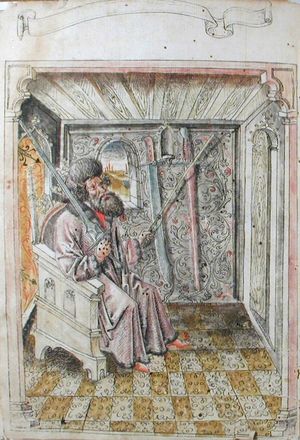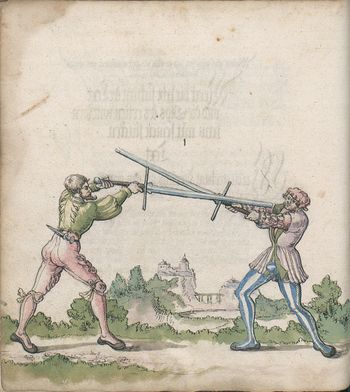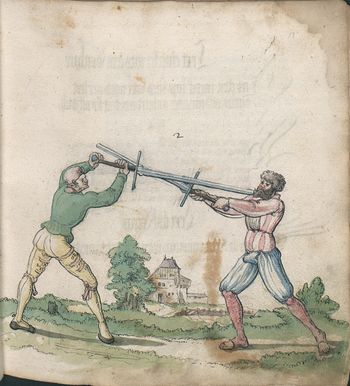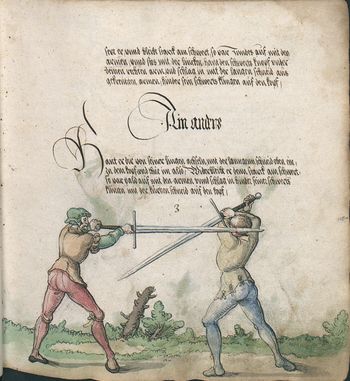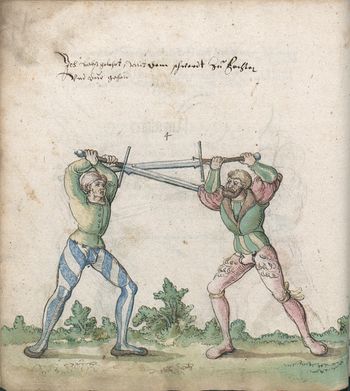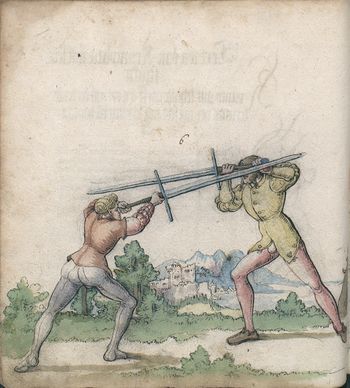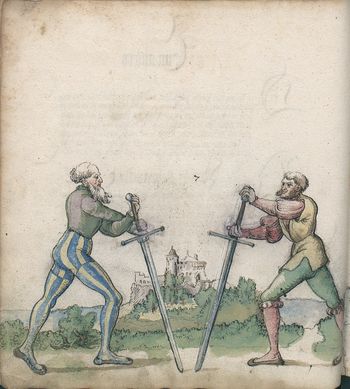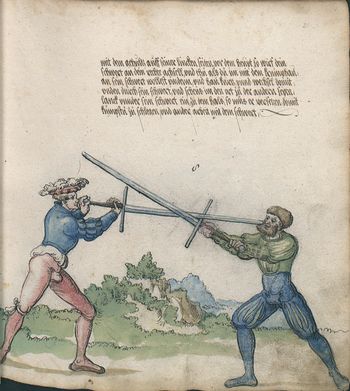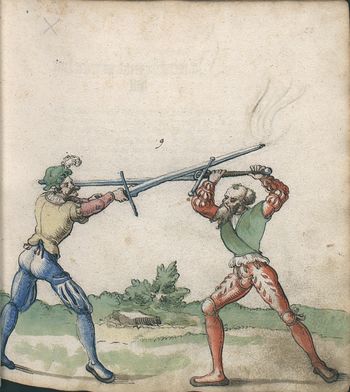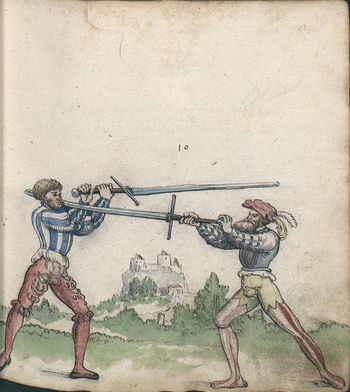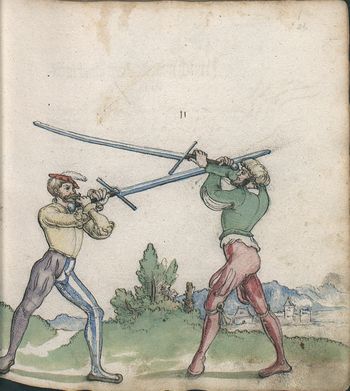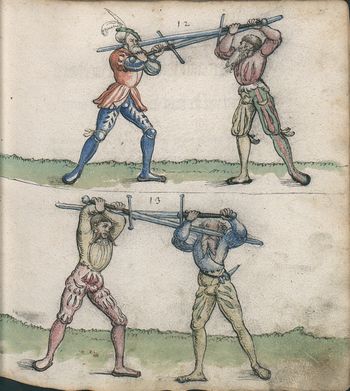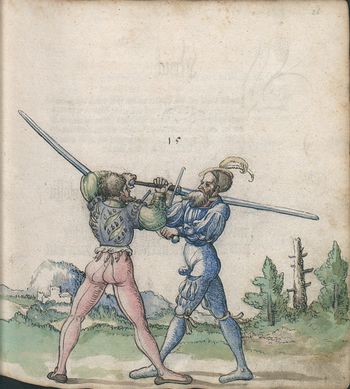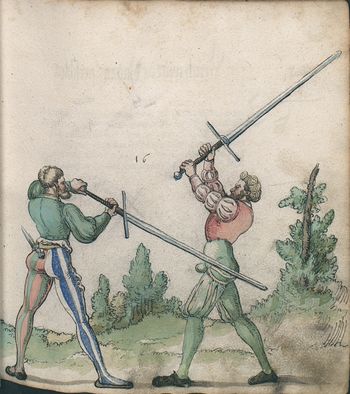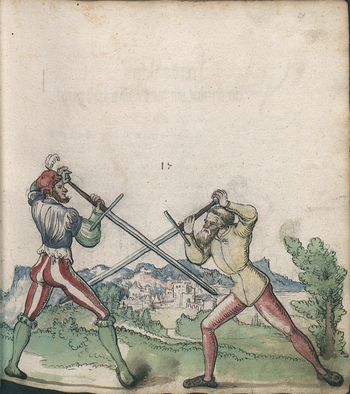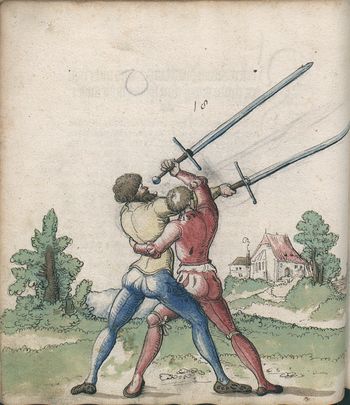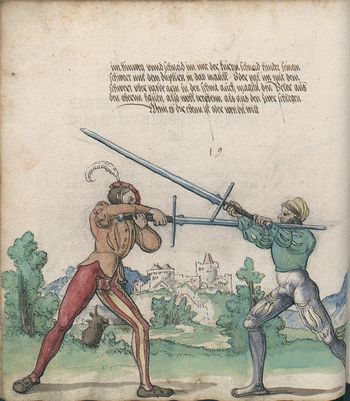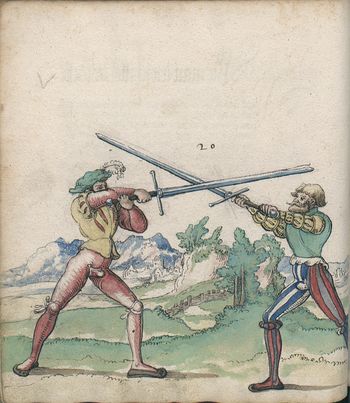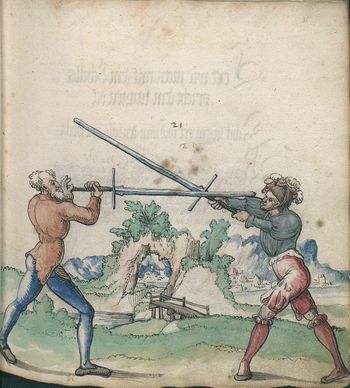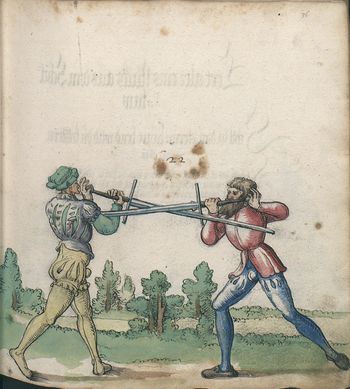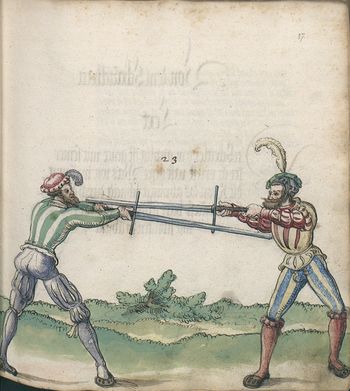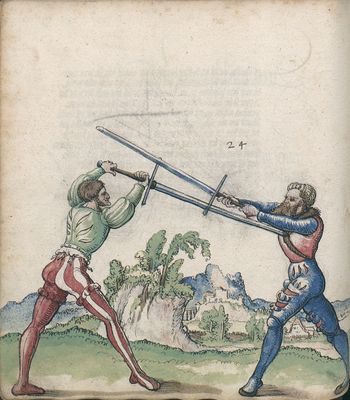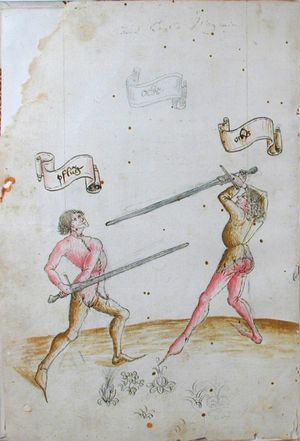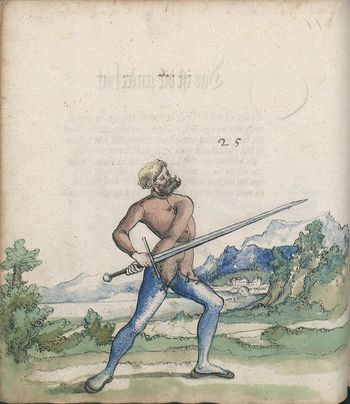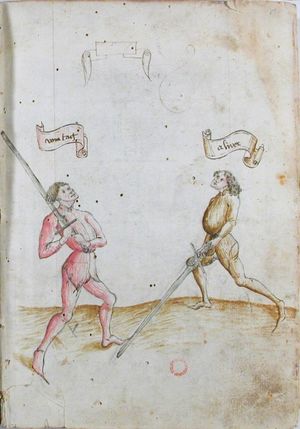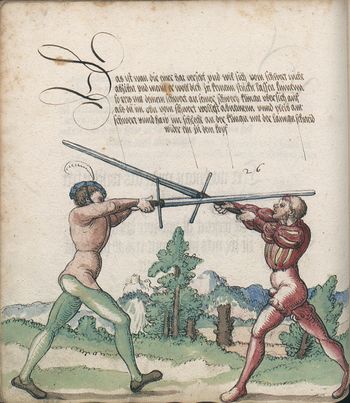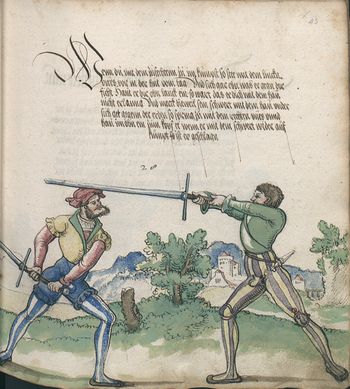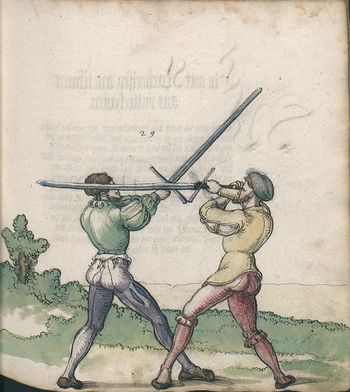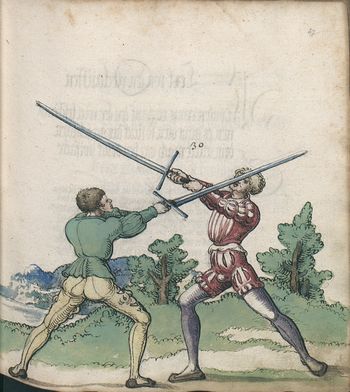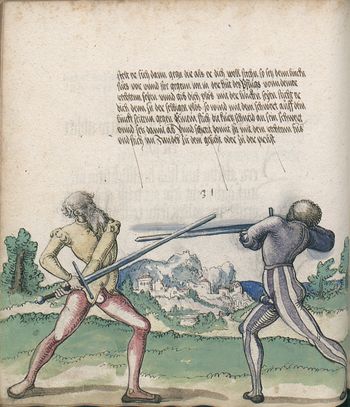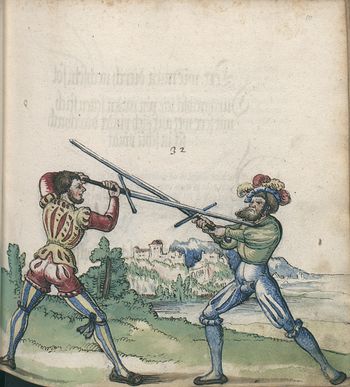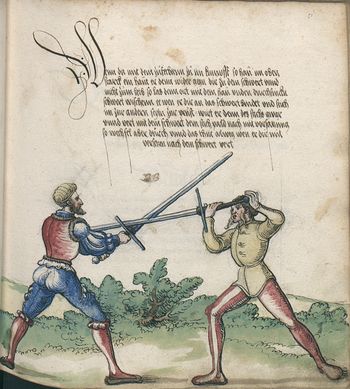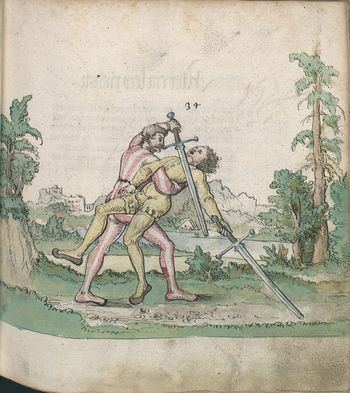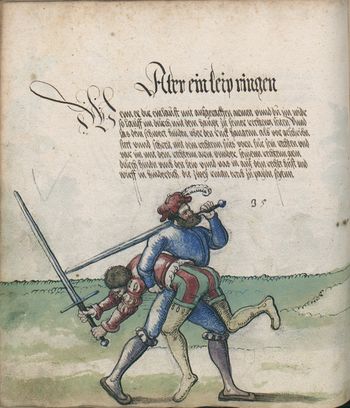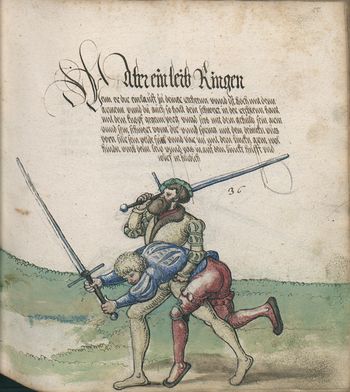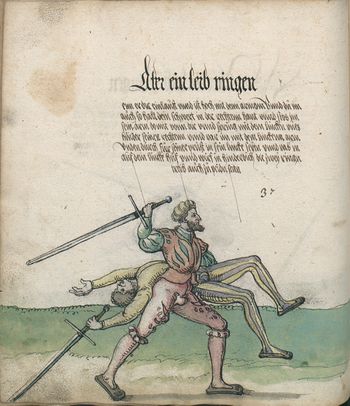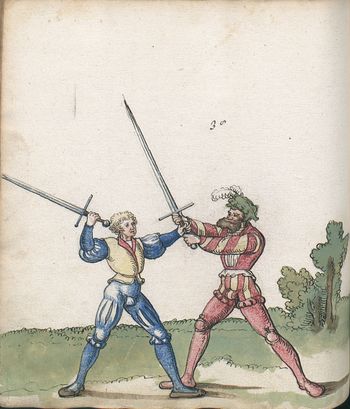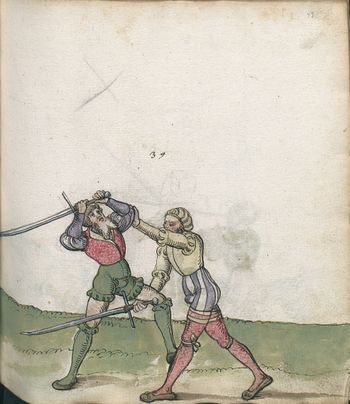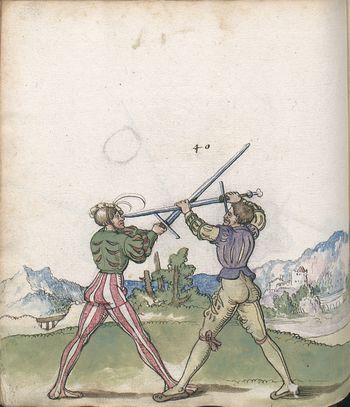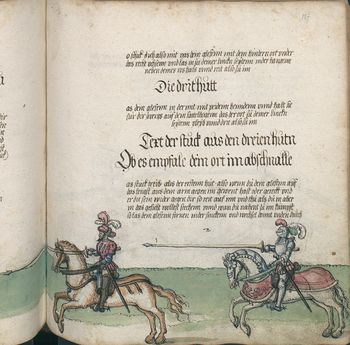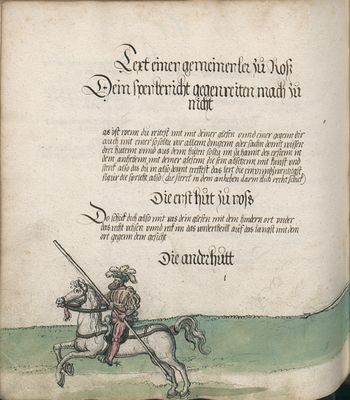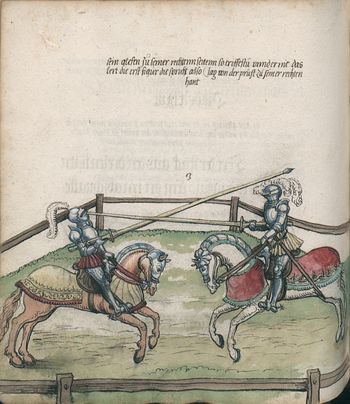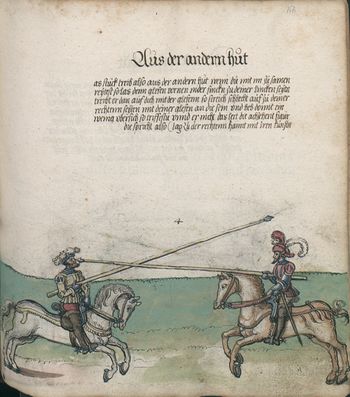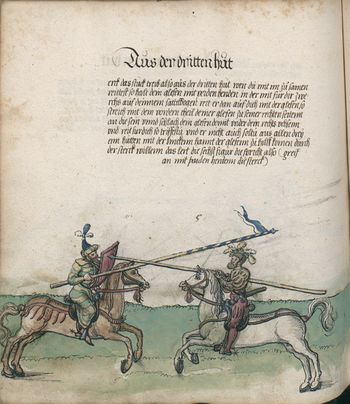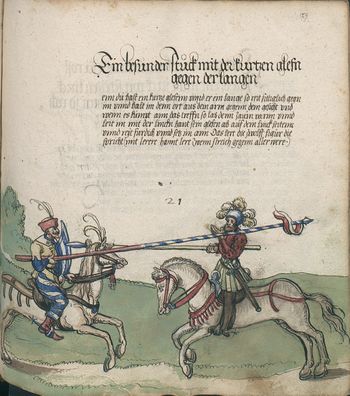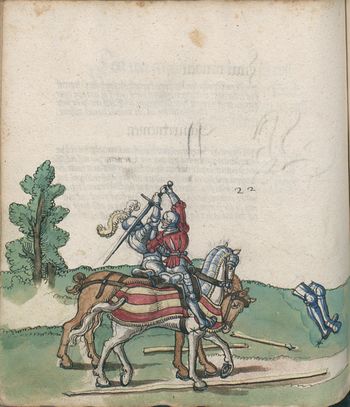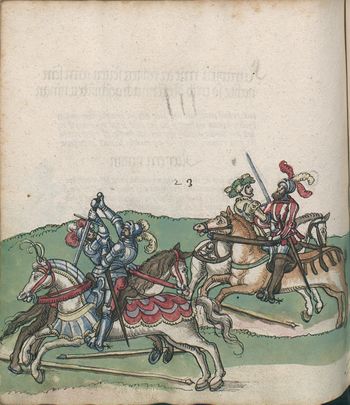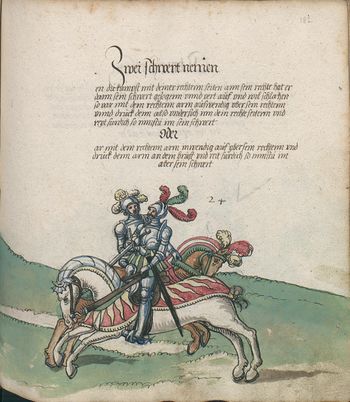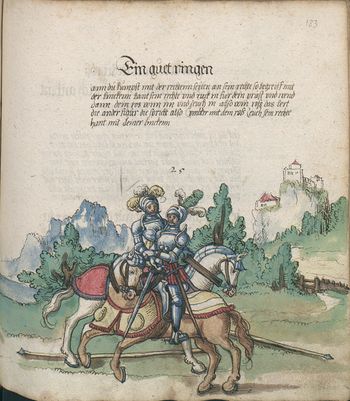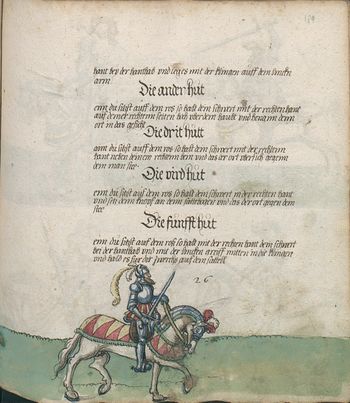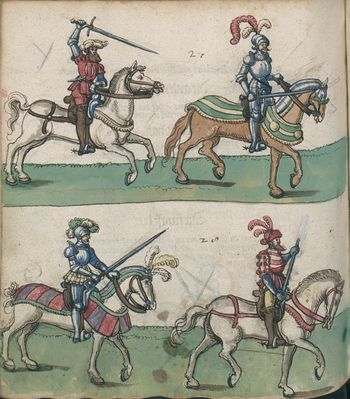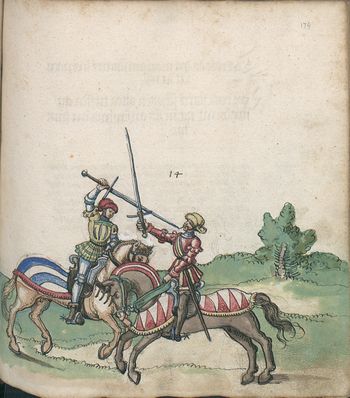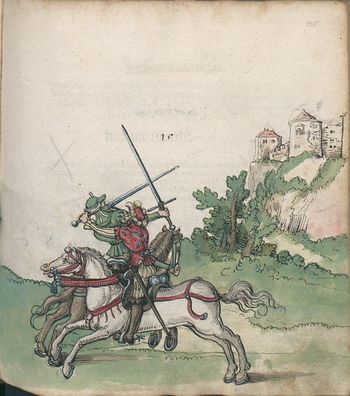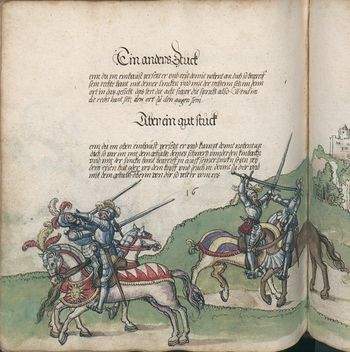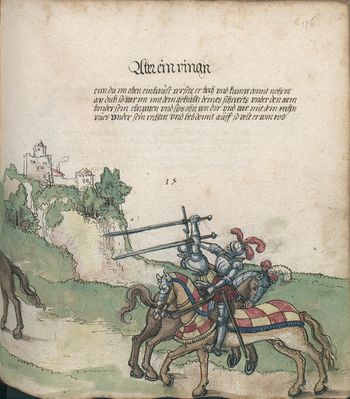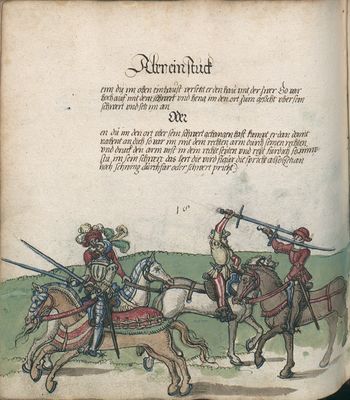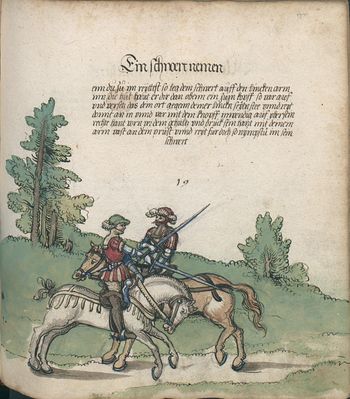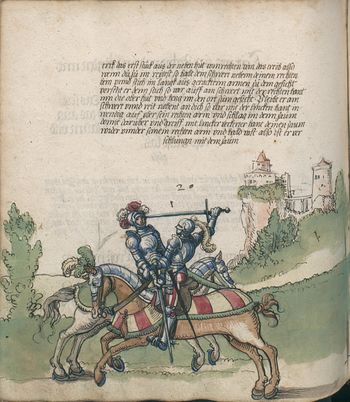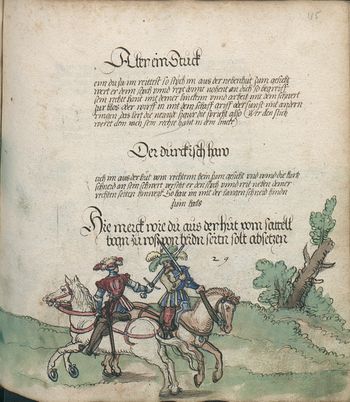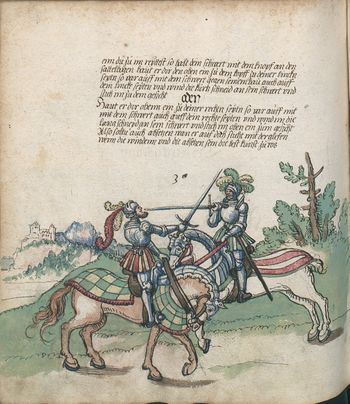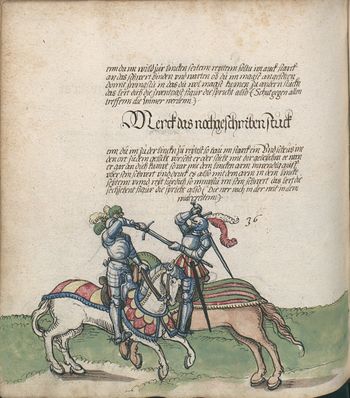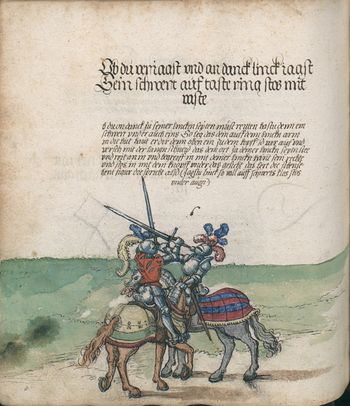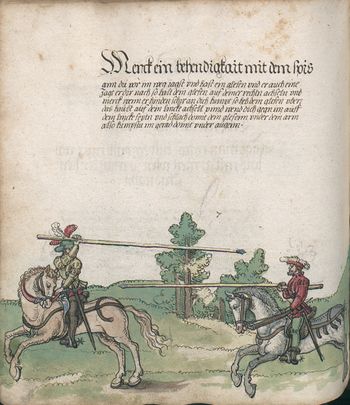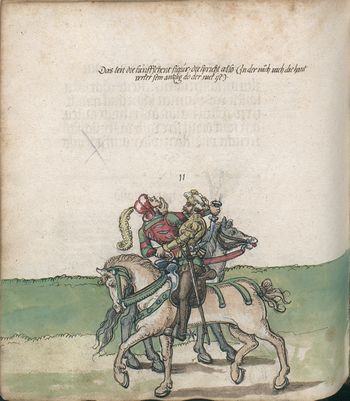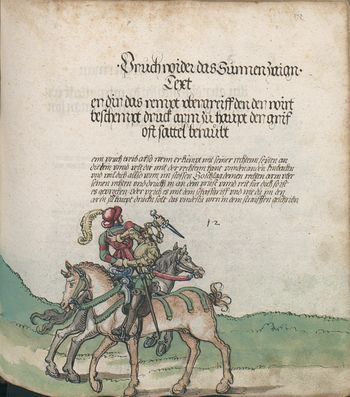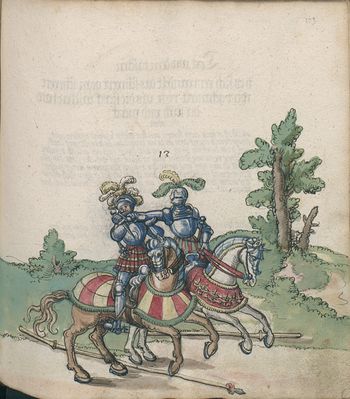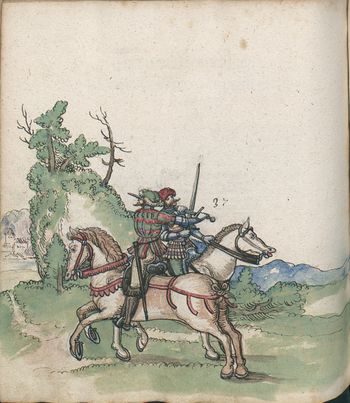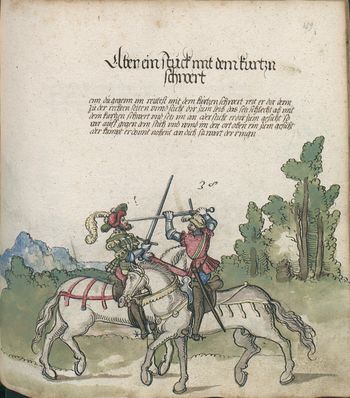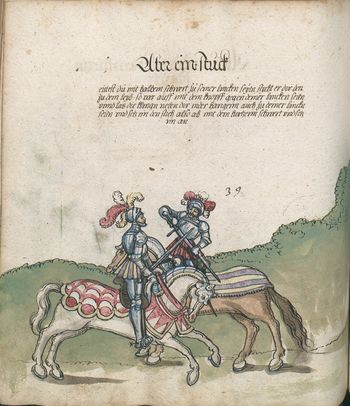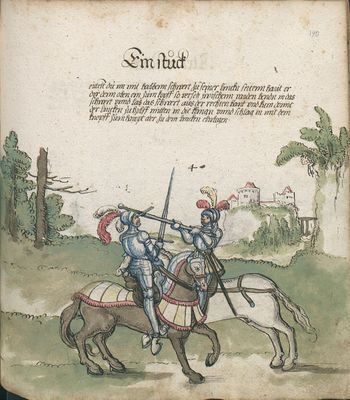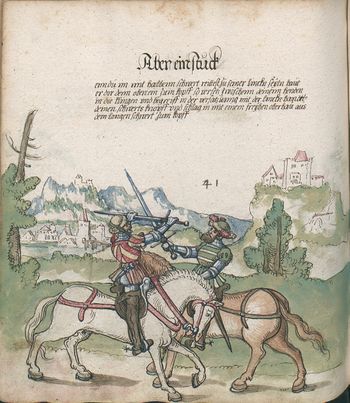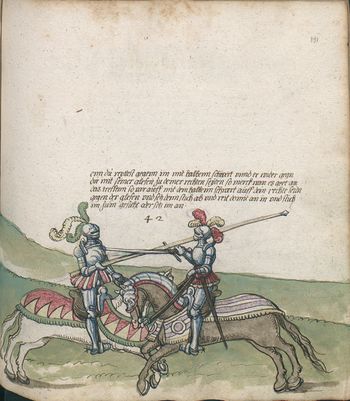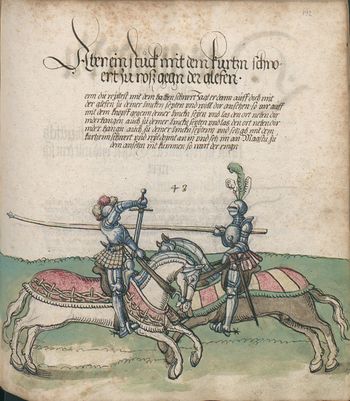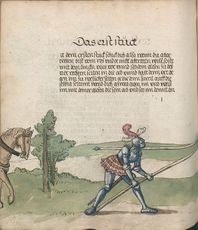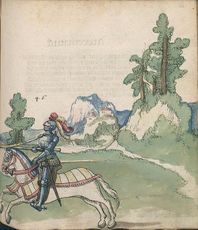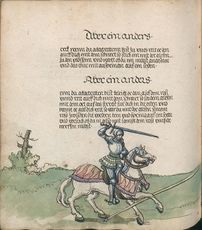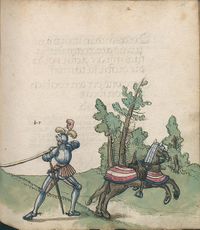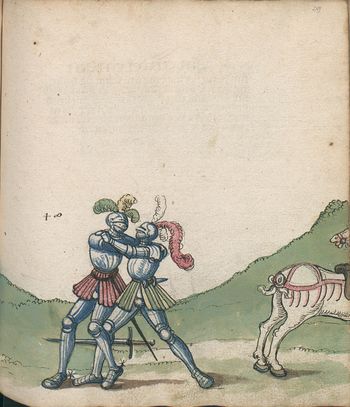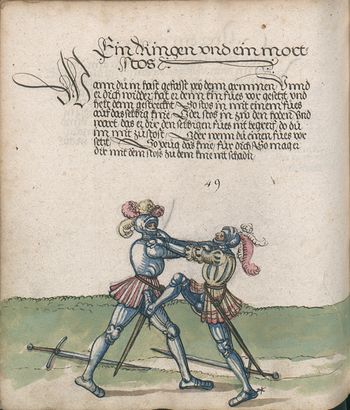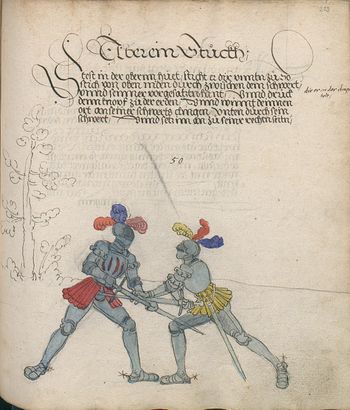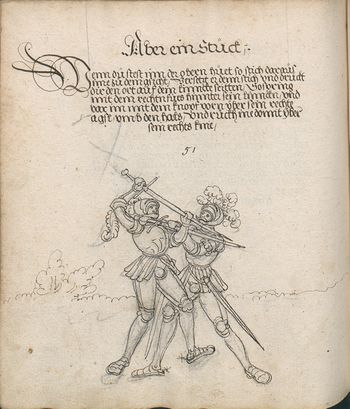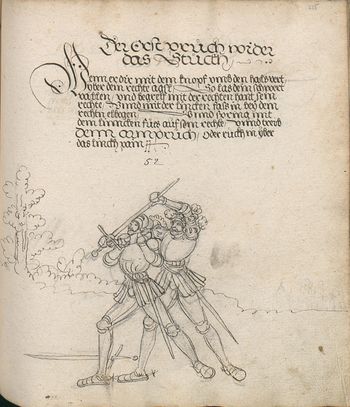|
|
You are not currently logged in. Are you accessing the unsecure (http) portal? Click here to switch to the secure portal. |
Difference between revisions of "Pseudo-Peter von Danzig"
| Line 2,345: | Line 2,345: | ||
|- | |- | ||
| − | | | + | | rowspan="2" | [[File:MS Germ.Quart.2020 186v.jpg|350px|center]] |
| <p>{{red|b=1|This is the text and the gloss of the plays to the left side}}</p> | | <p>{{red|b=1|This is the text and the gloss of the plays to the left side}}</p> | ||
{| class="zettel" | {| class="zettel" | ||
| Line 2,365: | Line 2,365: | ||
|- | |- | ||
| − | |||
| <p>{{red|b=1|Here note this play}}</p> | | <p>{{red|b=1|Here note this play}}</p> | ||
| Line 2,377: | Line 2,376: | ||
|- | |- | ||
| + | | | ||
| <p>{{red|b=1|Again a play}}</p> | | <p>{{red|b=1|Again a play}}</p> | ||
| Line 2,385: | Line 2,385: | ||
|- | |- | ||
| | | | ||
| − | | | + | | <p>{{red|b=1|This is the text and the gloss, if you r horse makes a fool out of you with violence}}</p> |
| + | {| class="zettel" | ||
| + | |- | ||
| + | | <small>23</small> | ||
| + | | {{red|Or turn around<br/> Lie to hunt the weapon}} | ||
| + | |- | ||
| + | | <small>24</small> | ||
| + | | {{red|With all art<br/> He hunts, he sends, for his benefit}} | ||
| + | |} | ||
| + | <p>Gloss: Note, this is a lesson, if your horse makes a fool out of you so that you would like to come to no plays, then don’t let your horse run far from him, therefore it will not become tired, and you also remain lying, and ride against him to the side which makes it good for you , which you may have your best advantage with all art.</p> | ||
| + | |||
| + | <p>{{red|b=1|The 14th figure teaches this,}} which says “Otherwise turn around, there the horse hurries back.”</p> | ||
| {{section|Page:Cod.44.A.8 047v.jpg|3|lbl=-}} | | {{section|Page:Cod.44.A.8 047v.jpg|3|lbl=-}} | ||
| | | | ||
| Line 2,391: | Line 2,402: | ||
|- | |- | ||
| rowspan="2" | [[File:MS Germ.Quart.2020 169v.jpg|350px|center]] | | rowspan="2" | [[File:MS Germ.Quart.2020 169v.jpg|350px|center]] | ||
| − | | | + | | <p>{{red|b=1|This is the text and the gloss, if you have no choice but to ride to his left side}}</p> |
| + | {| class="zettel" | ||
| + | |- | ||
| + | | <small>25</small> | ||
| + | | {{red|If you are hunted<br/> And hunted left against your will}} | ||
| + | |- | ||
| + | | <small>26</small> | ||
| + | | {{red|Feel for his sword<br/> Wrestle, shove with firmness}} | ||
| + | |} | ||
| + | <p>Gloss: Note, this is if you have no choice but to ride to his left side, if you then have a sword, and he also has one, then lay yours on the left arm in the guard. If he then hews in above to the head, then rise and parry with the long edge so that your point stands to your left side, and ride to him, and grab his right hand with your left, and shove him with the pommel under the face.</p> | ||
| + | |||
| + | <p>{{red|b=1|The 17th figure teaches this,}} which says “If you hunt left, then fall upon sword’s pommel, shove under eyes.”</p> | ||
| | | | ||
{{section|Page:Cod.44.A.8 047v.jpg|4|lbl=-|p=1}} {{section|Page:Cod.44.A.8 048r.jpg|1|lbl=48r|p=1}} | {{section|Page:Cod.44.A.8 047v.jpg|4|lbl=-|p=1}} {{section|Page:Cod.44.A.8 048r.jpg|1|lbl=48r|p=1}} | ||
| Line 2,397: | Line 2,419: | ||
|- | |- | ||
| − | | | + | | <p>{{red|b=1|Again a play}}</p> |
| + | |||
| + | <p>Note, when you ride to his left side, lie your sword onto your left arm in the guard. If he then hews in above to the head, then parry with the long edge, and hew a free over hew to his head from the parry.</p> | ||
| {{section|Page:Cod.44.A.8 048r.jpg|2|lbl=-}} | | {{section|Page:Cod.44.A.8 048r.jpg|2|lbl=-}} | ||
| | | | ||
| Line 2,403: | Line 2,427: | ||
|- | |- | ||
| | | | ||
| − | | | + | | <p>{{red|b=1|This is the text and the gloss about the set-aside behind}}</p> |
| + | {| class="zettel" | ||
| + | |- | ||
| + | | <small>27</small> | ||
| + | | {{red|If one hunts to the right<br/> Half turn around, wait for fencing}} | ||
| + | |- | ||
| + | | <small>28</small> | ||
| + | | {{red|Catching with arms<br/> So no harm may approach you}} | ||
| + | |} | ||
| + | <p>Gloss: Note, this is a lesson: If it is the case that someone has won your back, or otherwise comes to you behind, whether it was with a spear or with a sword, then note, if he wants to plant to your right side behind, then turn yourself away from the stab onto your left, or if he plants behind to your left side, then turn yourself away from the stab against him onto your right side, and ride with it to him and work with the sword or with the wrestling.</p> | ||
| + | |||
| + | <p>{{red|b=1|The 24th figure teaches this,}} which says “If one hunts you from<ref>Other one says "too".</ref> both sides, turn around left so he comes right.”</p> | ||
| | | | ||
{{section|Page:Cod.44.A.8 048r.jpg|3|lbl=-|p=1}} {{section|Page:Cod.44.A.8 048v.jpg|1|lbl=48v|p=1}} | {{section|Page:Cod.44.A.8 048r.jpg|3|lbl=-|p=1}} {{section|Page:Cod.44.A.8 048v.jpg|1|lbl=48v|p=1}} | ||
| Line 2,410: | Line 2,445: | ||
|- | |- | ||
| rowspan="2" | [[File:MS Germ.Quart.2020 170v.jpg|350px|center]] | | rowspan="2" | [[File:MS Germ.Quart.2020 170v.jpg|350px|center]] | ||
| − | | | + | | <p>{{red|b=1|Note, a nimbleness with the spear}}</p> |
| + | |||
| + | <p>Note, when you hunt away before him, and have a lance, and he also has one, if he then hunts after you, then hold your lance on your right shoulder, and note when he almost comes to you behind, then raise your lance over the head onto your left shoulder, and turn yourself against him onto your left side, and strike his lance with it under your arm. Therefore you come to him with it turned under eyes.</p> | ||
| {{section|Page:Cod.44.A.8 048v.jpg|2|lbl=-}} | | {{section|Page:Cod.44.A.8 048v.jpg|2|lbl=-}} | ||
| | | | ||
|- | |- | ||
| − | | | + | | <p>{{red|b=1|Note, sword against the spear}}</p> |
| + | |||
| + | <p>When you have a sword and he a lance, then lay your sword on the left arm in the guard. If he then rides onto you with the lance to your left side, then ride boldly against him, and when he comes to the hit, rise with the pommel and leave the blade in the hand against your left side, and set his lance aside with it.</p> | ||
| {{section|Page:Cod.44.A.8 048v.jpg|3|lbl=-}} | | {{section|Page:Cod.44.A.8 048v.jpg|3|lbl=-}} | ||
| | | | ||
| Line 2,421: | Line 2,460: | ||
|- | |- | ||
| | | | ||
| − | | | + | | <p>Or, if he rides to your right side, then sweep up simply with the sword to his lance to his right side, and rise into the upper hanging, and plant to him in the face.</p> |
| | | | ||
{{section|Page:Cod.44.A.8 048v.jpg|4|lbl=-|p=1}} {{section|Page:Cod.44.A.8 049r.jpg|1|lbl=49r|p=1}} | {{section|Page:Cod.44.A.8 048v.jpg|4|lbl=-|p=1}} {{section|Page:Cod.44.A.8 049r.jpg|1|lbl=49r|p=1}} | ||
| Line 2,428: | Line 2,467: | ||
|- | |- | ||
| | | | ||
| − | | | + | | <p>{{red|b=1|This is the text and the gloss about the sword taking}}</p> |
| + | {| class="zettel" | ||
| + | |- | ||
| + | | <small>29</small> | ||
| + | | {{red|The knife taking<br/> Learn to keep without shame}} | ||
| + | |} | ||
| + | <p>Gloss: Note, when you ride to him and come to him with your right side to his, then hew in above strong to the head, and stab to his face. If he parries the stab, then hurry to him and grab his right arm with left inverted hand in front under his pommel, and hold him firmly as such, and bend your left arm outwards at the handle of his sword, so he must let go of the sword. Thereafter you may hold him with the one hand and strike with the other.</p> | ||
| + | |||
| + | <p>{{red|b=1|The 15th figure teaches this,}} which says “Think about the knife taking and keeping, etc.”</p> | ||
| {{section|Page:Cod.44.A.8 049r.jpg|2|lbl=-}} | | {{section|Page:Cod.44.A.8 049r.jpg|2|lbl=-}} | ||
| | | | ||
Revision as of 01:13, 8 May 2018
| Gloss and Interpretation of the Recital on the Long Sword | |
|---|---|
| die gloss und die auslegung der zettel des langen schwerts | |
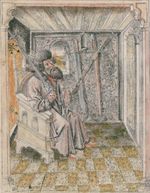
| |
| Author(s) | Unknown |
| Ascribed to | Pseudo-Peter von Danzig |
| Illustrated by | Unknown |
| Date | before 1452 |
| Genre | |
| Language | Early New High German |
| State of Existence | Original hypothetical; multiple branches exist |
| Principal Manuscript(s) |
Cod. 44.A.8 (1452) |
| Manuscript(s) |
|
| First Printed English Edition |
Tobler, 2010 |
| Concordance by | Michael Chidester |
| Translations | |
 |
Caution: Scribes at Work This article is in the process of updates, expansion, or major restructuring. Please forgive any broken features or formatting errors while these changes are underway. To help avoid edit conflicts, please do not edit this page while this message is displayed. Stay tuned for the announcement of the revised content! This article was last edited by Michael Chidester (talk| contribs) at 01:13, 8 May 2018 (UTC). (Update) |
"Pseudo-Peter von Danzig" is the name given to an anonymous late 14th or early 15th century German fencing master.[1] Some time before the creation of the Codex 44.A.8 in 1452, he authored a gloss of Johannes Liechtenauer's Recital (Zettel) which would go on to become the most widespread in the tradition. While the identity of the glossator remains unknown, it is possible that he was in fact Jud Lew or Sigmund ain Ringeck, both of whose glosses show strong similarities to the work. On the other hand, the introduction to the Rome version of the text could be construed as attributing it to Liechtenauer himself.
Contents
Stemma
Early on in its history, the Pseudo-Peter von Danzig gloss seems to have split into two or three primary branches, and no definite copies of the unaltered original are known to survive. The gloss of Sigmund ain Ringeck also seems to be related to this work, due to the considerable overlap in text and contents, but it is currently unclear if Ringeck's gloss is based on that of pseudo-Danzig or if they both derive from an even earlier original gloss (or even if Ringeck and pseudo-Danzig are the same author and the "Ringeck" gloss should be considered Branch D).
Branch A, first attested in the Augsburg version (1450s) and comprising the majority of extant copies, has more devices overall than Branch B but generally shorter descriptions in areas of overlap. It also glosses only Liechtenauer's Recital on long sword and mounted fencing; in lieu of a gloss of Liechtenauer's short sword, it is generally accompanied by the short sword teachings of Andre Liegniczer and Martin Huntfeltz (or, in the case of the 1512 Vienna II, Ringeck's short sword gloss). Apart from the Augsburg, the other principal text in Branch A is the Salzburg version (1491), which was copied independently[2] and also incorporates ten paragraphs from Ringeck's gloss and twenty from an unidentified third source. Branch A was redacted by Paulus Hector Mair (three mss., 1540s), Lienhart Sollinger (1556), and Joachim Meyer (1570), which despite being the latest is the cleanest extant version and was likely either copied directly from the original or created by comparing multiple versions to correct their errors. It was also one of the bases for Johannes Lecküchner's gloss on the Messer in the late 1470s.
Branch B, attested first in the Rome version (1452), is found in only four manuscripts; it tends to feature slightly longer descriptions than Branch A, but includes fewer devices overall. Branch B glosses Liechtenauer's entire Recital, including the short sword section, and may therefore be considered more complete than Branch A; it also differs from Branch A in that three of the four known copies are illustrated to some extent, where none in the other branch are. The Krakow version (1510-20) seems to be an incomplete (though extensively illustrated) copy taken from the Rome,[3] while Augsburg II (1564) collects only the six illustrated wrestling devices from the Krakow. Even more anomalous is the Glasgow version (1508), consisting solely of a nearly complete redaction of the short sword gloss (assigning it to Branch B), which is appended to the opening paragraphs of Ringeck's gloss of the same section; since it accompanies Ringeck's long sword and mounted fencing glosses, a possible explanation is that the scribe lacked a complete copy of Ringeck and tried to fill in the deficit with another similar text.
A Branch C might be said to exist as well, first attested in the Vienna version (1480s), though it is unclear whether it was derived independently from the original, represents an intermediate evolutionary step between Branches A and B, or was created by simply merging copies of the other branches together. The structure and contents of this branch very closely align with Branch B, lacking most of the unique devices of Branch A and including the gloss of the short sword, but the actual text is more consistent with that of Branch A. A fragment of Branch C appears in the writings of Jörg Wilhalm Hutter (several mss., 1520s), though Glasgow II (1533) assigns the fragment a much earlier origin, stating that it was devised by one Nicolaüs in 1489.
Finally, there is one version of the Pseudo-Peter von Danzig gloss that defies categorization into any branch, namely the one that Mair created based on papers purchased from the estate of Antonius Rast. This gloss is a chimeric abomination, combining text from all three branches in an apparently-arbitrary sequence, and then concluding with the final eighteen paragraphs of Ringeck.
While all branches were originally presented in a single concordance in this article, the differences between them were revealed thereby to be extensive enough that they merit separate consideration. Thus, Branch A has been placed on the page of Jud Lew, to whom is seemingly attributed the gloss on mounted fencing, while Branch B has been retained here. Branch C will be placed on another page in the future.
Treatise
Images |
Rome Transcription (1452) |
Krakow Transcription (1510-20) |
Augsburg Transcription (1564) | |||||||||||||||||
|---|---|---|---|---|---|---|---|---|---|---|---|---|---|---|---|---|---|---|---|---|
[1] Here begins the gloss and the interpretation of the Epitome on the Long Sword This has been composed and created by Johannes Liechtenauer, the one High Master in the Art, may God be gracious to him, so that princes, lords, knights, and soldiers shall know and learn that which pertains to the Art. Therefore he has allowed the Epitome to be written with secret and suspicious words, so that not every man shall undertake and understand them. And he has done that so the Epitome’s Art will little concern the reckless Fencing Masters, so that from those same Masters his Art is not openly presented, nor shall it become common. And the same secret and suspicious words of the Epitome which stand hereafter, the glosses teach and explain thus, so that everyone who otherwise can fence may well undertake and understand them. |
[9v] ·:~Alhÿe hebt sich an die Glos vnd die auslegu~g der zedel des langen swertz Die gedicht vnd gemacht hat Johannes liechtenauer der ein hoher maister in der kunst gewesen ist dem got genädig sey vnd dar vmb das die kunst fürsten vnd herren Ritt° vnd knechten zu° gehört das sÿ die wissen vnd lernen sullen Dar vmb hat er sÿ lassñ schreiben mit verporgen vnd verdachten worten das sÿ ÿeder man nicht vernemen vnd versten sol vnd hat das getan durch der leichtfertigen schirmaister willen die ir kunst gering wegen das von den selbigen maisterñ sein kunst nicht geoffenwart noch gemein solt werden vnd die selbigen verporgen vnd verdackten wort der zedel die stenn hernach in der glosen Also verklert vnd aus gelegt das sÿ ydermann wol vernemen vnd versten mag der do anders fechten kan |
[7r] Volgt die außlegung ÿber geschribnen Text der Zetl &c |
||||||||||||||||||
[2] Here mark what the red writing is in the beginning of the techniques described hereafter: it is the text of secret words of the Epitome of the Long Sword. And always the black script after it is the gloss and the explanation of the secret and suspicious words of the Epitome. |
Hÿe merck eben auff was im anfang der hernachgeschriben stuck mit rot geschribñ ist das ist der text der verporgen wort der zedel des langen swertz vnd albeg die nachst swartz geschribñ schrifft das ist die glos vnd die aus legu~g der verporgen vnd verdachten wort der zedel |
|||||||||||||||||||
[3] This is the preface:
|
Das Ist die vor red [10r] ☹ Junck ritter lere |
|||||||||||||||||||
[4] This is a general lesson of the Long Sword in which very fine Art is held: Text
Gloss: Mark, that is the first art of the Long Sword, that you shall learn the hews correctly before all things, so that you will otherwise fence strongly, and undertake that thus: When you stand with your left foot before and hew from your right side, if you do not follow after the hew with a step forward of your right foot, then the hew is false and incorrect. When your right side remains behind, the hew becomes too short thereby and may not have its correct path downwards to the other side before the left foot. |
Das ist ein gemaine ler des langen swertz das In vil gutter kunst begriffen ist Text Wiltu kunst schauen Glosa Merck das ist die erst kunst des langenn swertz Das du vor allen dingen die häw solt lernen gerecht hawen ist das du anders starck vechten wilt vnd das ver nÿm also wenn dw mit dem lincken fues vor stest vnd haust vor deiner rechten seittñ volgstu dann dem haw nicht nach mit deinem zu° trit deins rechten fuess So ist der haw valsch vnd vngerecht wenn dein rechte seitt die pleibt da hinden dar vmb wirt der haw zu° kurtz vnd mag seinen rechten gangk zu° der anderñ seitten vor dem lincken fuess vndersich nicht gehaben |
[7v] Text Wiltu kunst schauen, Merckh das ist die erst kunnst des lanngen schwerts, Das du vor allenn dinngen, die hew sollt lerrnnen gerecht hauen, ist das du annders starck vechtenn wilt, Unnd das vernim also, Wen du mit dem linckn fues vor steest, unnd hawst von dainer rechtenn seytenn, volgstu dann dem haw nicht nach, mit deinem Zutrit, deins rechtn fueß, so ist der hau falsch, unnd ungerecht, Wenn dein rechte seit pleybt da hindenn, dar umb wirt der haw zu kurtz, unnd mag seinenn seinenn rechtenn gangk zu der andern seytenn, vor dem linckenn fues unndersich nicht gehabenn, |
||||||||||||||||||
[5] Or, if you stand with your right foot before and hew from the left side, and you do not follow after the hew with your left foot, then the hew is still false. Therefore mark when you hew from the right side that you always follow after the hew. Do also likewise the same when you hew from the left side. So put your body therewith correctly in the balance, and thus the hews become long and hewn correctly.[4] |
Oder Stestu mit dem rechten fuess vor vnd haust von der lincken [10v] seytten volgstu denn mit dem lincken fuess dem haw auch nicht nach So ist der haw aber valsch Dar vmb so merck wenn dw haust von der rechten seÿten das thue albeg mit dem rechten fuess dem haw nach volgest Des selben geleichen tüe auch wenn du haust von der lincken seitten So gibt sich dein leib do mit recht in die wag Also werden dÿ häw lanck vnd gerecht gehauen ~ |
also das widerspill, vonn der linncken seitn, Auch soll albeg hau unnd trit miteinannder gleich geschehen. |
||||||||||||||||||
[6] This is the text and the gloss of yet a lesson:
Gloss: This is when you come to him with the pre-fencing: then you shall not stand still and look after his hews, waiting for what he fences against you. Know that all fencers that look and wait on another’s hews and will do nothing other than parrying deserve such very little joy in their art, since they are destroyed and become struck thereby. |
Das ist der text vnd die glos aber von ainer ler Wer nach get hawen Glosa das ist wenn du mit dem zu° vechtñ zu° im kumpst So soltu nicht still sten vnd auff sein häw sehen noch warten was er gegen dir vicht wist das alle vechter dye do sehen vnd warten auff eins anderñ häw vnd wollen anders nicht thuen wenn vor setzen die bedürffen sich solicher kunst gar wenig fräwen wenn sÿ ist vernicht vnd weerden do pey geslagen |
Text einr ler [8r] Wer nach get hauen glosa Das ist wen du mit dem zu fechtenn zu im kumpst, so soltn nicht still sten, und auff sein haw sehen noch wartn, was er gegen dir ficht, Wis das alle vechter, die do sehen und warten, auff aines andern hau, und wollen anders nicht thon wen vorsetzen, die bedurffen sich sollicher kunst gar wenig freüwen, wenn sie ist vernicht, unnd werdenn do pei geschlagen &c |
||||||||||||||||||
[7] This is the text and the gloss of yet a lesson:
Gloss: Mark, that is when you come to him with the pre-fencing: what you will then fence, drive it with the entire strength of your body, and hew in therewith near to the head and to the body, and remain with your point in before his face or the breast so he cannot Change-through before your point. If he parries with strength and lets the point go out from you on the side, then give him a Lighter-hit[5] on the arm. |
Das ist der text vnd die glos aber von ein° lere Haw nahent was du wilt [11r] Glosa Merck das ist wenn du mit dem zu vechten zu Im kumpst was du den vechten wild das treib mit gantz° sterck des leibs vnd häw im do mit nahent ein zu° kopf vnd zu leib vnd pleib im mit dem ort fur dem gesicht oder der prüst so kan er fur dem ort nicht durch gewechselñ vor setzt er mit sterck vnd lest denn ort von dir aus gen auff dÿ seittñ So gib im ein zeck rür auf den arm~ |
Text Hau nohent was du wilt glosa Wen du mit dem zu vechtenn zu im kompst, was du dann fechtenn wildt, das treyb mit gantzer, sterckh des leibs, unnd haw im domit nahet ein zu kopf, unnd zu leib, Unnd beleib ime mit dem ort vor dem gesicht oder brust, So kann er vor deinnem ort nit durchwechsln [8v] Versetzt er mit sterckh, unnd lest den ort von dir ausgeen, auf die seittn, So gib ime einn zeckhrur auf denn arm. ~ |
||||||||||||||||||
[8] Or, if he drives high up with his arms with the parrying, then strike him with a free hew below to the body, and step quickly backward therewith, so he is struck before he comes in. |
Oder vert er mit der vorsatzu~g hoch auff mit den armen So slach im mit einem freÿen haw vnden zu° dem leib vnd trit pald do mit zu° ruck So ist er geslagen ee wenn er sein Inn wirt |
Oder vert er mit der versatzung hoch auff, mit den armen, so schlach im mit ainem freyenn haw unnden zu dem leib, und trit bald domit zu ruckh, So ist er geschlagenn, ee wenn er sein inn wirt. |
||||||||||||||||||
[9] This is the text and the gloss of yet another lesson:
Gloss: Mark, this is a lesson and touches upon two persons, a righty and a lefty, and is how you shall hew so that one does not win the Weak of your sword with the first hew, and undertake that thus: when you come to him with the pre-fencing, if you are then a righty, then do not hew the first hew with purpose from the left side, when he is Weak, and may not hold against therewith when he hews strongly in with you. So therefore hew from the right, so that you may well hold strongly against, and work what you will on the sword. |
Das ist der text vnd die glos Aber von einer ler Hör was da slecht ist Glosa Merck das ist ein ler vnd trift an zwo person Einem gerechten vnd einem lincken Vnd ist wie dw solt hauen das man dir die swech in dem swert mit dem ersten haw nicht an gewinn vnd das vernÿm also wenn du mit dem zu° vechten zu ÿm kumpst pistu denn gerecht so haw mit nameen den ersten haw nicht von der lincken seÿtten wenn er ist swach vnd magst [11v] da mit nicht wider gehalden wenn er mit dir starck ein haut Da von so haw von der rechten so magstu wol starck wider gehalten vnd am swert arbaitten was dw wild Des geleichen pistu linck So haw auch den ersten haw nicht von der rechten seitten wenn es ist einem lincken gar wild ku~st zu° treiben von der rechten seitten Des geleichen ist auch einem rechten von der lincken seitten ~ |
Text Hör was do schlecht ist glosa Dise ler trifft an zwo person, einen gerechten und einen gelincken, unnd ist wie du solt hauen, das man dir die schwech, in dem schwert mit dem ersten haw nicht angewin, Unnd das vernim also, wen du mit dem zufechten zu im kumpst, pistu dan gerecht, so haw mit namen den ersten haw nit von der lincken seyten, wen er ist schwach und magst domit nicht widergehaltenn, wen er mit dir starckh einhaut, Darumb so haw von der rechtenn so magstu wol starck widergehaltenn und am schwert arbeitenn, was du wild, Des gleichn pistu linckh so hau auch denn erstenn hau nicht vonn der rechtenn seyten. ~Wen es ist einem Linckenn ganz wild |
||||||||||||||||||
[10] Likewise, if you are a lefty, then also do not hew the first hew from the right side, since it is quite perilous for a lefty to practice Art from the right side, the same as it is also for a righty from the left side. |
Das ist dert text vnd die glos aber von einer ler Vor vnd nach dÿ tzwaÿ dinck Glosa Merck das ist das du vor allen sachen recht solt vernemen vnd ver sten dy tzwaÿ dinck Das ist das vor vnd das nach vnd dar nach swech vnd sterck des swertzs vnd des wortz inndes wenn dar aus get der gantz grunt aller kunst des fechtens wenn du die dinck recht vernÿmpst vñ verstest vnd dar zu° des wortz Inndes nicht vergist In allen stucken die dw treibest So pistu wol ein gueter maister des swertz vnd magst wol lernen fürsten vnd herren das sÿ mit rechter gunst des swertz wol mügen besten In kampff vnd in erñst |
[9r] kunst zu treybenn von der rechten seytenn, Des gleichn ist auch einem Rechten von der linckenn seÿten. |
||||||||||||||||||
[11] This is the text and the gloss of yet another lesson:
Gloss: Mark, this is that before all things you shall rightly undertake and understand these two things, which are the Before and the After, and thereafter the Weak and Strong of the sword, and then the word “Meanwhile”, whence comes the entire foundation of all the Art of Fencing. When you think on, undertake, and understand them rightly, and do not forget the word “Meanwhile” in all techniques that you drive, then you are a very good Master of the Sword and may teach princes and lords well, so that they may be best in combat and in earnest with the correct Art of the Sword. |
Hier merck was da haist das vor |
Text Vor und noch die zweÿ ding, glosa Du solt vor allenn sachen recht vernemen und versteen die zwaÿ ding. das ist das Vor und das Nach. unnd darnach schwech und sterck. des schwerts. und darnach des worts Indes. Wan daraus geet der gantz grunt aller kunst des fechtens. Wen du die ding recht vernimpst unnd versteest und darzu des worts Indes, nit vergist in allen stucken, die du treÿbst, So pistu wol ein guter maister, des schwertz, unnd magst wol lernen Fursten und Herzen, das sÿ mit rechter kunst des schwerts wol mogen besten, In kampff und in ernst. |
||||||||||||||||||
[12] Here mark what is there called the Before: This is that you shall always come Before (be it with the hew or with the stab) before he does. And when you come before with the hew or otherwise, then he must parry that, so work Meanwhile nimbly before yourself with the sword in the parrying, or otherwise with other techniques. Then he may come to no work. |
[12r] Das ist das du albeg solt vor kömen es seÿ mit dem haw oder mit dem stich ee wenn er vnd wenn du ee kumpst mit dem haw oder süst das er dir vor setzñ mües So arbait Inndes behentlich In der versatzung für dich mit dem swert oder sünst mit anderñ stucken So mag er zu° kainen arbait komen ~ |
Was das Vor seÿ Das ist das du vor solt kumen alweg, es sey mit dem hau oder mit dem stich, Ee wen er Und wenn du ehe kumpst mit dem haw oder sunst das er dir versetzen mus, So arbait Indes behendiglich in der versatzung fur dich mit dem schwert, oder sunst mit anndern stuckenn: so mag er zu kainer arbeit komen. |
||||||||||||||||||
[13] Here mark what is there called the After: The After are the breaks against all techniques and hews the opponent drives on you, and that undertake thus: When he comes Before with the hew, and you must parry him, then work Meanwhile with your parrying nimbly with the sword to the next opening. Then you break his Before with your After. |
Hye merck was da haist das nach Das nach das sind die prüch wider alle stuck vnd häw die man auff dich treibt vnd das vernÿm also wenn er ee ku~pt mit dem haw wenn du das im versetzen muest So arbait Inndes mit dein° vorsatzung behendlich mit dem swert zu° der nagsten plöss So prichstu ÿm sein vor mit deinem nach ~ |
Was das Noch seÿ. Ist der pruch wider alle stuck, und hew die mann auff dich treÿbt, Unnd das vernim also Wen er ee kumpt mit dem hau, wen du, das du im versetzen must, So arbait Inndes behendiglich zur nechsten plos, So prich=[6] im sein Vor, mit deinem Nach. |
||||||||||||||||||
[14] Here mark the Weak and the Strong of the sword: Understand the Weak and the Strong thus: On the sword from the hilt to the middle of the blade is the Strong of the sword, and further above the middle to the point is the Weak. (And how you shall work with the Strong of your sword after the Weak of his sword you will learn hereafter.) |
Hier merck die swech vnd die sterck des swertz Die swech vnd die sterck vernÿm also am swert von dem gehültz pis in die mitt der klingen so ist die sterck des swertz vnd fürpas vber die mitt pis an den ort ist die swech vnd wie du mit der sterck deines swertz nach der swech seins swertz arbaitten solt das wir dir hernach vorklert |
Von Schwech und sterck des Schwertz. Schwech und Sterckh vernim also, am schwert von dem gehultz pis in [10r] die mit der klingen, so ist die sterck des schwerts, Unnd fürpas über die mit piß an denn ort ist die schwech, Unnd wie du mit der sterck deines schwertz nach der schwech seines schwertz arbaiten solt das wirt dir hernach verklort. |
||||||||||||||||||
[15] This is the text and gloss of Five Hews:
Gloss: Mark, there are Five hidden Hews of which many Masters of the Sword know nothing to say; these Hews you shall learn correctly from the right side. Whichever fencer, whom you then hew with correct Art, that can break these without injury, will be praised by other Masters, so that his Art shall become rewarded more than other fencers. And how one shall hew the Hews with their techniques, that will be clarified to you hereafter. |
Das ist der text von funff häwen vnd die glos [12v] ffünff häw lere Glosa Merck es sind fünff verporgen häw do vil maister des swertz nichtz von wissen zu° sagen die soltu von der rechten seitten recht lernen hawen wellich vechter dir denn die haw mit rechter kunst an schaden prechen kan dem wirt gelobt von anderñ maisterñ das ym seiner kunst pas gelont sol werden denn einem andern vechter vnd wie man die häw mit irñ stucken hawen sol das wirt dir hernach vor klert warden |
Text der funff heü Funff haw lere Es seind funff verporgen haw, do von vil Mayster des schwertz nicht von wissen zu sagen, Die soltu von der rechtenn seyten recht lernen hawen, Wellicher fechter dir den die hau mit rechter kunst an schaden prechn kan, der wirt gelobt von andern maistern, das im pas gelont sol werden seyner kunst, den ainem andern vechter, Und wie man die haw mit iren stuckenn hauen soll, das wirt dir hernach verklort werdenn. |
||||||||||||||||||
[16] This is the text and the gloss of techniques of the Epitome:
Gloss: Mark, here have become named to you the right Chief Techniques of the Epitome on the Long Sword (how they are each called particularly by their names), so that you can remember and recall them all the better. |
Das ist der text vnd die glos von stucken der zedel Zorñ häw krumpp twer Glosa ·M·erck hie werdent dir genant die rechten hauppt stuck der zedel des langen swertz wie sie haissen iglichs besunder mit seine~ namen dar vmb das du sÿ dester pas erkennen vñ vorsten kündest Das erst das sind die fünff häw wie die besunder genant sein Item Der erst haist der zorenhaw |
Text von stucken der
zetl [10v] Zornha[!], Krump, Twer, glosa Hie werdent dir genant die rechten hauptstuck des Zedel des Lanngn Schwerts.
wie sie haisenn. yglichs besunder mit seinem naman[!]. darumb das du sie
dester pas erkennen und versten kundest. Das erst seind die funff haw wie
sie besunder genant seind. Der erst haist der :Zornhau: |
||||||||||||||||||
The first are the Five Hews, and how they are particularly named: Item: The first is called the Wrath-hew. |
Nu merck die stuck |
~ Nun mergkh die stuckh, Das erst
sein die vier Huet, |
||||||||||||||||||
[17] Now mark the techniques: Item: The first, they are the Four Guards. |
[13r] ☞ Das erst das sein die vier hu°tten ~ |
~Und was du aus den stuckn fechten solt, und wie du dich mit den Hengen und |
||||||||||||||||||
[18] And what you shall fence from the techniques, and how you shall give openings with the Hangings and Windings, you will thus find described hereafter, one after another to the next. |
Vnd was du aus den stucken fechten solt vnd wie du dich mit den hengen vnd winden ploß gebñ solt Das wirstu also nach ein ander am nagstñ hernach geschriben vinden |
[11r] Winden plos geben solt, das wirstu als nach ainanderr am negsten hernach geschriben vinden. |
||||||||||||||||||
[19] Mark. Here begins the text and the gloss. First, of the Wrath-hew with its techniques: Text
Gloss: Mark, the Wrath-hew breaks all Over-hews with the point, and yet is nothing other than a simple peasant strike, and drive it thus: When you come to him with the pre-fencing, if he then hews at your head from above on his right side, then hew also with him wrathfully from your right side from above, without any parrying, on his sword. If he is then Soft on the sword, then shoot in the long point straight before you and stab him to the face or the breast. So Set-on him. |
Merck hÿe hebt sich an der text vnd die glos Des ersten von dem zorñhäw mit seinen stucken
Wer dir oberhawt Glosa Merck der zorñhaw pricht mit dem ort alle oberhaw vnd ist doch anders nicht wenn ein slächter paurñ slagk vnd den treib also Wenn dw mit dem zu° vechten zu ym kumst haut er dir denn von seiner rechtñ seitten oben ein zu° dem kopff So haw auch von dein° rechten seitten von oben an alle vor satzung Mit im zornigklich ein auf sein swert Ist er denn waich öm swert so seüß im den ort gericht für sich lanck ein vnd stich im zu° dem [13v] gesicht oder der prüst So setz im an |
Merck hie hebt sich an der Text und die Glos des ersten vom Zornhaw mit seinen stucken Text Wer dir oberhaut, glosa Der Zornhau pricht mit dem ort alle oberhaw. Unnd ist doch anders nicht wenn ein schlechter paruren schlag. Unnd den treib also: wen du mit dem zu fechten zu im kumpst: Haut er dir den von seiner rechten seiten oben ein zu dem kopff, so haw auch von deiner rechtenn von oben an alle versatzung mit im zorniglichen einn auf sein schwert, ist er dann waich am schwert, so scheus im den ort gericht fursich lanckh ein und stich im zu dem gesicht, oder der prust und setz im ann. [Marginal note:] in der waich am schwert |
||||||||||||||||||
[20] This is the text and the gloss of yet another technique of the Wrath-hew:
Gloss: Mark, that is when you hew in on him with the Wrath-hew, then shoot the long point into the face or breast, as the fore-described states. If he becomes aware of the point and parries strongly and presses your sword to the side, then wrench up over it with your sword on his sword’s blade, off above from his sword, and hew him to the other side, yet on his sword’s blade, into the head. That is called “taking off above”. |
Das ist der text vnd die glos aber eins stuck des zorñ haus Wirt er es gewar Glosa Merck das ist wenn du nn im mit dem zorñhaw ein haust So seuß im den ort lanck ein zu dem gesicht oder prüst als vor geschriben stet wirt er denn orts gewar vnd vor setzt starck vnd druckt dir dein swert auf die seittñ So reiß mit deinem swert an seiner swertz clingen vber sich auf oben ab von seinem swert vnd haw ÿm zw der anderñ seitten aber an seiner swertz klingen wider ein zu° dem kopff das haist oben ab genomen |
[12r] Text Wirt ers gewar, glosa Wen du im mit dem Zornhau einhaust, so sheus[!] im den ort lang einn zum gesicht, oder prust als vor geschribenn steet, Wirt er des orts gwar unnd vorsetzt, starck Unnd druckt dir dain schwert auf die seyten. So rais mit deinem schwert an seiner schwerts klingn ubersich auf, oben ab von seinem schwert, unnd haw im zu der andern seiten, aber ann seiner schwerts klingn wider ain zu dem kopff, das haist obenn abgenonn[!]. [Marginal note:] oben abgenumen |
||||||||||||||||||
[21] Break against the taking off above When he takes off above, then bind above on his sword strongly, in with the long edge to his head. |
Also prich das wenn er oben ab nÿmpt so pind an seinem swert starck oben ein ze seinem kopff mit der langen schneid ~ |
Pruch wider das abnemen Wenn er oben abnimbt, so pind ann seinem schwert starck oben ein zu seym kopff, mit der lanngen schneidt. |
||||||||||||||||||
[22] This is the text and the gloss on yet another of the Wrath-hew:
Gloss: Mark, that is when you hew in on him with the Wrath-hew, if he parries and remains Strong with the parrying on the sword, then remain also Strong against with your sword on his, and drive high up with your arms, and Wind your hilt on his sword in front before your head, and stab him above into his face. If he becomes aware of the stab, and drives high up with his arms and parries with his hilt, then remain standing thus with your hilt before your head, and set the point in below on his neck, or on his breast between both his arms (as painted hereafter).[7] |
Das ist der text vnd die glos aber ains zorñ haws Pis stercker wider Glosa ·M·erck das ist wenn du im mit dem zoren haw ein hawst vor setzt er vnd pleibt mit der vor satzu~g starck am swert so pleib auch wider starck mit deine~ swert an dem seinem vnd var hoch auf mit den armen vnd wind an [14r] seinem swert dein gehultz vorñ für dem haubt vnd stich im oben ein zu° dem gesicht wirt er des stichs gewar vnd er vert hoch auff mit den armen vnd vor setzt mit dem gehultz So pleib also sten mit deinem gehultz vor deine~ haubt vnd setz im den ort vnden an den hals oder an die prust zwischen seinen paiden armen ~ |
Text Pis stercker, wider [12v] |
||||||||||||||||||
[23] This is the text and the gloss of a lesson of the Wrath-hew:
Gloss: Mark, this is when he has bound with you, with a hew or with a stab (or otherwise on your sword): then from the Winding before you, you shall not too quickly leave his sword. When one sword clashes on the other, very precisely mark if he is Soft or Hard in the bind, and when you have found that first, then work Meanwhile with the Winding, after the Soft and after the Hard, always to the next-standing opening as you will be taught hereafter and trained in the techniques. |
Das ist der text vnd die glos von einer ler aus dem zorñ haw Das eben merck Glosa Merck das ist wenn er dir mit einem haw oder mit eine~ stich oder sünst an dein swert gepunden hat so soltu dir mit den winden nicht zu° gach lassen sein es sey dann das du vor gar eben merckst wenn ein swert an das ander klitzst ob er im pant waich oder hert ist vnd wenn du das empfunden hast erst so arbait Inndes mit den winden nach der waich vnd nach der hert albeg zu° der nagsten plöss als dir her nach in den stucken vorklert vnd aus gericht wirt |
[13v] Text einer ler aus dem Zornhaw Das eben merck, glosa Wenn er dir mit einem hau, oder mit einem stich, oder sunst an dein schwert gepunden hat, so soltu dir mit den windenn nit zu goch lassen sein, es sey dan das du darvor eben merckest wen ain schwert ann das ander glitzt, ob er im pand waich oder hert ist, und wen du das empfundn hast, erst so arbeit Inndes mit den windenn, nach der waich, und nach derr hert, alweg zu der negstn plos, als dir hernach in den stuckn verklort und ausgericht wirt. |
||||||||||||||||||
[24] This is the text and the gloss of the War:
Gloss: Mark the War, that is, the Winding and the work with the point that goes from there to the Four Openings, and drive it thus: when you hew in with the Wrath-hew, then as quickly as he parries, drive up well with your arms and Wind the point of your sword above in to the upper opening of his left side. If he then sets the upper stab off, then remain thus standing in the Winding with the hilt before your head, and let the point sink down to the lower opening yet on his left side. If he then follows after your sword with the parrying, then search with the point for the lower opening on his right side. If he then follows after your sword further with the parrying, then drive up with your sword on your left side, and hang the point in above to the upper opening on his right side. Thus he becomes ashamed with the War above and low, if you drive correctly from one to the other. |
Das Ist der text vnd die glos von dem krieg [14v] Wes der krieg rempt Glosa Merck der krieg das sein die winden vnd die arbait die dar auf get mit dem ort zu den vier plössen vnd den treib also wenn du mit dem zorñhaw einhawst Als pald er denn versetzt so var wol auf mit den armen vnd wind im den ort öm swert oben ein zu der öberñ plöss seiner lincken seitten Setzt er denn den oberñ stich ab so pleib also sten in dem winden mit dem gehultz vor deinem haubt vnd las den ort nider sincken zu° der vnderñ plöss aber seine lincken seitten volgt er denn mit der vor satzu~g deinem swert noch So suech mit dem ort die vnder ploss seiner rechtñ seittñ Volgt er denn fürpas mit der vorsatzung deinem swert noch So var auff mit dem swert auf dein lincke seitten vnd heng im den ort oben ein zu° der öberñ plöss seiner rechten seitten Also wirt er mit dem krieg oben vnd nÿden beschempt Ist das du In anders recht treibst |
Text des Kriegs Was der Krig rempt [14r] Der Krieg, das sein die Winden, und die arbait die daraus geet, mit dem ort zu den vir plossenn, und den trieb also, wen du mit dem zornhau, einhauest, Als pald er denn versetzt, so far wol auf mit den armen, unnd wind im denn ort am schwert oben ein zur öbern plos, seiner lincken seiten, Setzt er denn den öbern stich ab, so pleib also steenn in den winden, mit dem gehultz vor deynem haupt, und las den ort nider sinckn zu seiner lincken seitenn, Volgt er den mit der versatzung deinem schwert nach, so such mit dainem ort die undern plös, seiner rechtenn seiten, Volgt er dan furpas mit der versatzung dainem schwert nach, So var auff mit dem schwert, auf dein lincke seiten, und heng im den ort oben ein zur öbern plos, seiner rechten seÿten, also wirt er mit dem krigk oben und niden beschempt, ist das du in anders recht treÿbst. |
||||||||||||||||||
[25] This is the text and the gloss of yet another lesson from the Wrath-hew:
Gloss: Mark, this is when you hew in to him with the Wrath-hew: then you shall be very well trained and entirely ready with the Winding on the sword, since each single Winding has three particular techniques, which are a hew, a stab, and a slice. And when you Wind on the sword, then you shall think precisely well, so that you do not incorrectly drive the technique that pertains in that Winding (so that you do not hew when you should stab, and not slice when you should hew, and not stab when you should slice). And thus you shall always know to drive the technique that correctly pertains thereto in all hits and binding on the sword, if you will trick or deceive the other Masters when they are set against you. |
Das ist der text vnd die glos aber ein° ler aus dem zorñhaw In allen winden Glosa Merck das ist wenn [15r] du im mit dem zorñhaw ein haust So soltu mit den winden am swert gar wol geübt vnd gantz fertig sein wenn ein iglichs winden hat dreÿ besunder stuck Das ist ein haw ein stich vnd ein schnidt vnd wenn du windest am swert So soltu gar eben gedencken das du die stuck nicht vnrecht treibst die in die winden gehörent Also das dw nicht haust wenn du stechen solt vnd nit schneidest wenn du hauen solt vnd nicht stichst wenn du schneiden solt vnd also soltu das stuck albeg wissen das mit recht gehört dar zu zu treiben in allen treffen vnd an pinden des swertz wildu anders die maister effen oder teuschen die sich wider dich setzen vnd wie du die winden treiben solt vnd wie vil ir ist an der zal das vindestu in dem letzten stuck der zedel geschriben das da also spricht Wer wol fürt vnd recht pricht ~ ~ |
Text einer ler Inn allen winden, [14v] Das ist wenn du mit dem Zornhau einhaust, So soltu mit den Winden am schwert gar wol geubt und ganntz fertig sein, wen ein iglichs windn hat dreÿ besunder stuck, das ist ein hau, ein schnit, und ein stich, und wen du windest am schwert. so soltu gar eben gedenckenn das du die stuck nicht unrecht treibst: die in die winden gerhörent, ~ Also das du nicht haust wen du stechenn solt, und nit schneidenn wan du hauenn, solt und nicht stichst wan du schneiden solt, Unnd also soltu das stuck alweg wissen das mit recht gehort darzuzutreiben[!] in allen treffenn: und anpinden des schwerts; wiltu annders die maister effen, oder teuschn, die sich wider dich setzen, Und wie du die winden treiben solt, unnd wie vill ir ist an der Zall, das findestu in dem letzsten stuck der Zedell geschriben, das do also spricht, Wer woll furet, unnd recht pricht &c |
||||||||||||||||||
[26] And how you shall drive the Windings, and how many there are, you will find described in the last technique of the Epitome, which says “Whoever drives well and correctly breaks…”[9] |
Das ist der text vnd die glos von den vier plössen Vier plossen wisse Glosa ·M·erck wer ein maister des swertz sein wil Der sol wissen diewie man die vier plöss mit kunst suechen sol wil er anders gerecht vnd gewis vechten Die erst plöss ist die recht seit die ander die linck oberhalb der |
Von den vir Plössen Vir plossen wisse, glosa |
||||||||||||||||||
[27] This is the text and the gloss of the Four Openings:
Gloss: Mark, whoever will be a Master of the Sword, he shall know how one shall search the Four Openings with art, if he will otherwise fence correctly and wisely. The first opening is the right side, the other the left, of the upper-half above the girdle of the man. The other two openings are the right and left side of the lower-half below the girdle. Now, there are two drivings whence one shall search the openings. First, one shall search from the pre-fencing with Travelling-after and with shooting-in the long point. Secondly, one shall search with the Eight Windings when one has bound the other on the sword. |
[15v] gürtel des mans die anderñ zwo plöss das sind auch die recht vnd linck seÿtt vnderhalb der gurtel Nu sind zwaÿ gefert dar aus man die plössen suechen sol Zw dem ersten sol man sÿ suechen aus dem zw fechten mit nach raÿsen vnd mit ein schiessen des langen ortes Zw dem anderñ mal sol man sÿ suechen mit den acht winden wenn einer dem anderñ an das swert gepunden hat Das soltu also ver sten wenn du mit dem zw° vechten zu° ÿm kumst das dw albeg mit einem haw oder mit einem stich kunleich an alle vorcht solt reme~ der vier plössen eine zu welicher dw am pesten kumen magst vnd acht nicht was er gegen dir treibt oder vicht Do mit twingstu den man das er dir vor setzen mues vnd wenn er hat versetzt so suech pald in der versatzu~g mit den winden an seinem swert aber die nagst plöss vnd also rem albeg der plössen des mans vnd vicht nicht zw dem swert In dem stuck das da also spricht Setz an vier enden pleib dar auff lere wiltu enden ~ ~ ~ ~ |
[15r] Wer ein maister des schwerts sein will, der sol wissenn, wie man die vir plos mit kunst suchen soll, wil er anders gerecht und gewis fechtenn, Die erst plos, ist die recht seit, Die ander die linck, oberhalb der gurthell, des mans, die andernn zwo ploß, seind auch die recht und die linck seit, underhalb der gurtheill, Nun sein zwai gefert daraus, man die plossenn suchn soll, ~Zu dem ersten, sol man sie suchn, aus dem zufechten, mit nachraisen, und mit einschissen des langen orts, Zu dem anndern mal sol man sie suchn mit den acht winden, Wan ainer dein[!] andern an das schwert gepyndet, das soltu also versten, Wenn du mit dem zufechten zu im kunpst, das du alweg mit einem hau oder mit einem stÿch kunlich, on alle vorcht, solt reinen[!] der vir plos einer Zu welcher du am pestenn kumen magst, und acht nicht was er gegenn dir treibt oder vicht, Domit zwingstu den man das er dir versetzen mus, Unnd wen er hat versetzt, so such pald in der versatzung mit dem windn am schwert aber die nechst plos, unnd also raume alweg der plossenn des mans unnd vÿcht nicht zu dem schwert, in dem stuck das do also spricht Setz an vier enden plaÿb darauf lere wiltu enden. [Marginal note:] mit einschiessen des lanngen orts und mit nachraisen, such die plos. |
||||||||||||||||||
[28] That you shall thus understand: when you come to him with the pre-fencing, you shall always aim at the Four Openings boldly without any fear (with a hew or with a stab, to whichever you may best come on) and regard not what he drives or fences against you. Therewith, you force the man so that he must parry you, and when he has parried, then search quickly in the parrying with the Winding on his sword yet to the next opening, and thus aim always at the openings of the man and fence not to the sword, as in the technique which says, “Set-on four ends; Learn to remain thereon if you will end.”[10] |
Das ist der text vnd die glos wie man die vier plössen sol prechñ Wiltu dich rechen |
Wie man die vir plös prechn sol Wiltu dich rechen, |
||||||||||||||||||
[29] This is the text and the gloss how one shall break the Four Openings:
Gloss: Mark, when one earnestly hews in at you, if you will then reckon on him and win on the openings with art, so that he must let you strike without thinking, then drive the Doubling against the Strong of his sword, and the Mutating when he is Weak on the sword. So I say to you truthfully that he may not protect himself from strikes before you, and cannot come to strikes himself. |
[16r] kain man ane far Glosa Merck wenn dir einer erñstlich ein hawt wiltu dich dann an im rechten vnd ÿm die plössen mit kunst an gewinnen das er sich an seinem danck slahen mues lassen So dreib das duplirñ gegen der sterck seins swertz vnd das mutirñ wenn er swach am swert ist So sag ich dir fur war Das er sich für dir vor slegen nicht beschützen mag vnd kan selber zu° slegen nicht kümen |
[15v] plir, glosa Wenn dir einer ernstlich einhauet. wiltu dich dan ann im rechn, und im die plössen mit kunst angewinden, das er sich on seinen danck schlahen mus lasen, so treib das dupliren gegen der sterck seines schwerts, und das mutiren wen er schwach ist am schwert, so sag ich dir furwar, das er sich fur dir vor schlegen nicht geschutzen mag, und kan selber zu schlegn nicht kumen |
||||||||||||||||||
[30] Here mark how you shall drive the Doubling to both sides: Mark, when he hews above to you from his right shoulder: then hew also from your right with him, likewise above strongly to the head. If he parries and remains Strong on the sword, then drive up Meanwhile with your arms, and thrust your sword’s pommel with your left hand under your right arm, and strike in with the long edge with crossed arms, behind his sword’s blade on his head. |
Hye merck wie du das duplierñ treiben solt zw paiden seitten Merck wenn er dir oben zu° haut von seiner rechten achsal So haw auch von deiner rechten mit ym geleich oben starck ein zu° dem kopff ver setzt er vnd beleibt starck am swert So var Indes auff mit den armen vnd stos mit der lincken hant dein swertz knopff vnder deinen rechten arm~ vnd slach ÿn mit der langen schneid pis aus gekreutzten arm~ hinder seiner swertz klingen auff den kopf ~ |
Wie du das Duplrin[!] zu paiden seiten
treiben solt Merck wan er dir oben zuhaut, von seiner rechten achsall, so haw auch von deiner rechten mit im geleich starck oben ein zu dem kopff, ver= [16r] setzt er, unnd bleib starck am schwert, so var Inndes auf mit den armen, unnd stos mit der lincken hant den schwerts knopf under deinen rechten arm, und schlag in mit der langen schneid aus gekreutzten armen, hinder sein schwerts klingen auf den kopf. |
||||||||||||||||||
[31] Another: Mark, if he hews you with the long edge in to your head from above his left shoulder, and you do likewise, if he then remains Strong on the sword again, then quickly drive up with your arms and strike in with the short edge, behind his sword’s blade on his head. |
Ein anders Merck haut er dir von seiner lincken achsal mit der langen schneid oben ein zw dem kopff vnd tue ym also [16v] wider bleibt er denn starck am swert So var pald auff mit den armen vnd slach yn hinder seiner swertz klingen mit der kurtzen schneid auff den kopff |
Ain anders Haut er dir von seiner lingen achseln, mit der lanngenn schneid oben ein, zu dem kopf, und thue im also, Widerbleibt er denn starck am schwert, so var pald auf mit den armen unnd schlag in hinder seiner schwerts klingn mit der kurtzen schneid auf den kopf. |
||||||||||||||||||
[32] Thus you have learned to bring your sword to the War and pass through it. |
[16v] |
|||||||||||||||||||
[33] Here mark how one shall drive the Mutating to both sides: Mark, when you hew strongly on him from above your right shoulder to his head, if he parries and is Soft on the sword, then Wind on your left side with your short edge on his sword, and drive up well with your arms, and drive in with your sword’s blade above over his sword, and stab into the lower opening. |
Hie merck wie man das mutirñ treibñ solt zw paiden seiten Merck wenn dw ym von deiner rechten achsel oben starck ein haust zw dem kopff vor setzt er vnd ist waich am swert So wind auff dein lincke seitten die kurtz schneid an sein swert vnd var wol auff mit den armen vnd var ÿm mit deiner swertz klingen oben vber sein swert vnd stich ÿm zu der underñ plöss |
[17r] Wie man das mutieren treiben sol zu peiden
seiten. Wenn du im von deiner rechten achseln oben starck einhaust, zu dem kopff, versetzt er unnd ist waich am schwert, so wind auf dein linck seiten, die kurtz schneid an seinem schwert, und var wol auf mit den armen, und var im mit deiner schwertz klingn oben uber sein schwert, und stich im zu der undern plos. |
||||||||||||||||||
[34] Another: Mark, when you hew to his head from above your left side, if he parries and is Soft on the sword, then drive up with your arms and hang in the point above over his sword, and stab into the lower opening. Thus you may drive the two techniques from all hews thereafter, as you find the Weak and Strong on the sword. |
Ein anders Merck wenn du ÿm von deiner lincken seitten oben ein haust zu° dem kopff vor setzt er vnd ist waich am swert So var auff mit den armen vnd heng ÿm den ort oben über sein swert vnd stich in zu° der vnderñ plöß Also magstu die tzwai stuck treiben aus allen häwen Dar nach als dw emphindest swech vnd sterck am swert |
Ain anders So du im von deiner lincken[11] seiten oben einhauest, zu dem kopff, versetzt er unnd ist waich am schwert, so var auf mit den armen, und heng im den ort obenn uber sein schwert, und stich im zu der andern plös, also magstu die zwaÿ stuckh treyben, aus allen hauen, darnach als du empfindest, schwech und sterck am schwert. |
||||||||||||||||||
[35] These are the fencings with the sword, and embody the work that is exalted. |
[17v] |
|||||||||||||||||||
[36] This is the text and the gloss of the Crooked Hew with its techniques:
Mark, the Crooked hew is one of the Four Forfendings against the Four Guards, and breaks the guard that is called the Ox therewith, and also the Over-hew and the Under-hew. Drive it thus: when you come to him with the pre-fencing, if he then stands against you and holds his sword before his head in guard of the Ox on his left side, then set your left foot before and hold your sword on your right shoulder in the guard, and spring with your right foot well on your right side against him, and strike in with crossed arms over his hands with the long edge. |
Das ist der text vnd die glos von dem krump haw mit seinen stucken krump auf behende [17r] Merck der krump haw ist der vier vor setzen ains wider die vier hüten wenn do mit pricht man die hüten Die do haist der öchss vnd auch der öber vnd den vnder haw den treib also wenn du mit dem zu° vechten zw° im kumpst stet er denn gegen dir vnd helt sein swert für seinem haubt In der hu°t des ochsens auff seiner lincken seitten So setz den lincken fues vor vnd halt dein swert an deiner rechten achsel in der hu°t vnd spring mit dem rechten fuess wol auff dein rechte seitten gegen ÿm vnd slach ÿn mit der langen schneid aus gekräutzten armen vber sein hend |
[18r] |
||||||||||||||||||
[37] Another: Mark, you may also drive the Crooked hew from the Barrier-Guard on both sides, and in that guard position yourself thus: when you come to him with the pre-fencing, then stand with your left foot before and hold your sword with the point near your right side on the earth (so that the long edge is above), and give an opening with the left side. If he then hews to the opening, then spring from the hew with your right foot well on your right side against him, and strike him with the long edge with crossed hands, with the point on his hands. |
Ein anders Merck den krump haw magstu auch treiben aus der schranck hu°t von paiden seittñ vnd in die hu°t schick dich also wenn dw mit dem zu° vechten zw° ÿm kumpst So ste mit dem lincken fuess vor vnd halt dein swert mit dem ort neben deiner rechten seitten auff der erden das die lang schneid oben seÿ vnd gib dich plöß mit der lincken seitten haut er dir denn zw° der plöss So spring aus dem haw gegen ÿm mit dem rechten fuëss wol auff dein rechte seitten vnd slach ÿn mit gekräutzten henden aus der langen schneid mit dem ort auff sein hend |
[19r] Eÿn anders Den krumphau magstu auch treiben, aus der schranckhut, von paiden seitn, Unnd in die hut schichkh dich also, wen du mit dem zufechtenn zu im kumpst, so stee mit dem lincken fus for, unnd halt dein schwert mit dem ort nebn deiner rechten seÿtn, auf der erdn, das die lang schneid oben seÿ, und gib dich plos mit der lincken seyten, Haut er dir dan zu der plos, so spring aus dem hau gegen im mit dem rechten fues, wol auf dein rechte seiten, Und schlag in mit gekreutzten henden, aus der langen schneid mit dem ort auf sein hende |
||||||||||||||||||
[38] Of the Barrier-Guard Thus position yourself with the Barrier-Guard on your left side: when you come to him with the pre-fencing, then stand with your right foot before and hold your sword near your left side on the earth with crossed hands (so that the short edge is above), and give an opening with the right side. If he then hews to the opening, then spring from the hew against him with your left foot well on his right side, and strike him with the short edge over the hands in the spring. |
Item Also schick dich mit der schranck hu°t zw° deiner lincken seitten wenn du mit dem zu° uechten zu° ÿm kumpst So stee mit dem rechten fuëß vor vnd [17v] halt dein swert neben deiner lincken seÿtten auff der erden mit gekräutzten henden das die kurtz schneid oben seÿ vnd gib dich plos mit der rechten seÿtten Haut er dir denn zu° der plöss So spring aus dem haw gegen ÿm mit dem lincken fuess wol auff sein rechte seitten vnd slach yn mit ym sprung mit der kurtzen schneid uber die hend ~ |
Von der Schranckhut Also schick dich in die schranckhut, zu deiner lincken seiten, wen du mit dem zuvechten zu im kumpst, so stee mit dem rechtenn fus vor, und halt dein schwert nebenn deiner lincken seiten, auf der erden mit gekreutztn henden, das die kurtz schneid oben sei, und gib dich plos mit der rechten seÿten, Haut er dir den zu der plos, so spring aus dem hau gegen im mit dem lincken vus wol auf sein rechte seÿten, und schlag in im sprung mit der kurtzen schneiden uber die hend. |
||||||||||||||||||
[39] This is the text and the gloss of a good technique from the Crooked hew:
Gloss: Mark, you shall drive this technique against the Masters from the bind of the swords, and it drive thus: when you come to him with the pre-fencing, then stand with the left foot before and lay your sword to your right side in the Barrier-Guard (or hold it on your right shoulder). If he then hews above to the opening, then hew strongly with your long edge with crossed arms against his hew, and as quickly as the swords clash together, then Wind Meanwhile against your left side with the short edge on his sword, and stab him to the face. Or, if you will not stab him, then hew him with your short edge Meanwhile, from the sword to his head or to his body. |
Das ist der text vnd die glos eines guten stucks aus dem krump haw Haw krump zw den flechen Glosa Merck das stuck soltu treiben gegen den maisterñ aus dem pandt des swertz vnd das treib also Wenn dw mit dem zu° vechten zu° ÿm kumpst So leg dein swert zu° deiner rechten seitten in die schranck hu°t vnd stee mit dem lincken fuess vor oder hald es an deiner rechten achsel Haut er dir dann oben zu° der plöss So haw starck mit der langen schneid aus gekräutzten armen gegen seinem haw vnd als pald die swert zu° sam~en klitzen So wind indes gegen deiner lincken seitten die kurtz schneid an sein swert vnd stich ÿm zu° dem gesicht Oder wildu yn nicht stechen So haw ÿm Indes mit der kurtzen schneid vom swert zu° kopff oder zw° leib |
[20r] [20v] in nicht stechen, so hau im indes mit der kurtzen schneid, vom schwert zu kopff oder leib. |
||||||||||||||||||
[40] This is the text and the gloss of yet another from the Crooked-hew:
Gloss: Mark, this is when he will hew you from above his right side: then drive high up with your hands and do as if you will bind him on his sword with the Crooked hew, and drive through under his sword with your point, and stab him to the other side, to his face or his breast, and see that you are well protected above with the hilt before your head. |
[18r] Das ist der text vnd die glos aber eins aus dem krumphaw krump nicht kurtzhaw Glosa merck das ist wenn er dir von sein° rechten seitten oben ein wil hauen So var hoch auff mit den henden vnd thue als dw ÿm mit dem krump haw an sein swert wellest pinden vnd var mit dem ort vnd seine~ swert durch vnd stich ym zw° der anderñ seitten zu° dem gesicht oder der prust vnd wart das dw oben vor dem haubt mit dem gehültz wol gedackt seist Auch prichstu mit dem stuck die hu°t des ochsen Den treib also Wenn dw mit dem zw° vechten zw ÿm gest stet er denn gegen dir vnd heltt sein swert mit dem gehültz auff seiner lincken seitten vor dem haupt So wurff dein swert an dein rechte achsel vnd thue als du im mit dem krump haw an sein swert an wöllest pinden vnd haw kurtz vnd wechsel do mit vnden durch sein swert vnd schewss im deñ ort zu° der anderñ seitten lanck vnder seine~ swert ein zu° dem hals So mües er vor setzen Do mit kumpstu zw° schlegen vnd zw° ander arbait mit dem swert [Marginal note in a different hand:] krumpha.W. der pricht die Huet des Ogsen |
Text aber eins stucks aus dem krump hau. Krump nicht kurtzhau, glosa Das ist wen er dir von seiner rechten seitn, oben einn will hauen, so var hoch auf mit den henden, und thue alß du im mit dem krumphau an sein schwert wollest pinden, unnd var mit dem ort under seinem schwert durch, unnd stich im zur andern seiten, zu dem gesicht, oder der prust, und wart das du obenn vor dem haubt mit dem gehultz wol gedacht seiest, Auch prichstu mit dem stuck die hut des Ochsen, den treib also wenn du mit dem zufechten zu im gest, stet er dan gegen dir unnd helt sein schwert |
||||||||||||||||||
[41] You also break the guard of the Ox with this technique, drive it thus: when you go to him with the pre-fencing, when he then stands against you and holds his sword with the hilt on his left side before his head, then throw your sword on your right shoulder and do as if you will bind him with the Crooked hew on his sword, and hew short and Change-through therewith below his sword, and shoot in the long point to the other side, under his sword, in to his neck. Then he must parry, and you come to strikes therewith, and to other work with the sword. |
Das ist der text vnd die glos aber eins stucks aus dem krumphaw |
|||||||||||||||||||
[42] This is the text and the gloss of yet another technique from the Crooked hew:
Gloss: Mark, when you will drive the Crooked hew then you must always therewith give openings, and undertake it thus: when you hew him with the Crooked hew from your right side, or bind on his sword, all the while you are open with the left side. Thus, if he is then clever and will hew you from the sword after the opening, and you will make him confused with agility, then remain with your sword on his, and follow his sword thereon after, and Wind in your point to his face, and work in before you with the War (that is, with the Winding to the openings). Then he becomes confused before you, so that he truthfully does not know which end he shall protect before you against hews or stabs, etc. |
[18v] Krump wer dich irret Glosa Merck wenn dw den krump haw treiben wild So müstu dich albeg do mit plos geben vnd das vernÿm also wenn du in mit dem krump haw von deiner rechten seiten ein haust oder an sein swert pindest die weil pistu plos mit der lincken seitten Ist er denn also gescheid vnd wil dir vom swert noch der plöß hawen vnd wil dich mit behendickait Ire machen So weleib mit deinem swert an dem seine~ vnd volg dar an seinem swert nach vnd wind im denn ort zw° dem gesicht vnd arbait im für pas mit dein krieg das ist mit den winden zw° den plösen So wirt er vor Irrt das er für war nicht wirt wissen welichen enden er sich für dir vor häwen oder für stechen beschützen sol etc ~ |
|||||||||||||||||||
[43] Here begins the text and the gloss of the Thwart Hew with its techniques:
Gloss: Mark, the Thwart hew breaks the guard From the Day and all hews that come hewing down from above, and drive the Thwart thus: when you come with the pre-fencing, then stand with your left foot before and hold your sword on your right shoulder. If he then stands against you and holds his sword high over his head with outstretched arms and threatens to hew in at you from above, then come before him with your hew and spring with your right foot well on your right side against him, and in the spring Wind your sword with the hilt before your head so that your thumb comes under, and strike him with the short edge against his left side to the head. |
Hie hebt sich an der text vnd die glos von dem twer haw mit seinen stucken Twer benÿmpt G·losa Merck der twer haw pricht die hu°t vom tag vnd alle haw die von oben nÿder gehauen werden vnd die twer treib also wenn du mit dem [19r] zu° ÿm kumpst So stee mit dem lincken fuess vor vnd halt dein swert an deiner rechten achsel Stet er denn gegen dir vnd helt sein swert mit auff gerackten armen hoch vber dem haubt vnd drot dir oben ein zw° hauen So kum du vor im mit dem haw vnd spring mit dem rechten fuess wol auff dein rechte seitten gegen ÿm vnd ÿm sprung wind dein swert mit dem gehültz für dein haubt das dein dawmen vnden küm vnd slach ÿm mit der kurtzen schneid gegen seiner lincken seitten zw dem kopff |
|||||||||||||||||||
[44] Or, if he comes before with the hew down from above before you, then spring from the hew with your right foot well on your right side, with the parry described before, so that you catch his hew on your hilt and strike him with the Thwart to the left side of his head. |
·Oder kumpt er vor mit dem haw von oben nÿder ee wenn dw So spring mit dem rechten fuess aus dem haw wol auff dein rechte seitten mit der vor geschriben vor satzung So vechstu seine~ haw in dein gehültz vnd slach ÿn mit der twer zu° der lincken seitten seines kopffs ~ |
|||||||||||||||||||
[45] Here mark the break against the Thwart Hew: Mark, when you stand against him in the guard From the Day, then hew him boldly above to the head. If he then springs from the hew, and he means to come Before with the Thwart Hew and strike you therewith to your left side to the head, then fall in with the long edge on his sword. If he then strikes around to your other side with the Thwart, then come Meanwhile before, also with the Thwart, in front, under his sword, on his neck. So he strikes himself with your sword. |
Hie merck die pruch wider den twer haw Merck wenn dw gegen ÿm stest in der hu°t vom tag So haw ÿm künlich oben ein zu° dem kopff springt er denn aus dem haw vnd maint er wöll vor kume~ mit dem twer haw vnd slecht dir do mit zw° deiner lincken seitten zw° dein kopff So val ÿm mit der langen schneid auff das swert Slecht er denn mit [19v] der twer aber vmb dir zu° der anderñ seitten So küm dw Indes vor auch mit der twer vorñ für vnder seine~ swert im an den hals So slecht er sich selber mit deinem swert ~ |
[22v] |
||||||||||||||||||
[46] Note Mark, when a fencer has bound you on his sword, if he then strikes around from the sword with the Thwart to your other side, then fall in on his hands or on his arm with your long edge, and press his arm from you with your sword (with the slice with your all), and then strike him on his head with the sword (from the slice on his arm). |
Mit dem stuck hat maister pertolt maister hansen den talhofer vor meiner herren genaden Hertzog Albrecht zw minchen In die hant geschniten vnd auf den kopff geschlagen |
[23v] |
||||||||||||||||||
[47] Here mark the break against the Over-slice on the arm: Mark, when you strike him with the Thwart to his right side, if he then follows you with the slice on the arm, then strike him in his mouth with the Doubling, behind his sword’s blade with the short edge. |
Merck wenn dw einem vechter an sein swert gepunden hast Slecht er denn vom swert vmb mit der twer dir zw° der anderñ seitten So val ÿm mit der langen schneid in sein hand oder auff die arm~ vnd druck mit dem schnÿt sein arm~ mit swert mit tall von dir vnd slach in auß dem schnÿt von seinem arm~ mit dem swert auf den kopff [20r] Klingen in das maul |
[24v] Pruch wider die obern schnit in die arm Wenn du im mit der Twer zu seiner rechten seiten schlechst, Velt er dir den mit dem schnit in die arm So schlach in mit dem duplirn mit der kurtzn schneid hinder sein schwerts klingen in das maull, |
||||||||||||||||||
[48] Or, if you strike him with the Thwart to his left side, and he then follows you with the slice on your arm, then strike him in his mouth with the Doubling, behind his sword’s blade with the long edge. |
·Oder Slechstu im mit der twer zw° seiner lincken seytten velt er dir denn mit dem schnÿt in die arm~ So slach in mit dem duplierñ hinder seiner swertz klingen mit der langen schneid in das maul |
Oder schlechstu in mit der Thwer zu seiner linckn seitnn velt er dir den mit dem schnit in die arm so schlach in mit dem dupliren hinder seiner schwerts klingn mit der langenn schneid in das maul |
||||||||||||||||||
[49] Mark, break him thus against the Doubling: when you slice him above on his arm, if he then strikes above with the Doubling to your head, then drive up against the strike and Wind your sword under his, and drive in with the short edge, with your sword on his neck. |
Merck Also prich ÿm wider das duplirñ weñ dw Im tuest den schnÿt oben in sein arm~ Slecht er dir denn mit dem duplirñ oben zw° dem kopff So var auff vnd wind gegen dem slag dein swert vnder das sein vnd var Im mit dem swert an seinen hals mit der kurtzen schneid ~ |
~Merck also prich im das dupliren wen du im thuest den schnit oben in sein arm schlecht er dir denn mit dem duplirn obenn zu dem kopf so var auf unnd wind gegenn dem schlag dein schwert unnder das sein unnd var im mit dem schwert an den hals mit der kurtzen schneid |
||||||||||||||||||
[50] This is the text and the gloss of yet a technique from the Thwart hew:
Gloss: Mark, this is when you will strike with the Thwart: then you shall strike him with the entire strength of your body, and always bind on his sword with the Strong of your sword, with which you win the opening. Undertake it thus: when you hew to him with the Thwart from your right side, if he then parries and binds strongly on your sword therewith,[13] then drive the Doubling. Or thrust his sword off to the side from the Thwart with your hilt, and strike him therewith to the other side. |
Das ist der text vnd die glos aber ein stucks aus dem twer haw Twer mit der sterck Glosa Merck das ist wenn dw mit der twer slachen wilt So soltu sÿ slachen mit gantzer sterck deins leibs vnd das dw mit der sterck deines swertz albeg pindest an sein swert Do mit gewinstu ym die plöß an Das vernÿm also Wenn dw ÿm mit der twer von dein° rechten seÿtten zw° haust vor setzt er vnd pint do mit starck an dein swert So treib das duplirñ ·Oder Stos ÿn aus der twer mit deinem gehültz [20v] sein swert auff die seitt ab vnd slach ÿm do mit zu° der anderñ seitten ~ |
[25v] |
||||||||||||||||||
[51] Yet another: When you strongly hew to him from your right side with the Thwart, if he then parries and is Soft on the sword, then drive in with the short edge of your sword to his right side on his neck, and spring with your right foot behind his left foot, and shove him over with the sword’s blade thus, or drive the Mutating in to the lower opening. |
Aber ein annders Wenn du ÿm von deiner rechten seitten mit der twer starck zw° haust vor setzt er vnd ist waich am swert so var ÿm mit der kurtzen schneid deins swertz zw° seiner rechten seitten an den hals vnd spring mit dem rechten fuess hinder seinen lincken füeß vnd ruck yn mit der swertz klingen also darüber oder treib das mutiren im zw° der vnderñ plöss |
|||||||||||||||||||
[52] Thus break that: When one drives on your neck with the sword, then drive up with the pommel inside his sword and let your blade hang low, and thrust his sword therewith from your neck, and strike him with the snapping above to the head. Or strike him with your right hand above with the Doubling below to his face, over his sword, while he has his sword on your neck. |
Also prich das wenn dir ein° mit dem swert an den hals fert so far Inwendig seins swert auff mit dem knopff vnd lass die klingen nid° hangen vnd stos sein swert do mit von deine~ hals vnd slach ÿm oben ein ze dem kopff mit dem schnappen Oder slach yn mit dem duplirñ mit der rechtñ hant oben vber sein swert vnter das gesicht die weil er sein swert an deinem hals hat ~ |
[26v] Pruch Wenn dir ainer mit dem schwert an den hals vert so var inwendig seins schwerts auf mit dem knopf und las die kling nider hangen unnd stos sein schwert von deinem hals unnd schlag im oben ein zu dem kopf mit dem schnappn, oder schag[!] in mit dem duplirenn mit der rechten hant oben uber sein schwert unnther das gesicht die waill er sein schwert an deinem hals hat |
||||||||||||||||||
[53] This is the text and the gloss of the Thwart strike to the Four Openings:
Gloss: Mark, you have heard before how the Ox and the Plow are named two Leaguers (or two guards), so are they here called the Four Openings. The Ox is the upper two openings on the right and the left sides of the head, and so is the Plow the lower two openings, also the right and the left side of the lower half of the girdle of the man. You shall strike the same openings with the Thwart in the pre-fencing, and seek all four. |
[21r] Das ist der text vnd die glos der twer sleg zw den vier plössen Twer zw dem phlueg Glosa Merck dw hast uor gehört wie das der ochss vnd der phlueg sind genantt zwai leger oder zwo hütten So sind sÿ hÿe gehaissen die vier plössen Der ochs das sein die oberñ zwo plöss die recht vnd die linck seitt An dem haubt so ist der phlueg Die vnderñ zwo plöss auch die recht vnd die linck seitt vnderhalb der gürtel des manns die selbigen plösen soltu mit dem twer slegen in einem zw°fechten alle vier besuechen |
Text der zwer schleg zu den vier ploss Zwer zu dem Pflug, [27r] glosa Du hast vor gehort wie das der Ochs unnd der Pfluegk sein genant zwei leger oder Hutten so sein sie hie geheissenn die vir plössen der Ochs das sein die obern zwo plos die recht und die linck seit des haupts so ist der Pflug die unnder zwo plos auch die recht und die linck under halb der gürthell des mans die selbigen Vÿr plos soltu mit den thwr[!] schlegen in einem zu fechten alle vir besuchenn |
||||||||||||||||||
[54] Mark, thus strike the Thwart strike to the Four Openings: Mark, when you come to him with the pre-fencing then stand with your left foot before, and then, when you are near him, spring well on his left side with your right foot against him, and strike the Thwart with vigor against his left side to the lower opening. That is called “striking to the Plow”. If he parries, then strike him quickly to the upper opening on his right side. That is called “[striking] to the Ox”. And then drive the Thwart strikes quickly, always one to the Ox and the other to the Plow, crosswise from one side to the other, that is to the head and to the body. |
Merck also slach die twer sleg zw den vier plossen Merck wenn dw mit dem zu° vechten zu° ym kumpst So stee mit dem lincken füess vor vnd wenn es dir eben ist So spring mit dem rechten füess gegñ ÿm wol auff sein lincke seitten vnd slach ÿn aus der twer mit krafft gegen sein° lincken seitten zw° der vnderñ plöss Das haist zw° dem phlueg geslagen vor setzt [21v] er So slach im pald zw° der öberñ plöß sein° rechten seitten Das haist zw° dem ochsen vnd treib dann die twer sleg behendlich albeg ainen zu° dem ochsen vnd den anderñ zw° dem phlüeg kräutzweis von ein° seitten zw° der anderñ das ist zw° kopff vnd zu° leib |
Also schlag die zwer schleg zu den vier Plössen Wenn du mit dem zufechten zu dem man kumpst so stee mit dem linckn fues vor, Unnd wenn es dir eben ist so spring mit dem rechten fues gegn im woll auf sein lincke seitn unnd schlag in aus der Twer mit kraft gegenn seiner linckenn seÿtenn zur unndern plös das haÿst zum Pflug geschlagn ~Versetzt er so schlag im pald zu der obern plös seiner rechten seiten das haist zu dem Ochsenn und treÿb dann die Twer [27v] schleg behendiglich alweg einen zu dem Ochsenn unnd den andern zu dem Pflug kreutzwais von einer seiten zu der andern das ist zu kopff unnd zu leib |
||||||||||||||||||
[55] Also you shall always think to spring out wide on the side against him with each Thwart strike: so may you hit well to his head, and see also that you are well guarded above with the hilt before your head. |
Auch soltu gedenken das du mit eine~ yeden twerslag albeg weit solt aus springen gegen im auff ein seitten So magstu in wol zu° dem haubt treffen vnd wart auch das du die weil oben vor dem haubt mit dem gehültz wol gedackt seist |
Auch soltu gedennckenn das du mit einem yden Zwer schlag alweg solt weit ausspringn gegn im auf ein seiten so magstu in wol zu dem haupt treffen und wart auch das du die weill obenn vor dem haupt mit dem gehultz wol gedacht seiest |
||||||||||||||||||
[56] Here mark a break against the lower Thwart strike: Mark, when he strikes you above to your head with the Thwart (from his right side to your left), then parry with the long edge and remain with the point before his breast. If he then strikes around with the Thwart, from the sword to the lower opening on your right side, then strike also with the Thwart below through (between you and him), also against his right side, and bind therewith on his sword, and remain in the bind and stab him Meanwhile to the lower opening. |
Hie merck ein pruch wider die vnderñ twer schleg Merck wenn er dir slecht mit der twer von seiner rechten seitten zw° deiner lincken oben zu° dem kopff So versetz mit der langen schneid vnd pleib im mit dem ort vor der prust Slecht er denn vom swert vmb mit der twer dir zu° der vnderñ plöss dein° rechten seitten So slach auch mit der twer vnden durch zwischen dir vnd im auch gegen seiner rechten seitten vnd pind do mit an sein swert vnd pleib am pant vñ stich im Indes zw° der vnderñ plöss ~ |
[28v] |
||||||||||||||||||
[57] This is the text and the gloss of the technique that is called the Failer:
Gloss: The Failer is a technique which many fencers plan and hit with as they wish, and strike those who like parrying and who fence to the sword (and not to the openings of the body). |
Das ist der text vnd die glos von dem stuck das da haist der veler [22r] Veler verfüret Glosa Der veler ist ein stuck do mit vil vecht° geplendt werden vnd nach wunsch gerürt vnd geslagen die do gerñ vor setzen vnd die do vechtent zw° dem swert vnd nicht zw° den plösen des leibs |
[29v] Text des Velers Feler verfuret glosa Feler ist ein stuck domit vil vechter geplendt werden und nach wunsch gerurt und geschlagenn die do gern vorsetzn unnd die do vechtent zu dem schwert unnd nicht zu den plössen des leibs |
||||||||||||||||||
[58] Mark, when you come to him with the pre-fencing, then do as if you will strike him with a free Over-hew to the head, but pull the hew and strike him with the Thwart to the lower opening of his left or his right side (to whichever you want), and see that you are well-guarded with the hilt over your head. You may also drive this thus with the Thwart-hew. |
Merck wenn du mit dem ze vechten zu° ÿm kumpst So thüe als dw im mit einem freÿen oberhaw zu° dem kopff wellest slachen vnd verzuck den haw vnd slach Im mit der twer zu° der vnderñ plöss seiner lincken oder seiner rechten seitten zu° welicher dw wild vnd wart das dw mit dem gehiltz vber deine~ haubt wol gedackt seist das magstu mit dem twerhaw auch also treiben |
~Merck wan du mit dem zufechtn zu im kumpst so thue als du im mit einem freÿhen oberhau zu dem kopf wollest schlahen unnd verzuck den hau unnd schlahe im mit der zwer zu der unndernn plös seiner linckn oder seiner rechten seiten zu welcher du wilt unnd wart das du mit dem gehultz uber deinem heubt woll gedackt seÿest und magstu mit dem Twerhau auch also treiben |
||||||||||||||||||
[59] This is the text and the gloss of the technique that is called the Inverter:
Gloss: Mark, the Inverter is called “the half-hew” or “the turned-hand” by fencers. Therewith one forces the man, so that he may Run-through him and grasp him with wrestling. |
Das ist der text vnd die glos von dem stuck das da haist der ver ker°er Vor kerer twinget Glosa Merck den ver kerer haissent dir vechter den halbt haw oder die wendhant do mit twingt man den man Das mã im mag durchlauffen vnd gefassen mit ringen |
Text des Verkerrers [30r] Vorkerer zwing glosa Den Verkerer haissen die fechter den halb haw Oder die wendhant domit zwingt man den mann das man im mag durchlauffenn und gefassen mit ringn |
[67r] /Verkerer zwinger Den verkererr haÿsen die fechter den halbhaw oder die wendthandt damit zwingst mann denn man das man Im mag durchlauffen vnd gevasen mit Ringen | |||||||||||||||||
[60] Drive that thus: When you go to him with the pre-fencing, then go with your left foot before, and hew the half-hew with inverted long edge from the right side, each and every, up and down, still with your left foot. When you have come to him, and as quickly as you bind on his sword, then Meanwhile hang the point in above and stab in to his face. If he parries the stab and drives high up with his arms, then Run-through him. |
den treib also ~ wenn du mit [22v] dem zu° vechten zu° im gest So gee mit dem lincken fuess vor vnd haw von der rechten seitten den halb haw mit ver kerter langer schneid ÿe vnd ÿe auff vnd nider dein lincken fuess noch pistu zu° im kumpst vnd als pald du im do mit an sein swert pindest So heng im den ort Indes oben ein vnd stich im zu° dem gesicht Vor setzt er den stich vnd vert hoch auff mit den armen So lauff im durch Oder beleibt er mit der vor satzung nider mit den henden So begreiff mit der lincken hant sein rechten elpogen vnd halt in do mit vest vnd spring mit dem lincken fuess für sein rechten vnd stös in also vber den fües |
Den treib also, Wenn du mit dem zu fechten zu im geest so gee mit dem linckenn vues vor unnd hau von der rechtenn seytn dem[!] halb hau mit verkerter langer schneid ÿe und ÿe auf unnd nider dein linckenn vues noch pistu zu im kumpst und als pald du im domit an sein schwert pindest So heng im den ort inndes oben ein unnd stich im zum gesicht versetzt er den stÿch und vert hoch auf mit denn armen so lauf im durch, Oder pleibt er mit der versatzung nider mit den henden so begreif mit der linckn hant seinen rechtenn elnpogenn und halt in domit vest und spring mit dem linckn fus fur sein rechten und stos in also uber denn vues |
den treib also wenn du mit dem zufechten zu Im gehest so ge mit dem linckhen fus vor, vnd haw von derr rechten seÿtten denn halbhaw mit verkertterr langer schneidt Je vnd Je auf vnd nider dein linckhen fus noch bistu zu Im kumbst vnd als baldu zu Im kombst damit an sein schwertt bindest so heng Im den ort Indas oben ein vnd stich Im zum gsicht versezt er den stich vnd vert hoch auf mit den armenn so lauff Im durch oder bleibt er mit der Versazung Indas mit den henden so begreif mit der linckhen handt sein rechten ellenbogen vnd halt In damit vest, vnd spring mit dem linckhen fues vir sein rechten vnd stos In also vber dein fues | |||||||||||||||||
[61] Or if he remains low with his hands in the parrying, then grip his right elbow with your left hand and hold him fast therewith, and spring with your left foot before his right and thrust him thus over the foot. |
Oder wiltu in mit der lincken hant peÿ dem elpogen über den fues nicht stossen als vor geschriben stet So var im mit dem lincken arm~ hinden vmb den leib vnd würff in für dich vber dein lincke hüff |
Oder wiltu in mit der linckn hant pey dem elnpogen uber den fues nicht stossen als vor geschriben steet So var mit dem linckn arm hindenn umb den leib und wurf in furr dich uber dein linck huft |
oder wiltu In d mit derr linckhenn hanndt beÿ dem Ellenbogen vber den fues nit stossen als vor geschriben stet so var mit dem linckhen arm hinden vmb den leib vnd wirff In virdich, vber dein linckhen hüfft | |||||||||||||||||
[62] Or, if you will not thrust him over the foot by the elbow with your left hand (as the fore-described states), then drive in with your left arm behind around his body, and throw him before you over your left hip. |
Das ist der text vnd die glos aber von einem velär Veler zwifach Glosa merck Das haist der zwifach veler den treib also Wenn dw mit dem zu° vechtñ |
|||||||||||||||||||
[63] This is the text and the gloss of yet another Failer:
Gloss: Mark, this is called the twofold Failer, drive it thus: when you come to him with the pre-fencing, then stand with your left foot before and hold your sword on your right shoulder, and when he is even to you, then spring well against him with your right foot on his left side, and do as if you would hew him with a free Thwart-strike to the left side of his head, but pull the hew before it hits, and spring with your left foot on his right side, and strike there to his head. If he parries and you hit his sword, then spring over to the same side near him, and slice him in his mouth with the short edge, behind his sword with the Doubling. Or fall in with your sword over both arms with the slice. |
[23r] zu° im kumpst So stee mit dem lincken fües vor vnd halt dein swert an deiner rechtñ achsel vnd wenn es dir eben ist So spri~g gegen ÿm wol auff mit dem rechten fuess auff sein lincke seitten vnd thu°e als dw Im mit einem freÿen twerslag zu° seiner lincken seitten zu° dem kopff wellest hauen vnd vor zuck den haw vnd spring mit dem lincken füess auff sein rechte seittñ vnd slach in do selbest hin zu° dem kopff vor setzt er vnd dw triffest sein swert So spring zu° der selben seitten neben ÿm hin wegk vnd schneid ÿm mit der kurtzen schneid hinder seinem swert mit dem duplirñ in das maul |
[31r] [31v] im hinweg unnd schneid im mit der kurtzn schneid hinder seinem schwert mit dem duplirn in das maull, |
||||||||||||||||||
[64] Also, you may thus drive the Failer as well from the Over-hew as from the Thwart strike, when you are even (or when you want). |
·Oder ~ Vall im mit dem swert vber paide arm~ in den schnit Auch magstu den veler aus den oberñ häwen also wol treiben als aus den twer slegen wenn es dir eben ist oder wenn dû wild |
Oder val im mit dem schwert uber payde arm in den schnit auch magstu den Veler aus den obernn hauen also woll treybenn als aus den zwer schlegen ~Wenn es dir ebenn ist oder wen du wilt |
||||||||||||||||||
[65] Here begins the Squint-hew with its techniques: Text
Gloss: Mark, the Squinter[14] breaks the guard that is called the Plow, and is a good, strange, and serious hew when it breaks with force one who is hewing in or stabbing in, and it goes with inverted sword. There are many Masters of the Sword around that know nothing to say of this hew. |
Hie hebt sich an der schilhaw mit seinen stucken
Schilär ein pricht Glosa Merck der schilär pricht die hu°t die do haist der pflugk vnd ist ein seltzam [23v] gu°t eñhaft haw wenn er pricht mit gewalt ein Inn haw vnd in stichen vnd get zu° mit verkärtem swert Dar vmb sind viel maister des swertz die von dem haw nicht wissen ze sagen ~ |
[32v] |
||||||||||||||||||
[66] Here mark how one shall do the Squinter-hew: Mark, when you come to him with the pre-fencing, then stand with your left foot before and hold your sword on your right shoulder. If he then hews above in to your head, then turn your sword and hew long against his hew with the short edge, over his sword with stretched arms above in to his head. If he is then clever and Fails with the hew, and will Change-through below your sword, then let the point shoot in long before you with the hew, so he may not Change-through below. |
Hie merck wie man den schilär hauen sol Merck wenn du mit dem zu° vechten zw° ym kumpst So stee mit dem lincken fuess vor vnd halt dein swert an deiner rechtñ achsel hawt er dir denn oben ein zw° dem kopff So ver wennt dein swert vnd haw gegen seinem haw mit der kûrtzen schneid lanck aus gerackten armen ober vber sein swert Im zu° dem kopff Ist er denn also gescheid vnd verfelt mit dem haw deins swertz vnd wil vnden durch wechselñ So lass den ort mit dem haw fürsich lanck ein schiessen So mag er vnden nicht durch wechseln |
[33r] |
||||||||||||||||||
[67] Another: When you stand against him and hold your sword on your right shoulder, if he then stands against you in the guard of the Plow and will stab below to you, then hew him long in above with the Squinter, and shoot the point long in to the breast, so may he not reach you below with the stab. |
Ein anders wenn dw gegen ÿm stest vnd beheldest dein swert an deiner rechten achsel stet er denn gegen dir in der hu°t des phluegs vnd wil dir vnden zu° stechen So haw In mit dem schilär lanck oben ein vnd scheuss Im den ort lanck ein zu° der prust So mag er dich mit dem stich vnden nicht erlangen ~ |
[34r] Ein anders Wann du gegenn im steest unnd beheldest dein schwert ann deiner rechtn achseln steet er dan gegenn dir in der hut des pflugs und wil dir undn zustechn so hau in mit dem schiller lanck oben ein unnd scheus im den ort langk ein zu der prust so mag er dich unndn mit dem stich nit erlangenn |
||||||||||||||||||
[68] This is the text and the gloss of a lesson of the Squinter:
Gloss: Mark this lesson, when you come to him with the pre-fencing, so shall you Squint with the face and see if he fences short against you. You shall perceive if, when he then hews to you, he stretches the arms not long from him with the hew; so is his sword shortened. |
Das ist der text vnd die glos von ein° ler aus dem schilhaw [24r] Schil kürtzt er dich an Glosa Merck die lere wenn du mit dem zu° fechten zu° ÿm kumpst So soltu schilen mit dem gesicht vnd sehen Aber kurtz gegen dir vicht Das soltu peÿ dem erkennen Wenn er dir zw° haut Reckt er denn die arm~ mit dem haw nicht lanck von Im so ist sein swert vor ker kurtz |
Text einer ler aus dem Schilhau Schil kurtzt er dich an glosa Die ler merck wenn du mit dem zufechten zu im kumpst so soltu schillen [34v] mit dem angesicht unnd sehn ob er kurtz gegen dir ficht, das soltu peÿdem erkennen wenn er dir zuhaut Reckt er denn die arm mit dem hau nicht lanckh vonn im so ist sein schwert verkurtzt, |
||||||||||||||||||
[69] Or, if you lie before him in the guard of the Fool, if he will then fall Crooked thereon with the sword, so is his sword but shortened. |
·Oder ~ ligstu für ÿm Inn der hüt alber wil er dir denn mit dem swert krump dar auff vallen So ist sein swer aber vorkurtz |
Oder ligstu vor im in der hut alber wil er dir denn mit dem schwert krump darauff vallenn So ist sein schwert aber verkurtzt, |
||||||||||||||||||
[70] Or, if he lies against you in the guard of the Ox or the Plow, so is his sword but shortened. Also know that all Winds with the sword before the man are short and shorten the sword, and whatever fencer drives the Winding thus, then freely Change through from hews and from stabs, and shoot in the long point therewith into the next opening. Therewith you force him so that he must parry, and so you come to your correct work. |
Oder legt er sich gegen dir Inn die hu°t des ochsens oder des phluegs So ist sein swert aber vorkurtz Auch wiss das alle winden mit dem swert für dem mann Kurtz sind vnd verkurtzen das swert vnd welche vechter die winden also treiben den wechsel freileich durch aus hauen vnd aus stichen vnd scheus in den langen ort do mit ein zu° der nagsten plöss do mit twingstu si das si müessen vorsetzen So kumpstu zu° deiner rechten arbait |
Oder legt er sich gegn dir in die hut des Ochsens oder des Pflugs so ist sein schwert aber vorkurtzt, Auch wis das alle windenn mit dem schwert vor dem mann kurtz seind unnd verkurtzenn das schwert unnd welche vechter die windenn also treiben den wechsel frölich durch aus hauen und aus stichenn unnd scheus in denn langen ort domit ein zu der nechstn plös domit zwingstu sie das sie musen vorsetzen so kumpstu zu deiner rechten arbeÿt |
||||||||||||||||||
[71] This is the text and the gloss of how one breaks the Long Point with the Squinter:
Gloss: Mark, when you come to him with the pre-fencing, if he then stands against you and holds the Long Point against your face or breast, then hold your sword on the right shoulder and squint with your face to the point, and do as if you will hew him there, but then hew strongly with the Squinter, with the short edge on his sword, and shoot in the long point to the neck therewith (with a step to of the right foot). |
Das ist der text vnd die glos wie man mit dem schilär pricht den langen ort Schül zw dem ort ※ G·losa ※ [24v] ☺ ·M·erck wenn du mit dem zü fechten zw° ÿm kumpst Stet er denn gegen dir vnd helt dir den langen ort gegen dem gesicht oder der prust So halt dein swert an der rechten achsel vnd schil mit dem gesicht zu° dem ort vnd thu°e als dw ÿm dar zu° hauen wöllest vnd haw starck mit dem schilär mit der kurtzen schneid an sein swert vñ scheus ÿm den ort do mit lanck ein ze dem hals mit einem zw° tritt des rechten füess ~ |
[35v] |
||||||||||||||||||
[72] This is the text and the gloss of yet a technique from the Squint Hew:
Gloss: Mark, this is another break when he stands against you in the Long Point. Squint with your face to his head, and do as if you will strike him thereon, but strike him with the Squint-hew with the point on his hands. |
Das ist der text vnd die glos aber eins stucks aus dem schil haw Schil zw dem oberñ Glosa Merck das ist ein ander pruch weñ er gegen dir stet in dem langen ort So schil ÿm mit dem gesicht zw° dem haubt vnd thu°e als du in dar auff wöllest sla schlachen vnd schlach in auß dem schilhaw mit dem ort auff sein hend ~ |
[36v] |
||||||||||||||||||
[73] Here begins the text and the gloss of the Parting-Hew: Text
Gloss: Mark, the Parter breaks the guard that is called Fool, and, with its turn, is very dangerous to the face and the breast. |
Hie hebt sich an der text vnd die glos von dem schaitelhaw
De°m schaitlär Glosa Merck der schaitlär pricht die hu°t die da haist alber vnd ist dar zu° dem antlütz vnd der prust mit seiner ker gar gevardlich |
[37v] [38r] Der scheitler pricht die hut die do heist alber und ist dar zu dem antzlig unnd der prust geferlich mit seiner ker, |
||||||||||||||||||
[74] That drive thus: When you come to him with the pre-fencing, if he then lies against you in the guard Fool, then set your left foot before and hold your sword on your right shoulder in the guard, and spring to him, and hew strongly down from above with the long edge to his head. |
Den treib also Wenn dw mit dem zu° vechten zw° ÿm kumpst legt er sich denn gegen dir in die hu°t alber So setz den lincken fuess vor vnd halt dein swert an deiner rechten achsel Inn der hu°t vnd spring zw° Im vnd haw mit der langen schneid starck von oben nider Im zu° dem kopff Vor setzt er denn haw das sein ort vnd das ain gehultz paide übersich stenn das selb haist die kron So beleib hoch mit den armen vnd heb mit der lincken hant deinen swertz knopf vber sich vnd senck im den ort vber sein gehültz zw der prust Vert er denn auff mit dem swert vnd stost dir den ort mit dem gehültz vber sich So wind dein swert vnder seiner kron durch mit dem schnit in sein arm~ vnd druck Also ist die kron wider geprochen vnd mit dem drucken So schneid vast In die arm~ vnd zeuch dich mit dem schnit ab |
Den treib also wenn du mit dem zufechten zu im kumpst, legt er sich dan gegn dir in die hut Alber so setz den lincken vues vor unnd halt dein schwert an deiner rechtenn achsell ÿn der hut und spring zu im unnd hau mit der langn schneid von obn nider starck, im zu dem kopf versetzt er den hau das sein ort und das ein gehultz paide ubersich steenn das selb heist die Kron, so pleib hoch mit den armenn unnd heb mit der linckn hant deinen schwertz knopf ubersich unnd senck im den ort uber sein gehultz zu der prust vert er denn auf mit dem schwert unnd stost dir den ort mit dem gehultz ubersich, so wind dein schwert under seiner Kronn durch mit dem schnit in sein arm und druck also ist die Kron wider geprochn, und mit dem druckn so schneid vast in die arm und zeuch dich mit dem schnit ab. |
||||||||||||||||||
[75] If he then parries the hew so that his point and hilt both stand over him, that is called the Crown. Then remain high with your arms, and with your left hand lift your sword’s pommel over you, and sink the point in over his hilt to his breast. If he then drives up with his sword and thrusts your point upwards with his hilt, then Wind your sword through under his Crown with the slice in his arms and press. Thus is the Crown again broken, and with the pressing slice fast in the arms, and then pull yourself off with the slice. |
Das ist der text vnd die glos von den vier legerñ |
|||||||||||||||||||
[76] This is the text and gloss on the Four Leaguers:
Gloss: Mark the Four Leaguers, that is, the Four Guards from which you shall fence. |
[25v] Vier leger allain Glosa Merck die vier leger das sein die vier hu°ten da du aus fechten solt |
|||||||||||||||||||
[77] [This is the first guard:] The first guard is called the Ox, position yourself thus with it: stand with your left foot before and hold your sword near your right side, with the hilt before your head so that your thumb is under the sword, and hang the point in against his face. |
Die erst hu°tt ist vnd haist der ochs do schick dich also mit Stee mit dem lincken fuess vor vñ halt dein swert neben deiner rechten seittñ mit dem gehültz vor dem haubt das dein dawmen vnder dem swert sey vnd heng ÿm den ort gegen dem gesicht |
|||||||||||||||||||
[78] Mark, on the left side position yourself thus in the Ox: stand with your right foot before and hold your sword near your left side, with the hilt before your head so that your thumb is below, and hang the point in against his face. That is the Ox on both sides. |
Merck Zw° der lincken seitten schick dich also in den ochsen Stee mit dem rechten fuess vor vnd halt dein swert neben deiner lincken seitten mit dem gehultz vor dem haubt das dein dawmen vnden seÿ vnd heng ÿm den ort gegen dem gesicht Das ist der ochs zw paiden seitten ~ |
|||||||||||||||||||
[79] This is the second guard: Mark, the other guard is called the Plow, there position yourself thus with it: stand with your left foot before and hold your sword with crossed hands, with the pommel below you near your right side on your hip, so that the short edge is above and the point stands in against his face. |
Das ist die ander hu°t Merck die ander hu°tt haist der phlueg da schick dich also mit Stee mit dem lincken fuess vor vnd halt dein swert mit gekrautztñ henden mit dem knopff vnder sich neben deiner rechten seitten zu° der hüff das die kurtz schneid oben seÿ vnd der ort im stee gegen dem gesicht ~ |
[39r] Das ist die ander hut Die ander hut heist der Pflug da schick dich also mit Ste mit dem linckn vues vor unnd halt dein schwert mit gekreutzten hendn mit dem knopf unndersich nebenn deiner rechtenn seytn zu der huff das die kurtz schneid oben sei unnd der ort im stee gegenn dem gesicht, |
||||||||||||||||||
[80] Mark, on the left side position yourself thus in the Plow: stand with your right foot before and hold your sword near your left side, with the pommel below you on your hip, so that the long edge is above and the point stands in against the face. That is the Plow on both sides. |
Merck Zu° der lincken seitten schick dich also In den phlueg stee mit dem rechten fuess vor vnd halt dein swert neben deiner lincken seitten mit dem knopff vndersich zu° der hüff das die lang schneid [26r] oben seÿ vnd Im der ort ste gegen dem gesicht Das ist der phlueg von paiden seitten ~ |
Zur linckhenn seytn schickh dich also in die hut des pflugs Stee mit dem rechtenn vus vor unnd halt dein schwert nebn deiner linckn seytn mit dem knopf unndersich zu der huf das die langk schneid obn seÿ unnd im der ort stee gegn dem gsicht Das ist der pflug von paÿdn seiten |
||||||||||||||||||
[81] This is the third guard: Mark, position yourself thus in the guard called Fool: stand with your right foot before and hold your sword with stretched arms before you, with the point on the earth so that the short edge is turned above. |
Das ist die dritt hu°t Merck die hu°tt haist alber do schick dich also mit Stee mit dem rechten füess vor vnd halt dein swert mit gerackten armen für dir mit dem ort auff der erd das die kurtz schneid oben gewäntt seÿ ~ |
|||||||||||||||||||
[82] This is the fourth guard: Mark, the guard is called From the Day, therein position yourself thus: stand with your left foot before and hold your sword on your right shoulder, or with up-stretched arms high over your head, and stand thus in the guard. |
Das ist die vierd hu°t ·M·erck die hu°tt haist vom tag Do schick dich also mit Stee mit dem lincken fueß vor vnd halt dein swert an deiner rechtñ achsel oder mit auff gerackten armen hoch über dem haubt vnd stee also in der hu°t ~ |
|||||||||||||||||||
[83] This is the text and the gloss of the Four Forfendings:
Gloss: Mark, you have heard before that there are Four Guards. So you shall now also know the Four Forfendings that break the same Four Guards. Also hear that the Forfendings are nothing more than breaking with four hews. |
Das ist der text vnd die glos von den vier vor setzen Vier sind vor setzen Glosa Merck du hast vor gehört was da sind die vier hu°tten So soltu nw auch wissen die vier vorsetzen die die selbigen vier hütten prechen Och gehort kain vor setzen dar zw° nicht Wenn es sind vier häw die sÿ prechen |
[40r] Text von den vier Versetzen Vir sind versetzen glosa Du hast vor gehort was do seind die vir hutten so soltu nun auch wissen die vir versetzenn die dÿ selbigen vir huttnn prechn, auch gehort kein versetzn dar zu nicht wenn es seind vir hau die sie prechn |
||||||||||||||||||
[84] Mark, the first hew is the Crooked-hew, which breaks the guard that is called the Ox. |
Merck ~ der erst haw ist der krumphaw der pricht die hu°t die do haist der ochs ~~~~ |
der erst hau ist der- Krumphaw Der pricht die Hut die do heist der ochs |
||||||||||||||||||
[85] Mark the second hew, that is, the Thwart-hew, which breaks the guard From the Day. |
[26v] Merck Der ander haw das ist der twer haw der pricht die hu°t vom tag |
Der annder hau das ist der- Twerhaw Der pricht die huet vom Tag |
||||||||||||||||||
[86] Mark the third hew, that is, the Squinter, which breaks the guard that is called the Plow. |
Merck Der dritt haw das ist der schilär der pricht die hu°t die da haist der phlueg ~ |
Der drit hau das ist der- [40v] Schillär Der pricht die huet die do heist der Pfluegk |
||||||||||||||||||
[87] Mark the fourth hew, that is, the Parter, which breaks the guard that is called the Fool. |
Merck Der vierd haw das ist der schaitlär der pricht die hu°t die da haist alber |
Der virt haw das ist der- Schaitlär Der pricht die hut die do heist alber |
||||||||||||||||||
[88] And you shall find how you shall break the four guards with the hews before, in the descriptions of the same hews. |
vnd wie dw die vier hu°ten mit den hauen prechen solt das vindestu vorñ in den selbigen häwen geschriben ~ |
Unnd wie du die vir hutten mit denn heuenn prechen solt Das findestu davornen in den selbign hauen geschriben &c |
||||||||||||||||||
[89] This is the text and the gloss that one shall not parry:
Gloss: Mark, that is that you shall not parry as the common fencers do: when they parry they hold their points high or to the side, and that is to understand that they do not know to seek the Four Openings[15] with the point with their parrying, therefore they often become struck. When you will parry, then parry with your hew or with your stab, and seek Meanwhile the nearest opening with the point; so may no Master strike at you without being injured. |
[5] Das ist der dext vnd die glos das man nicht vor setzen sol Vor versetzen huett dich Glosa Merck das ist das du nicht versetzen solt als die gemainen vechter thuen wenn die versetzen So halden sÿ iren ort in die hoch oder auff ein seitten vnd das ist ze versten das sy in der versatzu~g mit dem ort die vier plöß nicht wissen zw süchen Dar vmb werden sie offt geschlagen oder wenn dw versetzen wild So ver setz mit deinem haw oder mit deinem stich vnd suech Indes mit dem ort die nächst plöß So mag dich kain maister an seinen schaden geschlachen |
Text das man nit versetzn soll Vor versetzn hut dich [41r] Das ist das du nicht versetzen solt als die gemeinen vechter thun Wann sie vorsetzn so haltenn sie irn ort in die hohe oder auf ein seitn Unnd das ist zuversten das sie in der versatzung mit dem ort nit wissen zusuchn Darumb werden sie oft geschlagenn Oder wen du versetzn wild, so versetz mit deinem hau oder mit deinem stich und such inndes mit dem ort die nechst plös so mag dich kein meÿster on sein schadn geschlagn |
||||||||||||||||||
[90] This is the text and the gloss on what you shall drive against him when one has parried you:
Gloss: Mark, that is when one has parried you and will not withdraw from your sword, and means to not let you come to techniques: then wrench with your sword upwards on his sword’s blade, as if you would take off from his sword above, but remain on his sword and hew him, striking in with the long edge on his blade again, into his head. |
Das ist der text vnd die glos wenn man dir vor satzt hat was dw da wider treiben solt [27r] Ob dir vor setzt ist Glosa Merck das ist wenn dir einer hat vorsetzt vnd wil sich vom swert nicht abtzÿhen vnd meint er well dich zw° chainen stucken lassen kümmen So reiß mit deinem swert an seiner swertz klingen vber sich auff als dw Im oben vom swert wöllest abnemen vnd pleib am swert vnd haw In slecht an der klingen mit der langen schneid wider ein zu° dem kopff |
Text was man wider das vorsetzn treiben
sol Ob dir versetzet ist [41v] |
||||||||||||||||||
[92] This is the text and the gloss of the Four Settings-on:
Gloss: Mark, there are Four Settings-on that you hear you shall drive in earnest when you will quickly strike or injure him. Drive them thus: when you come to him with the pre-fencing, then lie with your sword in the guard of the Ox or the Plow. If he will then hew above or stab below, then mark while he lifts up his sword and will strike, or pulls it to himself below and will stab, and then come Before and shoot the long point into the nearest opening before he brings ahead his hew or stab, and see if you may Set-on him. Likewise do that also when he hews to you with Under-hews: then shoot the point in before he comes up with the hew from below, and drive that to both sides. |
Das ist der text vnd die glos von vier an setzen Setz an vier enden G·losa Merck es sein vier ann setzen die gehörent zw° dem erñst die soltu treibñ wenn dw einen pald slachen wild oder letzen Die treib also wenn du mit dem swert zw° fechten zw° Im kumpst So leg dich mit dem swert Inn die hu°t des ochsens oder des phluegs wil er dir denn oben ein hawen oder vnden zw° stechen So merck die weil er sein swert auff hebt vnd wil slachen oder vnden zw° Im zeucht vnd wil dich stechen So küm du vor vnd scheus Im den langen ort [27v] ein zw° der nagsten plöss ee wenn er den haw oder den stich vorpringt vnd wart ob dw ym magst an gesetzen des geleichen thu°e auch wenn er dir mit vnderhauen zw° haut So scheus im den ort ein ee wenn er mit dem haw vnden auff kumpt vnd das treib zw° paiden seitten Wirt er denn des an setzen gewar So pleib mit deinem swert an dem seinen vnd arbait ÿm behendtleich zw° der nagsten plöss ~ |
[42v] |
||||||||||||||||||
[93] If he then becomes aware of the Setting-on, then remain with your sword on his and work in nimbly to the next opening. |
Das ist der text vnd die glos von dem nachraisen Nachraisen lere Glosa Merck der nachraisen ist vil vnd manigerlaÿ vnd gehört zw treiben auß häwen vnd aus stichen mit grosser fürsichtigkait gegen den vechterñ die da aus freÿem vnd langen häwen fechten vnd sünst von rechter kunst des swertz nicht wollen halden ~ |
|||||||||||||||||||
[94] This is the text and the gloss of the Travelling-after:
Gloss: Mark, the Travelling-afters are many and multiple, and pertain to driving from hews and stabs with great prudence against the fencers that fence with free and long hews (and otherwise do not hold well to the correct Art of the Sword). |
Das nachraisen treib also Wenn dw mit dem zw° fechten zw° im ku~pst So stee mit dem lincken fuess vor in der hu°t vom tag vnd sich gar eben was er |
|||||||||||||||||||
[95] Drive the Travelling-after thus: When you come to him with the pre-fencing, then stand with your left foot before in the guard From the Day, and see well how he will fence against you. If he then hews long above in to you, then watch so that he does not reach you, and mark while his sword goes under you against the earth with the hew. Then spring to with your right foot and hew him above into the head before he comes up again with the sword; so is he struck. |
[28r] gegen dir vicht Hawt er dir oben lanck ein so wart das er dich mit dem haw nicht erlang Vnd merck die weil sein swert mit dem haw vndersich gee gegñ der erden So spring zu° mit dem rechtñ füeß vnd haw Im oben ein zw° dem kopff ee wenn er mit dem swert wider auff kumpt So ist er geschlagen ~ |
[43r] |
||||||||||||||||||
[96] This technique described hereafter[16] is called the Outside Conduct: Mark, when he fore-hews you, and you Travel-after him with the hew to the opening, if he then drives up quickly with the sword and comes below you on your sword, then remain strong thereon. If he then heaves fast upwards with the sword, then spring with your left foot behind his right and strike him with the Thwart (or otherwise to his head on his right side), and work quickly again around to his left side with the Doubling (or otherwise with other techniques thereafter, as you find if he is Soft or Hard on the sword). |
Das hernach geschriben stuck das haist die äussere mÿnn Merck wenn er sich verhaut vnd dw Im nach raistest mit dem haw zw° der plöss vert er denn pald auff mit dem swert vñ kumpt dir vnden an dein swert So pleib starck dar auff Hebt er denn mit dem swert dein swert fast über sich So spri~g mit dem lincken fuess hinder seinen rechten vnd slach Im mit der twer oder f sünst zw° dem kopff seiner rechtñ seitten vnd arbait pald wider vmb zw° seiner lincken seitten mit dem duplirñ oder sünst mit anderñ stucken Dar nach als dw emphindest ob er waich oder hert am swert ist ~~ |
[43v] |
||||||||||||||||||
[97] Here mark a good Travelling-after on the sword from Under-hewing: Mark, when you fence against him from Under-hewing, or from the slashing, or lie against him in the guard that is called Fool, if he then falls with his sword on yours before you therewith come up, then remain thus with your sword below on his and heave upwards. If he then Winds on the sword with the point into your face or breast, then do not let him off from the sword, and follow him thereafter, and work in with the point to the next opening. Or, if he strikes around from the sword, then follow him or Travel-after with the point as before. |
Hie merck ein guet nachraisen am swert aus vnder häwen Merck wenn du gegen im vichtest aus vnder hawen oder aus den streichen oder ligst gegen Im In der hu°t die da [28v] haist alber Velt er dir denn mit dem swert auff das dein ee wenn du do mit auff kumpst So pleib also mit dem swert vnden an dem seinem vnd heb übersich Wint er dir den am swert den ort ein zw° dem gesicht oder der prust So lass in vom swert nicht ab vnd volg Im dar an nach vnd arbait Im mit dem ort zu° der nagsten plöß Oder slecht er vom swert vmb so volg oder raiß In mit dem ort aber nach als vor |
[44v] Ein gut Nachreisen am schwert
aus untherhauen Wenn du gegn im vichst aus unnderhauenn oder aus den streichn Oder ligst gegenn im in derr hut die do heist, Alber, Velt er dir den mit dem schwert auf das deine ee wenn du domit aufkumpst so pleyb also mit dem schwert undenn an dem seinen unnd heb ubersich, Wint er dir den am schwert denn ort ein zum gesicht oder der prust so las in vom schwert nicht ab unnd volg im daran nach unnd arbeit im mit dem ort zur nechstn plos, Oder schlecht er vom schwert umb so volg oder reiß im mit dem ort aber noch als vor |
||||||||||||||||||
[98] Mark, you shall travel after him from all hews and from all guards[17] as quickly as you can when he fore-hews from you or opens himself with the sword. And see that afterward you do not open yourself nor fore-hew with the Travelling-after, and mark that to both sides. |
Merck Dw solt aus allen häwen vñ aus allen hu°ttñ im nach raisen als pald dw erkenst wenn er sich von dir verhaut oder emplöst mit dem swert oder wart das du dich mit dem nach raisen selber nicht emplöst noch verhaust vnd das merck zw paiden seitten ~ |
~Merck du solt aus allen hauen unnd huttn im Nachreysen als bald du erkenst wenn er sich vor dir verhaut oder emplost mit dem schwert, oder wart das du dich mit dem Nachreisen selber nit emplost nach verhaust unnd das merck zu peiden seytn |
||||||||||||||||||
[99] Here mark the text and the gloss of the Feeling and of the word that is called “Meanwhile”: Text
Gloss: Mark, the Feeling and the word “Meanwhile” are the greatest and the best art with the sword, and who is a Master of the Sword (or wants to be), if he cannot understand the Feeling and the word “Meanwhile”, then is he not a Master, but he is a Buffalo of the Sword. Therefore you shall, before all things, learn well these two things so that you understand them rightly. |
Hie merck eben den text vnd die glos von dem fülñ vnd von dem wort das da Inndes haisset Das fülñ lere Glosa Merck das fülñ vnd das wort Inndes die gröst vnd die pëst kunst im swert ist vnd wer ein maister des swertz ist oder sein wil vnd kan nicht das fülñ vnd vernÿmpt nicht dar zw das wort Inndes So ist er nicht ein maister wenn er [29r] ist ein püffel des swertz Dar vmb soltu die tzwai ding vor allen sachen gar wol lernen das dw si recht verstest ~ |
[45v] Hie merck die lere von dem Fülen und von dem wort das da heist Inndes Text Das fülen lere Wenn du mit dem zufechten zu im kumpst unnd einer dem anndern an das schwert bindet so soltu in dem als die schwert zu samen glitzn zu hant fule ob er|weich oder hert angepundn hat und als pald du das empfunden hast so gedenck andas[!] wort inndes das ist das du inn dem selbign empfinden solst behendiglich arbeitn am schwert so ist er geschlagn ee wen er sein gwar wirt |
||||||||||||||||||
[100] Here mark the lesson of the Feeling and of the word that is called “Meanwhile”: Mark, when you come to him with the pre-fencing, and bind one another on the sword, then, as the swords clash together, you shall Feel with the hand simultaneously if he has bound Soft or Hard on you, and as quickly as you have found out, then think of the word “Meanwhile”: that is, that simultaneously as you find the same, you shall nimbly work on the sword so he is struck before he becomes aware of it. |
Hie merck die ler von dem fülñ vnd von dem wort das da haist Inndes
Merck wenn du mit dem zu° vechten zw° Im kumpst vnd einer dem anderñ an das swert pindet So soltu In dem als die swert zw° sammen klitzñ zw° hant fül ob er waich oder hert an gepünden hat vnd als pald dw das emphunden hast So gedenck an das wort Inndes Das ist das dw In dem selbigen emphinden behendlich solt arbaitten am swert so ist er geslagen ee wenn er sein gewar wirt ~ |
Merck. Das das fulenn unnd das wort inndes ein dÿnck ist unnd eins an |
||||||||||||||||||
[101] Here you shall mark… That the Feeling and the word “Meanwhile” are one thing, and one may not be without the other, and undertake it thus: when you bind on his sword, then you must Feel with the hand (with the word “Meanwhile”) if he is but Soft or Hard on the sword, and when you have Felt, then you must but work Meanwhile after the Soft and after the Hard on the sword; thus are they both naught than one thing. And the word “Meanwhile” is in all techniques previously, and that undertake thus: “Meanwhile” Doubles, “Meanwhile” Mutates, “Meanwhile” Changes through, “Meanwhile” Runs through, “Meanwhile” takes the slice, “Meanwhile” wrestles with,[18] “Meanwhile” takes the sword; “Meanwhile” does what your heart desires. “Meanwhile”: that is a sharp word wherewith all Masters of the Sword who know not to name this word become sliced. That is the key of the Art. |
Hie soltu mercken Das das fülñ vnd das wort Inndes ein dinck ist vnd ains an das ander nicht gesein mag vnd das vernÿm also weñ du Im an sein swert pindest So müstu ze hant mit dem wort Inndes fülñ Aber am swert waich oder har hert ist vnd wenn dw hast gefült So müstu aber Inndes arbaitten nach der waich vnd nach der hert am swert Also sein sÿ paidew nicht wenn ein dinck vnd das wort Inndes das ist zw° vor aus In allen stucken vnd das vernÿm also Inndes dupliert Inndes das ist ein scharffes wort Do mit alle maister des swertz vorschnÿten werden die das wort nicht wissen noch vernömen Das ist der schlüssel der kunst ~ |
[46r] das ander nicht gesein mag unnd das vernim also wen du im an
sein schwert bindest So nimstu zu hannt mit dem wort indes fuln
Ob er am schwert waich oder hert ist Unnd wenn du hast gefult
so mustu aber inndes arbaitenn nach der waich unnd nach der
hert[19] am schwert Also sein sie paide nicht denn ein dinck unnd das
wort indes das ist zuvoraus in allen stuckn Unnd das vernim
also Inndes duplirt Inndes das ist ein scharpffes wort do mit alle meister des schwerts verschnittn werdn die das wort nicht wissenn noch vernemenn Das ist der schlussll der kunst |
||||||||||||||||||
[102] Here mark the text and the gloss of yet a Travelling-after:
Gloss: Mark, that is that you shall drive the Travelling-after to both sides and you shall not forget the slice there. Undertake it thus: when he fore-hews in front of you (be it from the right or from the left side), then hew in boldly After to the opening. If he then drives up and binds below you on the sword, then mark as quickly as the swords clash on each other, and then slice him Meanwhile after his neck, or fall in with the long edge on his arms and slice fast. |
Hier merck den text vnd die glos Aber von Nachraysen Nachraisen zwifach Glosa Merck das ist das dw die nachraisen solt treiben zw° paiden seitten vnd des schnitz dar Innen nich ver gessen das vernÿm also Wenn er sich vor dir verhawt es sey von der rechten oder von der lincken seitten So haw Im künlich nach zw° der plöss fert er dann auff vnd pindt dir vnden an das swert So merck als pald ein swert an das ander klitzt So schneid Im Inndes nach dem hals oder val im mit der langen schneid auff sein arm~ vnd schneid vast |
Text aber vom Nachreisen Nachreisen zwifach [46v] |
||||||||||||||||||
[103] Here mark the text and the gloss of the Over-running:
Gloss: Mark, that is when you come to him with the pre-fencing: if he then hews below to your lower opening, do not parry that, but hew in above strongly to his head. Or, if he hews to you with Under-hewing, then mark before he comes up with the Under-hew, and shoot the long point above into his face or his breast, and Set-on him above so he may not reach you below (since all upper Settings-on break and defeat the lower). If he then drives up and binds below on your sword, then remain with the long edge strongly on his sword, and work nimbly to the next opening, or let him work and come Meanwhile so that you hit him. |
Hie merck den text vnd die glos von den vberlauffen [30r] Wer vnden rempt Glosa merck das ist wenn dw mit dem zu° vechten zw° Im kumpst haut er dir deñ vnden zw° den vnderñ plössen das vor setz im nicht sunder haw Im oben starck ein zw° dem kopff Oder haut er dir zw° mit vnder hawen So merck ee wenn er mit dem vnderhaw auff kumpt So scheüß Im den ort oben lanck ein zw° dem gesicht oder der prust vnd setz ÿm oben an so mag er dich vnden nicht erlangen wenn alle oberñ an setzen prechñ vnd ledigen die vnder vert er denn auff vnd pindt dir vnden an dein swert so pleib mit der langen schneid starck auff dem swert vnd arbait behentlich zw der nagsten plöss oder lass in arbaitten vnd kum dw Inndes so trifestu In |
[47v] [48r] dir unnden ann dein schwert, so pleib mit der langn schneid starck auf dem schwert unnd arbeit behenntlich zur negstn plos, Oder las in arbeitn unnd kun du indes so triffestu in |
||||||||||||||||||
[104] Here mark, this is the text and the gloss on how one shall Set-off stabs and hews:
Gloss: Mark, drive the Setting-off thus: when you come to him with the pre-fencing, if he then stands against you as if he will stab, then set your left foot before and stand against him in the guard of the Plow on your right side, and give an opening with your left side. If he then stabs to that same opening, then Wind against his stab with your short edge on his sword (and your sword on your left side), and therewith Set-off, and therewith step to him with your right foot and stab him Meanwhile to the face or the chest. |
Hier merck das ist der text vnd die glos wie man stich vnd haw absetzen sol lere absetzen [30v] Glosa M·erck die absetzen die treib also wenn dw mit dem zw fechten zw° Im kumpst stelt er sich denn gegen dir als er dich wöll stechen So setz den lincken fues vor vnd stee gegen Im in der hu°t des phluegs von deiner rechten seitten vnd gib dich plos mit der lincken seitten Sticht er dir denn zw° der selbigen plöss So wind mit dem swert auff dein lincke seittñ gegen seine~ stich die kurtz schneid an sein swert vnd setz da mit ab vnd schreit do mit zu° mit dem rechten füess vnd stich Im Inndes zw dem gesicht oder zw° der prust ~ |
Text man die stich und haw absetzen
soll Lerre absetzn glosa Merck die absetzen treib also wenn du mit dem zufechtn zu im kumpst [48v] |
||||||||||||||||||
[105] Another technique: Mark, when you stand on your right side in the Plow, if he then hews into your left side above to your head, then drive up with the sword and Wind therewith on your left side against his hew with the hilt before your head, and step therewith to him with your right foot, and stab him to the face or breast. Drive this technique from the Plow on both sides. |
Ein anders stuck Merck wenn dw stest von dein° rechten seitten in dem phlueg hawt er dir denn ein zu° deiner lincken seitten oben zw° dem kopff So var –[20] auff mit dem swert vnd wind da mit auff dein lincke seittñ gegen seinem haw das gehultz für dein haubt vnd schreit do mit zw° mit dem rechten füess vnd stich ÿm zw° dem gesicht oder der prust die stuck treib aus dem phlueg zw° paiden seitten ~~ |
[49v] |
||||||||||||||||||
[106] This is the text with the gloss on how one shall Change-through:
Gloss: Mark, the Changing-throughs are many and multiple; you shall drive them against the fencers that readily parry and that hew to the sword (and not to the openings of the body). You shall learn to drive it well with prudence, so that one cannot Set-on you or come in with something[21] while you are Changing-through. |
Das ist der text mit der glos wie man sol durchwechselñ Durchwechsel lere [31r] Glosa Merck der durchwechsel ist vil vnd manigerlaÿ Die soltu treiben gegen den vechterñ die do gerñ vorsetzen vnd die do hawen zw dem swert vnd nicht zw° den plössen des leibs Die soltu gar wol lernen treiben mit fürsichtigkait das mann dir icht an setz oder sünst ein kum dieweil du durchwechselst |
[50v] Text wie man durch wechseln sol Durchwechsel lere Der durchwechsell ist vil unnd manigerleÿ die soltu treibn gegn den vechtern die do gernn versetzn unnd die do hauen zum schwert unnd nicht zu den plossenn des leibs die soltu gar wol lernen treiben mit fursichtigkeit das man dir icht ansetz oder ein kum die weil du durch wechselst |
||||||||||||||||||
[107] Drive the Changing-through thus: When you come to him with the pre-fencing, then hew in above strongly. If he then hews against your sword (and not to your body), then let the point go through his sword with the hew, below between you, before he binds on your sword, and stab into the other side to his breast. If he becomes aware of the stab, and drives quickly after the stab with parrying with the sword, then Change-through yet again, and always do that when he drives after the sword with parrying. |
Die durchwechsel treib Also Wenn dw mit dem zw° uechten zw Im kumpst So haw im oben starck ein hawt er denn wider gegen dir zw° dem swert vnd nicht zu° dem leib So lass den ort mit dem haw vnden durch sein swert wischen ee wenn er dir an das swert pindt vnd stich Im zw° anderñ seittñ zw der prust wirt er denn des stichs gewar vnd vert mit dem swert dem stich pald nach mit vor satzu~g So wechsel aber durch vnd das thue albeg wenn er dir mit vor setzen nach dem swert vert |
Die durchwechsel treib also [51r] |
||||||||||||||||||
[108] Another When you come to him with the pre-fencing, then set your left foot before and hold the Long Point against his face. If he then hews to your sword down from above (or up from below), and will strike that away or bind strongly thereon, then let the point sink underneath and stab him to the other side. Drive that against all hews wherewith one hews to your sword. |
Oder · Wenn dw mit dem zü fechten zw Im kumpst So setz den lincken fues vor vnd halt Im den langen ort gegen dem gesicht hawt er dir deñ von oben nider oder von unden auff zw dem swert vnd wil dir das wegck slahen oder starck dar an pinden So lass den ort vndersich sencken vnd stich Im zw° der anderñ seitten das treib gegen [31v] allen häwen do mit man dir zu° dem swert hawt |
[52r] Ein anders Wenn du mit dem zu fechtn zu im kumpst so setz deinn lincknn vues vor unnd halt im den langn ort gegen dem gesicht haut er dir denn von obn nider oder von unden auf zum schwert und wil dir das wegk schlahn oder starck daran pinden so las den ort unndersich sinckn und stich im zur andern seitn das treib gegen allen hauen domit man dir zum schwert haut |
||||||||||||||||||
[109] That even mark… How you shall Change-through so that one will not Set-on you while you are doing so, and undertake it thus: when he parries and lets his point go out near your side, then bravely Change-though and stab him to the other side. Or, if he remains with the point before your face (or otherwise against the opening), then do not Change-through but remain on the sword, and work therewith to the next opening so he may not Travel-after you with Setting-on. |
Das merck eben Wie dw solt durch wechselñ das man dir die weil icht an setz die weil dw durch wechselst vnd das vernÿm also wenn er dir vor setzt vnd lest den ort neben dir beseit aus gen So wechsel kündlich durch vnd stich ym zw° der anderñ seitten Oder pleibt er dir mit dem ort vor dem gesicht oder sunst gegen anderñ plössen So wechsel nicht durch beleib am swert vnd arbait do mit zu° der nagsten plöss So mag er dir nicht nach geraisen noch ansetzen |
Merck eben Du solt durch wechseln das man dir die weil icht ansetz, die weil du durchwechselst und das vernim also wenn er dir versetzt und lest denn ort neben dir beseit ausgeen so wechsel kunlich durch[22] und stich im zur andern seitten oder pleibt er dir mit dem ort vorm gesicht oder sunst gegenn anndern plossen so wechsel nicht durch beleib am schwert und arbeit domit zur nechstn plos so mag er dir nicht nochgereÿsen noch ansetzn |
||||||||||||||||||
[110] Here mark the text and the gloss of the Pulling on the sword:
Gloss: Mark that Pulling pertains to driving against the Masters who bind strongly on the sword, and in the bind of the swords remain standing still, and will wait to see if one will hew off, or will draw off from the sword before them so that they can then use Travelling-after to the opening. If you will trick or deceive those same Masters, then drive the Pulling against him thus: hew in from the right side above strongly to his head. If he then drives with the sword strongly forward with the hew and will parry, or hews to your sword, then pull your sword on you before he binds on you, and stab into the other side. And do that against all hitting and binding-on of the swords. |
Hie merck den text vnd die glos von den zucken am swert Trit nahent in pünden Glosa merck das zucken gehört zu° treibñ gegen den maisterñ die do starck an das swert pinden vnd am pant des swertz beleiben still sten vnd wöllen warten ob man sich für In ab wolt hawen oder vom swert ab tzÿehen Das sÿ denn möchten nachgeraisen zu° der plöss [32r] selbigen maister ëffen oder tewschen So treib die zucken gegen Im also haw ÿm von der rechten seitten oben starck ein zw dem kopff vert er denn mit dem swert starck für mit dem haw vnd wil vor setzen oder haut dir zw° dem swert So zuck dein swert an dich ee wenn er dir an pint vnd stich Im zw° der anderñ seittñ vnd das dw gegen allen treffen vnd an pinden des swertz ~ |
[52v] |
||||||||||||||||||
[111] Mark another Pulling: When he has bound on your sword, if he then stands against you in the bind and waits to see if you yourself will draw off from the sword, then do as if you will Pull, but remain on his sword and Pull your sword on you as far as half the blade, and stab in quickly again into his face or his breast. If you do not hit him correctly with the stab, then work with the Doubling or otherwise with other techniques which are best. |
Merck ein ander zucken Wenn er dir an dein swert gepunden hat Stet er denn gegen dir am pannt vnd wart ob dw dich vom swert wöllest ab ziehen O So thue als wollest zuchken vnd pleib am swert vnd zuck dein swert pis zw halber klingen an dich vnd stich Im pald am swert wider ein zw dem gesicht oder der prust triffstu In denn nicht recht mit dem stich So arbait mit dem duplirñ oder sunst mit anderñ stucken was dir das pëst ist ~ |
[53r] Hie merck ein ander Zuckn Wenn er dir an dein schwert gepundn hat steet er den gegn dir am pant unnd wart ob du dich wollest vom schwert abzihn So thue alls wollest zucken unnd pleib am schwert und zuck dein schwert pis zu halber klingen an dich unnd stich im am schwert pald wider ein zum gesicht oder der prust triffestu in denn nit recht mit dem stich so arbeit mit dem doplirn oder sunst mit andern stuckn was dir das pest ist |
||||||||||||||||||
[112] Here mark the text and the gloss of the Running-through and of the wrestling on the sword:
Gloss: Mark, the Running-through and the wrestling are of two kinds with the sword: the Running-throughs are the body wrestling, and then thereafter are the arm wrestlings. And they pertain to driving against the fencers that like to run in. |
Hie merck den text vnd die glos von den durchlauffen vnd von den ringen Im swert Durchlauf lass hangen [32v] Glosa merck die durchlauffen vnd die ringñ sind zwaierlaÿ Im swert wenn die durchlauffen das sind die leibt ringen So sind denn dar nach die arm~ ringen vnd die gehörent zw° treiben gegen den vechterñ die do gerñ ein lauffent ~ |
Text von den durchlauffen und ringen
am schwert Durchlauf las hangn [53v] Die durchlaufen unnd ringn seind zweyerley im schwert wenn die durchlauffen das seind die leibt ringn So send den darnach die arm ringn Und die gehorent zu treibn gegen den vechtern die do gern einlauffend |
||||||||||||||||||
[113] The Running-through, drive the first of that thus: Mark, when he runs into you and drives high up with the arms and will overwhelm you above with strength, then drive also up with your arms, and hold your sword by the pommel over your head with your left hand, and let the blade hang down behind over your back, and Run with your head through your arm against his right side, and spring with your right foot behind his right, and with the spring then drive in with your right arm against his left side in front, well around his body, and grasp him thus on your right hip and throw him before you backwards on his head. |
Die durchlauffen die treib des ersten also Merck wenn er dir ein laufft vnd vert hoch auff mit den armen vnd wil dich oben mit sterck vber dringen So var auch auff mit den armen vnd halt dein swert mit der lincken hant peÿ dem knopff über deinem haubt vnd lass die klingen vber deinen ruck hinden nider hangen vnd lauff mit dem haubt durch die arm~ gegen sein° rechtñ seitten vnd spring mit dem rechtñ fuess hinder sein rechtñ vnd mit dem sprung so var Im mit dem rechtñ arm~ gegen seiner lincken seitten vorñ wol vmb den leip vnd vass In also auff dein rechte hüff vnd würff In für dich hinden auff sein kopff ~ |
Die durchlauffen die treib des erstn also Merck wann er dir einlauft unnd vert hoch auf mit denn armen Unnd wil dich obnn mit sterck uberdringn so var auch auf mit den armenn unnd halt dein schwert mit der linckn hant bey dem knopf uber deinem haupt unnd las die klingen uber deinenn ruck hinden nider hangen unnd lauf mit dem haupt durch die arm gegn seiner rechten seitn unnd spring mit dem rechtn fues hinder seinen rechten unnd mit dem sprung so var im mit dem rechtenn rechtenn arm gegenn seiner lincken seitn vorn wol umb den leip unnd vas in also auf dein rechte huf und wirf in fur dich hindenn auf sein kopf |
[67v] /Die Durchlauffen die treib des ersten also/ Merckh wan er dir Einlaufftt vnd vert hoch auff mit denn armen vnd will dich Oben mit gwalt vberdringenn, so var auch auff mit den armen vnd halt dein schwertt mitt der linckhenn handt beÿ dem knopff vber deinem haubt vnd las die klingen Iber deinen Ruckh, hinden nider hanngenn vnd lauff mit dem haupt durch die arm gegen seinerr rechten seÿtenn, vnd spring mit dem rechten fues woll hinder seinen rechten vnnd mit dem sprung so var Im mit dem rechten arm gegen seiner linckhen seÿttenn Vorn woll vmb denn Leib, vnd vas In also auf dein rechte hüft vnd wirff Inn hindenn virdich hindenn auf sein kopff, | |||||||||||||||||
[114] Yet another body wrestling: Mark, when he runs into you with up-stretched arms, and you do so against him, then Run-through him with the head to his right side, and let your sword hang behind over your back (as the before stated describes), and step with your right foot in front before his right, and drive in with your right arm through below his right arm, behind, around his body, and grasp him on your right hip and throw him behind you. Drive these two wrestlings to both sides. |
Aber ein leib ringen Merck wenn er dir ein lauff mit auff gerackten armen vnd thue im wider So lauff Im durch mit dem haubt zw° seiner rechten seitten vnd lass dein swert hinden vber den ruck hangen als vor geschribñ stet vnd schreit mit dem rechten fuess vorñ für seinen rechten vnd var Im mit dem rechtñ arm~ vnder seinem rechtñ arm~ durch hinden vmb den leip vnd vaß In auff dein rechte hüff vnd würff In [33r] hinder dich die zwaÿ ringen treib zw° paiden seitten ~ |
[54v] |
[68v] /aber ain leibringenn/ Wenn Er dir Einlaufftt mitt auffgerechten armen vnd du Im wider so lauff Im durch mit dem hauptt zu seiner rechten seyttenn vnnd las dein schwertt Iber dein ruckh hinden hanngen als vor geschribenn stet vnnd schreit mit dem rechten fues vorn Iber fir sein rechtenn vnnd var Im mit dem rechtenn arm, vnder seinen rechten arm durch hinden vmb denn leib vnnd vas Inn auf dein rechte hifftt vnnd wirf Inn hinderdich die zwaÿ Ringenn treib zu baÿdenn seÿttenn,[23] | |||||||||||||||||
[115] Yet another body wrestling: Mark, when he runs into your right side and is high with his arms, and you are also, then hold your sword in the right hand with the pommel reversed, and thrust his arms and his sword from you with your hilt, and spring with your left foot in front before both his feet, and drive in with your left arm well behind, around his body, and grasp him on your left hip and throw him before you. |
Aber ein leib ringen Merck wenn er dir ein lauff zu° deiner rechten seitten vnd ist hoch mit den armen und thü auch So halt dein swert In der rechten hant mit dem knopff gegen perg vnd stos mit dem gehültz sein arm~ vnd sein swert von dir vnd spring mit dem dencken fuess vorñ fur sein paide füess vnd var Im mit dem lincken arm~ wol hinden vmb den leip vnd vaß In auff dein lincke hüff vnd würff In fur dich ~ |
[55r] |
[68r] /aber ain leib ringen/ Wen er dir Einlaufft zu deiner rechten vnd Ist hoch mit den armen vnd du auch so hal[t] dein schwertt In der rechten hanndt mit dem knopff gegen perg vnd stos mit dem gehilz sein arm vnd schwert von dir vnd spring mit dem linckhen fues vorne vir sein bed fues vnd var Im mit dem linckhen arm wol hinden vmb den leib vnd vas Im auff dein linckhe huft vnd wirff Inn virdich, | |||||||||||||||||
[116] Yet another body wrestling: Mark, when he runs into you and is high with his arms, and you are also, then hold your sword in your right hand and thrust his arms from you therewith, and spring with your left foot behind his right, and drive in with your left arm through, below, before his breast on his left side, and grasp him on your left hip and throw him behind you. Drive these two wrestlings also to both sides. |
Aber ein leib ringen Merck wenn er dir ein laufft vnd ist hoch mit den armen vnd thü ÿm auch So halt dein swert inder rechten hant vnd stos Im do mit sein arm~ von dir vnd spring mit dem lincken fuess hinder seinen rechtñ vnd var ym mit dem lincken arm~ vnden durch für seiner prust yn sein lincke seitten vnd vaß in auff dein lincke hüff vñ wurff In hinder dich Die zwaÿ ringen treib auch zw° paiden seitten ~ |
[55v] |
[69r] /Aber ain leib Ringenn/ Wenn Er dir Einlauft vnnd Ist hoch mit den armenn, vnd du Im auch so halt dein schwertt Inn die Rechtenn handt vnnd stos Im sein arm damit vonn dir vnd spring mit dem linckhen fues hinter sein rechtenn vnnd var Im mit dem linckhen arm vnndennn durch vir seiner brust Inn sein linckhen seÿtenn vnnd vas In auff dein h linckhe hüfftt vnnd wirff Inn hinderdich, die zwaÿ Ringen treib auch zu baÿdenn seÿttenn, | |||||||||||||||||
[117] Here mark now the arm wrestling with the sword: Mark, when one runs into you with the sword and holds his hands low, then invert your left hand and grip his right inwardly therewith (between both his hands), and press him therewith on your left side, and strike in with the sword with the right over his head. |
Hier merck nw die arm~ ringen Im swert Merck wenn er dir ein laufft Im swert vnd helt sein hentt nider So verker dein lincke hant vnd begreiff do mit sein rechte Innwendig zwischen seine~ paiden [33v] henden vnd ruck in do mit auff dein lincke seitten vnd mit der rechten slach in mit dem swert vber den kopff |
[64r] |
||||||||||||||||||
[118] Another If you will not strike, then spring with your right foot behind his left, and drive in with your right arm in front or behind his neck, and throw him thus over your right knee. |
·Oder wiltu In nicht slachen So spring mit dem rechten fuess hinder seinen dencken vnd var Im mit dem rechtñ arm~ vorñ vor oder hinden vmb den hals vnd wurff In also vber dein rechts knÿe ~ |
[64v] |
||||||||||||||||||
[119] Yet an arm wrestling: Mark, when he runs into you with the sword and is low with his hands, then let your left hand drive from the sword, and drive in with your right with the pommel out over his right hand, and press down therewith, and grip him with your left hand by his right elbow, and spring with your left foot before his right and thrust him over thus. |
Aber ein arm~ ringen Merck wenn er dir ein laufft Im swert vñ ist nÿder mit den henden So lass dein lincke hant varñ vom swert vnd mit der rechtñ var Im mit dem knopff aussen vber sein rechte hant vnd druck do mit nÿder vnd begreiff ÿm mit der lincken hant peÿ seine~ rechten elpogen vnd spring mit dem denckñ fuess fur sein rechten vnd stos in also dar vber ~ |
[65r] |
||||||||||||||||||
[120] Yet an arm wrestling: Mark, when he runs into you with the sword, then let your sword fall and invert your right hand, and grip his right outwardly therewith, and with your left grasp him by the right elbow, and spring with your left foot before his right, and thrust his right arm over your left with your right hand, and heave him over you therewith. Thus may you break his arm, or throw him over your left leg before you (if you want). |
Aber ein arm~ ringen Merck wenn er dir ein laufft im swert So lass dein swert vallen vnd ver ker dein rechte hant vnd begreiff do mit sein rechte auswendige vnd mit der lincken vaß In peÿ dem rechtñ elpogen vnd spring mit dem lincken fuess fur sein rechten vnd stos mit der rechten hant seinen rechtñ arm~ über deinen lincken vnd heb In do mit vbersich Also magstu Im den arm~ prechen oder für dich vber das linck pain werffen ob dw wild |
[65v] |
||||||||||||||||||
[121] Here mark a sword taking: Mark, when one runs into you with the sword, then invert your left hand and drive therewith over his right arm, and grip his sword by the handle therewith (between both his hands),[24] and press therewith on your left side; so you take his sword. |
Hie merck ein swert nemen [34r] Merck wenn man dir ein lauf Im swert So verker dein lincke hant vnd var do mit vber sein rechten arm~ vnd begreiff do mit sein swert zwischen seinen paiden hendñ peÿ der hanthab vnd ruck do mit auff dein lincke seitten So nÿmpstu Im sein swert |
[66r] |
||||||||||||||||||
[122] Yet another sword taking: Mark, when he parries or otherwise binds on your sword, then grip both swords in the middle with your left hand on the blades, and hold them both fast together, and with your right hand drive with the pommel below, through, in front over both his hands, and press upwards therewith on your right side. Then you remain with both swords. |
Aber ein swert nemen Merck wenn er dir vorsetzt oder sünst an dein swert pint So begreiff mit der lincken hant paide swert mitten in den klingen vnd halt sÿ paide vest zw° sãmen vnd var mit der rechten hant vnden durch mit dem knopf vorñ vber sein pede hendt vnd ruck do mit vbersich auff dein rechte seitten so peleiben dir paide swert ~ |
[66v] |
||||||||||||||||||
[123] Here mark the text and the gloss of Slicing-off:
Gloss: Mark, that is what you shall drive when one binds on your sword strongly above, or falls thereon, and undertake it thus: when you fence-to with the Under-hewing or with the slashing, or lie against him in the guard Fool, if he then falls with his sword on yours (before you come up therewith), then remain below on his sword and heave upwards with the short edge fast. If he then presses your sword downwards fast, then slash off from his sword from below on his blade with your sword behind yourself, and hew in to the other side on his sword’s blade quickly again, above into his mouth. |
Hie merck den text vnd die glos von abschneÿden Schneid ab die herten Glosa merck das ist was dw solt treibñ wenn man dir starck oben auff dein swert pintt oder dar auff velt vnd das vernÿm also Wenn du zu° vichtest aus den vnder häwen oder aus den streichen oder ligst gegen Im In der hu°t alber Velt er dir denn mit dem swert [34v] auff das dein ee wenn du do mit auff ku~pst So pleib vnden an dem swert vnd heb mit der kurtzen schneid vast vber sich Druckt er denn dein swert vast nyder So streich vnden mit deinem swert mit an seiner swertz klingen hinder sich ab von seinem swert vnd haw In zw° der anderñ seitten an seinem swert pald wider oben ein zw° < dem maul ~ |
[67r] |
||||||||||||||||||
[124] Yet another: When you fence-to him with Under-hewing, or lie in the guard Fool, if he then falls with the sword on yours nearby the hilt (before you come up therewith), so that his point goes out to your right side, then drive up nimbly with your pommel over his sword and strike with the long edge to his head. Or, if he binds on your sword so that his point goes out to your left side, then drive with your pommel over his sword and strike in with the short edge to his head. That is called the Snapping. |
Aber ein anders Wenn du zw° vichtest mit vnder häwen oder ligst in der hu°t alber Velt er denn mit dem swert auff das dein nahent pey dem gehültz ee wenn du do mit auff chumpst das sein ort zw° deiner rechten seitten auß* get So var behendlich auff mit dem knopff vber sein swert vn…[25] langen schneid zw° dem kopf Oder pint er dir auff das swert das sein o…[25] deiner lincken seitten So var mit dem knopf vber sein swert vnd slach In mit der kurtzen schneid zw° dem haupt das haist das schnappen ~ ^* [Marginal note in a different hand:] rechten seyten aus |
[68r] |
||||||||||||||||||
[125] Here mark the text and the gloss of the Four Slices:
Gloss: Mark the Four Slices: know that the first are the two Overs, which pertain to driving against the fencers that like to strike around with the Thwart (or otherwise to the other side) from the parrying or from the bind of the sword. |
Hie merck den text vnd die glos von den vier schnÿten Vier sind der schnit Glosa Merck die vier schnit wiß des erstñ die zwen öberñ die gehorent zw° treiben [35r] gegen den vechterñ die auss der versatzu~g oder aus dem pant des swertz gerñ vmb slachen mit der twer oder sünst zw° der anderñ seitten |
|||||||||||||||||||
[126] Break that thus: When he binds you on your sword to your left side, and strikes quickly again around therewith with the left foot on your right side, then fall in with the long edge above over both arms and press from you with the slice. You shall always drive that to both sides when he strikes around from the parrying, or hews from the sword. |
Das prich also wenn er dir an dein swert pint zw deiner lincken seitten vnd slecht do mit pald wider vmb mit dem lincken fuess auf sein rechte seitten So val im mit der langen schneid oben vber paide arm~ vnd druck mit dem schnit von dir Das soltu treiben zu° paiden seitten albeg wenn er aus der vorsatzung vmbschlecht oder haut vom swert |
das prich alsowenn er dir ann dein schwert pindett zu deiner linckn seitn Unnd schlecht domit pald widerumb mit dem linckn vues auf sein rechte seitn So vall im mit der langenn schneid obenn uber sein payde arm unnd druckh mit dem schnit vonn dir das soltu treibn zu peidenn seyttenn alweg wen er aus der versatzung umb schlecht oder haut vom schwert |
||||||||||||||||||
[127] Mark That the two Under-slices pertain to driving against the fencers that like to run in with outstretched arms. Drive it thus: when he binds on your sword and drives high up with his arms, and runs in to you on your left side, then invert your sword so that your thumb comes below, and fall in with the long edge in his arm, under the pommel, and press upward with the slice. |
Merck Das die zwen vnderñ schnit gehörent zw° treiben gegen den vechterñ die do geren ein lauffen mit aus geräckten armen die treib also wenn er dir an dein swert pint vnd vert hoch auff mit den armen vnd laufft dir ein zw° deiner lincken seitten So verwent dein swert das dein daum vnden küm vnd val im mit der langen schneid vnder dem knopf in sein arm~ vnd druck mit dem schnit vbersich |
[56r] Merck Das die zwenn undenn schnit gehorent zu treiben gegenn den fechternn die do gerenn einlauffenn mit aus geracktenn armenn die treib also wenn er dir an dein schwert bindt unnd vert hoch auf mit denn armen unnd lauft dir ein zu deiner linckn seytn so ver went dein schwer[!] das dein daum unthn kum unnd val im mit der langenn schneid under dem knopf in sein arm unnd druck mit dem schnit ubersich |
||||||||||||||||||
[128] Or, if he runs with out-stretched arms to your right side, then invert your sword so that your thumb comes below, and fall in with the short edge in the arms, under his pommel, and press upwards with the slice. Those are the Four Slices. |
·Oder· laufft er dir ein mit aus gerackten armen zw° deiner rechten seitten So verwendt dein swert das dein dawm vnden küm vnd val ÿm mit der kurtzen schneid vnder seine~ knopf in die arm~ vnd druck mit dem schnit vbersich Das sind die vier schnÿt ~ |
Lauft er dir ein mit ausgerecktenn armen zu deiner rechtenn seytn so verwenndt dein schwert das dein daumenn unnthenn kun[!] und val im mit der kurtzen schneid under seinenn knopf inn die arm unnd druck mit dem schnit ubersich das seind die vier schnit |
||||||||||||||||||
[129] Here mark the text and the gloss of the turning of the slices:
Gloss: Mark, that is how you shall drive the two Over-slices from the two Under-slices. Undertake it thus: When he runs in to you on your left side with up-stretched arms, then invert your sword and fall with the long edge in the arm, under his pommel, and press fast upwards and step therewith on his right side, and Wind your pommel below through, and come not from his arms with the sword, and turn the sword from the Under-slice into the Over-slice with the long edge over his arms. |
Hie merck den text vnd die glos von der verwandlu~g der schnit Dein schnidt wende [35v] Glosa Merck das ist wie du aus den vnderñ tzwaÿen schnÿten solt treyben die zwen oberñ Das vernym also Wenn er dir ein laufft zu° deiner lincken seitten mit auff gerackten armen So verwendt dein swert vnd val ym mit der langen schneid vnder seinen knopf in die arm~ vnd druck vast vbersich vnd schreit da mit auff sein rechte seiten vnd windt den knopf vnden durch vnd kum mit dem swert nicht von seinen armen vnd went das swert aus dem vnderñ schnit In den oberñ mit der langen schneid vber sein arm~ vnd druck mit dem schnÿt vber sich |
[57r] |
||||||||||||||||||
[130] Another If he runs in with up-stretched arms to your right side, then turn your sword against his arms with the short edge, under the pommel, and press fast upwards, and step on his left side therewith and let the pommel go through below, and turn your sword with the long edge over his arm and press from you with the slice. |
·Oder laufft er dir ein mit auff gerackten armen zw° dein° rechten seitten So verwendt dein swert das dein dawm vnden kum v So wend im dein swert mit der kurtzen schneid vnder dem knopf in sein arm~ vnd druck vast vbersich vnd schreit do mit auff sein lincke seitten vnd lass den knopf mit vnden durch gen vnd wendt dein swert mit der langen schneid oben vber sein arm~ vnd druck mit dem schnÿt von dir ~ |
[58r] |
||||||||||||||||||
[131] Here mark the text and the gloss of the two lower hangings:
Gloss: Mark, the two hangings from the earth, that is, the Plow on both sides: and when you will fence therefrom, or are fencing, then you shall therein also have the Feeling if he is Soft or Hard in hewing, and in stabbing, and in all binding of the swords. |
Hie merck den text vnd die glos von den zwaien vnder hengen Zwaÿ hengen werden [36r] Glosa Merck die tzweÿ hengen von der erden das ist der phlueg zw paiden seitten vnd wenn dw dar aus vechten wild oder vichtest So soltu dar Inn auch haben das fülñ In hawen vnd Inn stichen vnd in allen an pinden des swertz ob er dar Inn waich oder hert ist Auch soltu dar aus treibñ vier winden vnd aus einem yedem winden besunder ein haw ein stich vnd ein schnit vnd sünst auch alle gefert treiben als aus den zwaÿen öberñ hengen ~ |
[59r] |
||||||||||||||||||
[132] Also you shall therefrom drive the four Windings, and from each Winding feature a hew, a stab, and a slice, and otherwise also drive all driving as from the two upper hangings. |
Hie merck den text vnd die glos von dem sprechfenster Sprechfenster mache Glosa merck dw hast vor gehört wie dw dich vor dem mann mit dem swert solt schicken In die vier hu°tten dar aus dw vechten solt So soltu auch nw wissen das sprechfenster das ist auch ein hu°t dar Inn dw wol sicher sten magst vnd die hu°t das ist der lang ort der ist die edelst vnd die pëst wer am swert wer do recht dar aus vechten kan der twingt do |
|||||||||||||||||||
[133] Here mark the text and the gloss of the Speaking-Window:
Gloss: Mark, you have heard before how you shall position yourself before the man with the sword in the Four Guards, and you shall fence therefrom. So shall you now also know the Speaking-Window, which is also a guard that you may well stand in, and the guard that is called the Long Point is the noblest and the best ward with the sword. Whoever correctly fences therefrom can force the man, that he must let you strike as you desire, and may not come to strikes and stabs himself before the point. |
[36v] mit den mann das er sich an seinen danck schlahen müess lassen vnd mag vor dem ort wider vorzw° slegen noch zw° stichen kömen |
[60r] [60v] der zwingt domit denn man das er sich an seinenn danck schlahn mus lassenn unnd mag vor dem ort weder zu schlegn noch zu stichenn kumen |
||||||||||||||||||
[134] Position yourself thus in the Speaking-Window: When you go to him with the pre-fencing, with whatever hew you then come on him (whether it be a Under or an Over-hew), then let the long point always shoot in to his face or his breast with the hew. Therewith you force him, so that he must parry you or bind on the sword, and when he thus has bound on, then remain strongly with the long edge on the sword and stand freely and see his business (what he will further fence against you). If he pulls off backwards from the sword, then follow after him with the point to the opening. Or, if he strikes around from the sword to the other side, then bind after his hew strongly above to his head. Or, if he will not draw off from the sword or strike around, then work with the Doubling (or otherwise with other techniques) thereafter as you find him Weak or Strong on the sword. |
Inn Das sprechfenster schick dich also Wenn du mit dem zu° vechten zw ÿm gest mit welichem haw du denn an ÿn kumpst es seÿ vnder oder ein ober haw So lass ÿm den ort albeg lanck mit dem haw ein schiessen zw dem gesicht oder der prust Do mit twingstu In das er dir vor setzen mues oder an das swert pinden vnd wenn er also an gepunden hat so pleib im starck mit der langen schneid auff dem swert vnd stee freyleich vnd besich sein sach was er für pas gegen dir vechten well zeucht er sich zw ruck ab vom swert So volg ÿm nach mit dem ort zw der plöss Oder slecht er vom swert vmb dir zw der anderñ seittñ So pint seinem haw nach Im starck oben ein zu° dem kopf oder wil er sich vom swert nicht abzÿehen noch vmb slahen So arbait mit dem duplirñ oder sünst mit anderñ stucken Darnach als dw emphindest swech vnd sterck ÿm swert |
Wie du dich in das Sprechfenster schickn solt [W]enn du mit dem zufechtenn zu im geest mit welichm hau du den ann in kumpst es seÿ unnder oder ein oberhau so las im denn ort mit dem hau alweg lang einschissenn zu dem gesicht oder der prust domit zwingstu in das er versetzenn mues oder an das schwert pindenn unnd wenn er also angepundenn hat so pleib im starck mit der langenn schneid auf dem schwert freylich unnd besich sein sach was er furpas gegenn dir fechtenn will zeucht er sich zuruck ab vom schwert So volg im nach mit dem or[!] zur plos Oder schlecht er vom schwert umb dir zur anndernn seÿtn so pint seinem hau nach im starck obenn ein zu dem kopf oder will er sich vom schwert [61r] nicht abzihenn nach umb schlahenn so arbeit mit dem Doplirn oder sunst mit anndernn stuckn darnach als du empfindest schwech und sterckh im schwert |
||||||||||||||||||
[135] This is another stance And is also called the Speaking-Window. Mark, when you come close to him with the pre-fencing, then set your left foot before, and hold the long point with your arms against his face or his breast before you bind him on the sword, and stand freely and see[27] what he will fence against you. If he then hews in to your head long above, then drive up and Wind against his hew with the sword in the Ox, and stab into his face. Or, if he hews to your sword and not to your body, then Change through and stab in to the other side. If he runs in and is high with his arms, then drive the Under-slice. Or, if he runs in through with wrestling and is low with his arms, then drive the arm wrestling. Thus you may drive all techniques from the Long Point. |
Das Ist ein ander Stant vnd haist auch das sprechfenster Merck wenn dw mit dem zw fechten schir zw ÿm kömen pist So setz den lincken fues vor vnd halt Im den ort lanck aus den armen gegen dem gesicht oder der prust ee wenn dw Im an das [37r] swert pindest vnd ste freÿlich vnd besich was er gegen dir vechten wil haut er dir denn oben lanck ein zw dem kopf So var auf vnd windt mit dem swert gegen seinem haw In den ochsen vnd stich ÿm zu° dem gesicht Oder haut er dir zw dem swert vnd nicht zw dem leib so wechsel durch vnd stich Im zu° der anderñ seittñ lauft er ein vnd ist hoch mit den armen so treib den vnderñ schnit oder lauff ÿm durch mit ringen Ist er nÿder mit den armen so wart der arm~ ringen Also magstu allew stuck aus dem langen ort treibñ |
Das ist ein ander stant. Unnd heist auch das sprechfenster Merck wenn du mit dem zufechtenn schir zu zu im komenn pist so setz denn linckenn vues vor und halt im denn ort lanck aus denn armenn gegenn dem gesicht oder der prust ehe wenn du im ann das schwert pindest unnd stee freÿ lich was er gegenn dir vechtenn will haut er dir denn obenn lannck ein zu dem kopf so var auf unnd wind mit dem schwert gegenn seinem haw in denn Ochsen Unnd stich im zum gesicht oder haut er dir zum schwert unnd nicht zum leib so wechsell durch unnd stich im zu der andernn seitenn Lauft er ein und ist hoch mit denn armenn so treib denn unndern schnit oder lauf ym durch mit ringen Ist er nider mit den armen so wart der armringn also magstu alle stuck aus dem langen ort treibn |
||||||||||||||||||
[136] Here mark the text and the gloss of the explanation on the Four Hangings and the Eight Windings with the sword that the Epitome holds:
Gloss: Mark, this is a lesson and an admonition of Hanging and of Winding with the sword; therein you shall well meditate on and take account of, so that you boldly drive with agility and break against the others fencers’ techniques correctly, and drive boldly against him therefrom. When the hangings are the Ox above on both sides, these are the two upper hangings; and the Plow below on both sides, these are the lower two hangings. From the Four Hangings you shall bring Eight Windings, four from the Ox, and four from the Plow, and the same Eight Windings you shall further thus consider and correctly weigh, so that from every particular Winding you shall drive the Three Wounders (that is a hew, a stab, and a slice). |
Hye merck den text vnd die glos der aus richtu~g der vier hengen vnd der acht winden Im swert da von die zedel helt Wer wol furet vnd recht pricht Glosa Merck das ist ein ler vnd ein dermanung der hengen vnd der winden Im swert dor In soltu gar wol geübet vnd bericht sein das dw behendlich kündest füren [37v] vnd die prüch gegen eines anderñ vechters stucken recht dar dar aus gegen ÿm kündest treiben Wenn der hengen sein vier der ochs oben von paiden seitten Das sind die oberñ zwaÿ hengen vnd der phlueg vnden von paiden seittñ Das sind die vnderñ zwaÿ hengen Aus den vier hengen soltu pringen acht winden aus dem ochsen vier vnd aus dem phlueg vier vnd die selbigen acht winden soltu fürpas also betrachten vnd recht wegen das thue aus ÿedem winden besunder solt treiben die dreÿ bunder das ist ein haw ein stich vnd ein schnÿt |
[61v] [62r] [D]as ist ein lere unnd ermanug[!] der hengn unnd der windn im schwert darinn soltu gar wol geubt unnd bericht sein das du behendlich kundest furenn unnd die pruch gegen eines andern Vechtern stuckenn recht daraus gegenn im kundest treibn Wenn der hengen sein vier der Ochß obn von beiden seitn das sein die obernn zwei hengen unnd der pflug unnden vonn peidn seitn das sein die undern zwei hengn aus den vir hengenn soltu pringn acht windn aus dem ochsenn vir und aus dem pflug vier unnd die selbigenn acht windn soltu furpas also betrachtenn und recht wegenn das du aus ÿden winden besunder solt treibn die drei wunder das ist ein hau ein stich ein schnit |
||||||||||||||||||
[137] Here mark how you shall drive the four Windings from the right side and from the left side from the two upper hangings, that is, from the Ox:[28] These are the first two Windings from the Ox on the right side alone, drive them thus: When you come to him with the pre-fencing, then stand with your left foot before and hold your sword on your right side before your head in the Ox. If he then hews from above on his right side, then Wind against his hew on your left side with the short edge on his sword, yet still in the Ox, and stab above into his face. This is one Winding. |
Hie merck eben wie du aus den oberñ zwaien hengen das ist aus dem ochsen von der rechten seitten vnd von der linken seitten solt treiben vier winden Dÿe ersten tzwaÿ winden aus dem ochsen allai~ von der rechten seitten die treib also Weñ dw mit dem zw° vechten zu° Im kumpst So stee mit dem lincken fuess vor vnd halt dein swert zw deiner rechten seittñ fur dem haubt In dem ochsen Hawt er dir denn oben ein von seiner rechten seitten So wind auff dein lincke seittñ gegen seine~m haw die kurtz schneÿd an sein swert aber in den ochsen vnd stich Im oben ein zw dem gesicht das ist ein winden |
[W]ie du aus den obern zweien hengn (das ist der Ochs
von peiden seiten) solt treiben vier windenn [D]ie erstnn zwei windenn aus dem Ochsen alleinn von der rechtenn seitenn die treyb also Wenn du mit dem zu fechtn zu im kumpst so stee mit dem linckn vues vor unnd halt dein schwert zu deiner rechtenn seÿtn fur dem haupt in dem Ochsenn Haut er dir denn obenn ein vonn seiner rechtenn seÿtn so wind auf dein linck seitn gegenn seim hau die kurtz schneid an sein schwert aber in den ochsenn unnd stich [62v] im obenn ein zum gesicht das ist ein windenn |
||||||||||||||||||
[138] Mark If he parries the stab with strength and forces your sword on the side, then remain on the sword and Wind again on your right side over in the Ox, and stab above into his face. These are the two Windings on the sword from the one upper hanging from the right side. |
Merck Vor setzt er den stich mit sterck vnd dringt dir das swert auff die seitten so pleib am swert vnd [38r] wind wider auf dein rechte seitten ober Inn den ochsen vnd stich Im oben ein zw dem gesicht das sein die zwaÿ winden am swert aus dem ainen oberñ hengen von der rechten seitten ~ |
Versetzt er denn stich mit sterck unnd dringt dir das schwert auf die seitnn so pleib am schwert unnd wind wider auf dein rechte seyten aber in den ochsen Unnd stich im obenn ein zum gesicht das sein die zwey windn am schwert aus dem einen obern hengenn von der rechtn seitn |
||||||||||||||||||
[139] Here mark, these are the two other Windings from the Ox on the left side. Drive them thus: When you come to him with the pre-fencing, then stand on your left side in the Ox, and if he then hews in above from his left side, then Wind against his hew on your right side with the long edge on his sword, and stab above in to his face. That is one Winding. |
Hye merck das sind die anderñ zwaÿ winden aus dem ochsen von der lincken seitten die treib Also wenn dw mit dem zu° vechten zu° ÿm kumpst So stee von dein° lincken seitten In dem ochsen haut er dir denn oben ein von seiner lincken seitten So wind gegen seinem haw auff dein rechte seittñ die lang schneid an das swert vñ stich Im oben ein zw dem gesicht das ist ein winden |
[63r] Volgen die andern zwey winden aus dem ochsn von der lincken seiten die treib also [W]enn du mit dem zufechtenn zu im kumpst so stee von deiner linckn seitenn in dem Ochsenn haut er dir denn obenn ein vonn seiner linckhn seitnn so wind gegenn seinem haw auf dein rechte seitn die lanng schneid an das schwert Unnd stich im obenn ein zum gesicht das ist ein windenn, |
||||||||||||||||||
[140] Mark If he parries the stab and presses your sword to the side, then remain on the sword and Wind on your left side, yet in the Ox, with the long edge on his sword, and stab in above to his face. These are the four Windings from the upper two hangers on the left and on the right side. |
Merck Vor setzt er den stich vnd druckt dein swert auff die seittñ So pleib am swert vnd wind auff dein lincke seitten aber in den ochsen die lang schneid an sein swert vnd stich ÿm oben ein zw dem gesicht Das sind die vier winden aus den oberñ zwaÿen hengen von der lincken vnd von der rechtñ seittñ |
Versetzt er denn stich unnd druckt dein schwert auf die seitn so pleib am schwert und wind auf dein lincke seitn aber in den ochsenn die lang schneid an sein schwert unnd stich im obenn ein zum gesicht das seind die vir winden aus den obern zweien hengen Von der linckhen und rechten seytn |
||||||||||||||||||
[141] Now you shall know… That the Plow on both sides are the two lower hangings. When you lie therein, or will fence therefrom, then you shall also drive four Windings therefrom, from the left and from the right side with all your fencing as from the upper hanging, so the Windings become Eight. And mark, as you Wind, then think of the hew and of the stab and of the slice in each Winding particularly. Thus, four-and-twenty techniques come from the Eight Windings, and how you shall drive the four-and-twenty techniques from the Eight Windings, you shall find all that described before in the glosses. |
Nw soltu wissen Das der phlueg von paiden seitten das sind die vnderñ zwaÿ hengen wenn dw dich dar ein legst oder dar aus vechten wild So soltu dar aus auch treiben von der lincken vnd von der rechten seitten vier winden mit allen iren gefertñ als aus den oberñ hengen so werden der winden acht vñ merck als offtu windest so gedenck in [38v] einem iglichem winden besunder an den häw vnd an den stich vnd an den schnÿt Also kumen aus den acht winden vier vnd tzwaintzigk stuck Vnd wie dw die vier vñ tzwaintzigk stuck aus den acht winden treiben solt das vindestu alles da vorñ In der glosen geschriben ~ ~ ~ ~ ~ |
[70r] |
||||||||||||||||||
[142] Here mark even more… That you may not rightly drive the Eight Windings except with stepping from both sides, and that you prove not more than the two drivings well before, which are, when he binds on your sword, that he is but Soft or Hard in his driving. When you have found that first, then Wind and work to the Four Openings (as that described before states). Also, know that all fencers that Wind on the sword and cannot Feel on the sword, they become struck by the Winding. Therefore be diligent, so that you mark well the Feeling and the word “Meanwhile”, when all the Art of Fencing goes from these two things. |
[38v] Hie merck gar eben Das tu° die acht winden nicht magst recht getreiben es seÿ denn mit schreitten von paiden seitten vnd das dw vor gar eben prüfest nicht mer denn die zwaÿ gefert das sind die Wenn er an dein swert pindet ab|er in seinem gefert waich oder hert ist Erst wenn dw das emphunden hast So wind vnd arbait zu° den vier plössen als vor geschriben stet Auch wist das alle vecht° die do winden am swert vnd künnen sÿ nicht das fülñ am swert die werden peÿ den winden geschlagen Dar vmb so vleis dich das dw das fülñ vnd das wort Inndes wol merckest wenn aus den zwaien dingen get alle kunst des vechtens ~ |
[70v] |
||||||||||||||||||
[143] [No text] |
[72v] [No text] |
|||||||||||||||||||
[144] [No text] |
[73r] [No text] |
[69v] [No text] | ||||||||||||||||||
[145] [No text] |
[73v] [No text] |
Temporary division
Images |
Rome Transcription (1452) |
Krakow Transcription (1510-20) | |||||||
|---|---|---|---|---|---|---|---|---|---|
Here begins [the] gloss and the interpretation of the zettel of the art of mounted fencing, which was composed and made by Johannes Liechtenauer, he is known as a high master in the art, God be gracious to him, therefore the art belongs to princes and lords, knights and squires, so that they shall learn and know. Thus he has let the art be written with obscure and disguised words, therefore any man shall not hear nor understand, and he has done that through the reckless fencing master, they want their art to be wrestled away, so that from the same, his art shall not become public nor common, from such people who cannot grow to hold the art, as then belongs to the art. And the same obscure and disguised words of mounted fencing, they stand explained and interpreted hereafter in the gloss, so that anyone may well hear and understand, if they can otherwise fence. |
[39v] Hÿe hebt sich an glos vnd die aus legu~g der zetel der kunst des Roß vechtens die gedicht vnd gemacht hat Johannes liechtenawer Der ein hoher maister In der kunst gewesen ist dem got genedig seÿ vnd dar vmb das die kunst fürsten vnd herñ Ritter vnd knechten zw° gehört das sÿ die lernen vnd wissen süllen So hat er die kunst lassen schreiben mit verporgen vnd verdackten worten dar vmb das sÿ ÿeder man nicht vernemen noch versten sol vnd das hat er getan durch der leichtfertigen schirm~maister willen Die ir kunst gering wegen das von den selbigen sein kunst nicht geoffenbart noch gemain solt werden vonn solichen lewten die die kunst in wirden nicht kunden behalden Als denn der kunst zw gehört vnd dieselbigen verporgen vnd verdackten wort des ross vechtens die stenn hie hernach In der glosen Also verklert vnd aus gelegt Das sy yeder man wol vernemen vnd versten mag der do anders vechten kan |
||||||||
Here note the text and the gloss about a common lesson on horseback
Gloss: Note, this is when you ride with your lance, and someone against you, also with one, you shall, before all cases, know three guards with it, and from the guards you shall [go] to him by hand. The first, in the raising with your lance, they are settings-aside with art and with strength, so that you therefore hit him with it. The twenty-first figure teaches this, which says “The strength in the raising, arrange yourself in it correctly.” |
hie merck den text vnd die glos von einer gemainn ler ze ross Dein sper bericht Glosa merck das ist wenn dw reittest mit deiner glefen vnd einer gegen dir auch mit ainer So soltu vor allñ sachen do mit wissen dreÿ hu°ten vnd aus den hu°tten soltu ÿm zu hannt [40r] Des ersten in dem anheben mit deiner glefen dye sein absetzen mit kunst vnd mit sterck Also das dw In do mit also treffest |
||||||||
Item: This is the first guard on horseback, arrange yourself with it as follows: Grasp your lance with the back point under the right armpit, and reckon the front part to the longest to him with the point against the face. |
Das lert die ain vnd zwaintzigist figur die spricht also Die sterck in dem anheben dar Inn dich recht schick |
||||||||
Note, this is the second guard on horseback Arrange yourself with it as follows: Grasp your lance with the back point under the right armpit, and let it hang low to your left side next to your horse’s neck, and ride to him as such. |
Item Das ist die erst hu°t zu° ross do schick dich also mit vass dein glefen mit dem hinderñ ort vnder daz recht vcs vchsen vnd rechk ym das voder tail auf das langist mit dem ort gegen dem gesicht |
||||||||
Note, this is the third guard on horseback Arrange yourself with it as follows: Grasp your lance in the middle with both hands, and hold it athwart[29] in front of you on the saddle bow,[30] so that the point remains to your left side, and ride to him as such. |
Merck das Ist die ander hu°t zw° ross Do schick dich also mit vaß dein glefen mit dem hÿnderñ ort vnder das recht vchsen vnd lass sÿ zw deiner lincken seittñ nÿder hangen neben deines rosses hals vnd reitt also zw Im ~ |
||||||||
This is the text and the gloss of the plays from the three guards
Gloss: Note, drive this play from the first guard as follows: When you have extended your lance against him to the longest from the arm, and he his against you, then ride upon him and do as if you want to stab him to the face, and when you come near to him, then let the front of your lance sink down,[31] and change through with it below his lance to his right side. Thus you hit, and he does not. The first figure teaches this, which says “Hunt from the chest to his right hand.” |
Merck das ist die dritt hu°t zw° ross Do schick dich also mit vass dein glefen In der mitt mit paiden henden vnd halt sÿ für dir twergs auff dem satelpogen das der ort zw deiner lincken seitten pleib vnd reitt also zu° Im ~ [40v] hast vnd er dÿ sein wider gegen dir So reitt auf In vnd vnd thu° als dw In aber In das gesicht wollest stechen vnd wenn dw nahent zw Im kumpst So lass dein glefen voren nyder sincken vnd wechsel do mit vnden durch sein glefen zu° seiner rechtñ seitten so trifstu vnd er nit |
||||||||
Note, drive this play from the second guard. When you ride together with him, let the front of your lance sink down to your left side. If he then drives upon you with the lance, then sweep up simply onto your right side with your lance to his, and raise a little upwards with it. Thus you hit, and he does not. The eighteenth figure teaches this, which says “Hunt to the right hand with your art.” |
Das lert die erst figur die spricht also Jag von der prüst zw sein° rechent hant |
||||||||
Note, drive this play from the third guard as follows: When you ride together with him, hold your lance with both hands in the middle athwart in front of you on the saddle bow. If he then rides onto you with the lance, then sweep with the front part of your lance to his right side at his, and strike your lance with it under your right armpit, and ride forward. Thus you hit, and he does not. You shall also, from all three guards, come to half of the lance with the left hand, for the sake of strength. The sixth figure teaches this, which says “Seize the strong with both hands.” |
Merck das stuck treib aus der anderñ hu°t Also wenn dw mit Im zu° samen reittest So lass dein glefen vorñ nyder sincken zw deiner lincken seitten treibt er denn auff dich mit der glefen So streich slecht auff zu° deiner rechten seitten mit dein° glefen an die sein vnd heb do mit ein wenig vber sich So trifstu vnd er nicht |
||||||||
Here note a special play with the short lance against the long Note, when you have a short lance and he a long, ride boldly against him, and hold the point to him from the arm against the face, and when it comes to the hit, let go of the reins,[32] and lead his lance away with the left hand onto your left side, and ride forward and plant to him. The twelfth figure teaches this, which says “With empty hand, learn two sweeps against all weapons.” |
[40ar] Hÿe merck ein besunder stuck mit der kurtzen glefen gegen der langen Merck wenn dw hast ein kurtze glefen vnd er ein lange So reit sittigklich gegen Im vnd halt im den ort aus dem arm~ gegñ dem gesicht vnd wenn es kumpt an das treffen So lass den zawm varñ vnd lait In mit der lincken hant sein glefen ab auff dein lincke seitten vnd reit für dich vnd setz ÿm an |
||||||||
This is the text and the gloss about a lesson and about wrestling on horseback
Note the lesson: When you both ride together with the lance, if it is then the case that you both missed with it, if you then want to catch him without any fencing, then drop your lance by hand, and draw neither sword nor knife, and turn yourself with your left side to his right, and wait upon his right arm, and drive the wrestle written hereafter. |
Das lert die zwelfft figur Die spricht also Mit ler lerer hant lere zwen strich gegen aller were ~ |
||||||||
Here note two wrestles Note, when you come with your left side to his right, grab his right hand with your right, and throw him with the unnamed hold or with the secret hold, and how you shall drive the two wrestles, you find that written hereafter. |
Das ist der text vnd die glos von einer ler vnd von ringen zw° ross Haw drein nicht zucke Merck die ler weñ ir paid zw sãmen reittet mit den glefen Ist denn sach das ir ped do mit verfelt wildu In denn vahen an alles vechten So lass dein glefen zw hant fallen vnd zeuch weieder swert noch messer vnd wendt dich mit deiner lincken seitten an sein rechte vnd wart auff sein rechtñ arm~ vnd treib die hernach geschriben ringen ~ [40av] sein rechte hant mit deiner rechten vnd wurff In mit dem vngenanten griff oder mit dem verporgen grieff vnd wie dw die tzwaÿ ringen treiben solt das vindestu hernach geschriben |
||||||||
Here note a sword taking Note, when you come with the left side to his right, if he has then drawn your [sic] sword and rises with the arm and wants to strike you, then grab his right arm with the left hand behind the elbow, and shove him above with it from you, and raise his right below with the left foot under the stirrup leather, and grab his sword with the right hand by the pommel, and jolt it to you with it, so you take his sword, and additionally shove him as such from the horse. The third figure teaches this, which says “With brushing, saddle rim or takes weapon.” |
Hie merck ein swert nemen Merck wenn du mit der lincken seitten kumpst an sein rechte hat er denn dein swert getzogen vnd vert auff mit dem arm~ vnd wil dich slahen So begreiff mit der lincken hannt sein rechten arm~ hinder dem elpogen vnd stos In do mit oben von dir vñ erheb vnden mit dem lincken fuess sein rechtñ vnder dem steickleders |
||||||||
Note, when you come with the right side to his right, drive the wrestle written hereafter Note, when you both have missed with the lance, if you may then not come with the left side to his right, then hold and throw him with the “sun showing” or with the sheep hold, and how you shall drive the two wrestles, you shall find that written hereafter. |
vnd begreiff mit der rechtñ hant sein swert peÿ dem knopf vnd ruck es do mit zw° dir So nÿmpstu Im das swert vnd stos in also dar zw° vom ross |
||||||||
Again a wrestle Note, when you come with the right side to his right, if he has then drawn his sword and rises with it and wants to strike, then grab his right arm with the left hand behind the elbow, and raise it firmly, and with the right, grip his sword by the pommel, and jolt it out of his hand. |
Das lert die drit figur Die spricht also mit straiffen satelrim oder wer nÿmpt [41r] vert do mit auff vnd wil slahen So begreiff mit der lincken hant sein rechten arm~ hinder dem elpogen vnd heb In vest vnd mit der rechten begreiff sein swert peÿ dem knopf vnd ruck Im das aus der hannt |
||||||||
Or, take his knife or otherwise other weapon with the right, and work with it to the opening. The eleventh figure teaches this, which says “Press firmly, shove from reins, and search for his knife.” |
Oder N·ÿm Im mit der rechten sein messer oder sunst ander were vnd arbait Im do mit zw° der plöss |
||||||||
These are two sword takings When you come with your right side to his right, if he has then drawn his sword and rises and wants to strike, then move with the right arm outwards to the top of his right, and press it downwards as such into your right side, and ride forward, so you take his sword. |
Das lert die ainlift figur Die spricht also Druck vast stoß vom zawm vnd suech sein messer |
||||||||
Or, rise with the right arm inwards to the top of his right, and press it forward to your chest, and ride forward, so you again take his sword. |
Das sind zwaÿ swert nemen Wenn du kumpst mit deiner rechtñ seittñ an sein rechte hat er denn sein swert getzogen vnd vert auf vnd wil slachen So var mit dem rechtñ arm~ auswendig vber sein rechten vnd druck den also vndersich In dein rechte seittñ vnd reit für dich so nÿmpstu ÿm sein swert |
||||||||
Again a wrestle Note, when you come with your right side to his right, if he has then drawn his sword and rises with it and wants to strike, then grab his right arm with the right hand behind the elbow, and shove him above from you with it, and raise his right foot below with the right foot under the stirrup leather, and shove him above from you with the left hand, so he falls. |
·Oder Var mit dem rechten arm~ Innwendig auf vber sein rechten vnd druck den vorñ an dein prust vnd reÿt für dich So nÿmpstu Im aber sein swert ~ [41v] lincken hant So velt er |
||||||||
Note a good wrestle When you come with the right side to his right, grab his right [hand] with the left hand, and jolt it in front of your chest, and turn your horse from him, and pull him from the horse as such. The second figure teaches this, which says “Turn around with the horse, pull his right hand with your left.” |
Merck ein guet Ringen Wenn dw kumpst mit der rechten seittñ an sein rechte So begreiff mit der lincken hant sein rechte vnd rück in für dein prust vnd wendt dein ross von Im vnd zeuch In also vom ross |
||||||||
This is the text and the gloss about a lesson on horseback
Note the lesson: When he rides upon you with a lance, if you then want to work against him with art, then you shall ride against him quite boldly, so you may well set aside his [lance] with your lance, and otherwise win other advantages with the sword, or if you will rush or run to the man, then you may drive no play correctly, and additionally not be similarly secure on the horse. The twenty-second figure teaches this, which says “That is now the spear run, which confronts the other under eyes.” |
Das lert die ander figur Die spricht also vmbker mit dem ross zeuch sein swert rechte hannt mit deiner lincken |
||||||||
Here begins the art with the sword on horseback Note, when you want to fence on horseback with the sword, you shall know five guards with it. |
Das ist der text vnd die glos von einer ler zu° ross Das glefen stechen Merck die ler wenn er auf dich reitt mit einer glefen Wiltu deñ mit kunst wider gegen Im arbaittñ so soltu gar sittlich gegen Im reitten So magstu Im wol mit dein° glefen die sein absetzen vnd sünst ander vortail an gewinnen mit dem swert oder wirstu zw dem mañ hurttñ oder rennen So magstu kein stuck recht getreiben vnd pist da zw° selber nicht sicher auff dem ross |
||||||||
This is the first guard When you sit on the horse, hold your sword with the right hand by the handle, and lay it with the blade on your left arm. |
Das lert die zwaÿ vnd zwaintzigist figur Die spricht also Das ist nw der sper lauf der dem anderñ begegent vnder augen [42r] hab vnd leg es mit der klingen auf deinen lincken arm~ |
||||||||
This is the second guard When you sit on the horse, hold your sword with the right hand on your right side high over the head, and hang the point against his face. |
Das ist die ander hu°t Wenn dw sitzt auf dem ross so halt dein swert mit der rechten hant auf deiner rechten seitten hoch über dem haubt vnd heng Im den ort gegen dem gesicht |
||||||||
This is the third guard When you sit on the horse, hold your sword with the right hand next to your right leg, and so that the point stands upwards against the man. |
Das ist die dritt hu°t Wenn du sitzt auf dem ross so halt dein swert mit der rechten hant neben deinem rechten pein vnd das der ort vber sich gegen dem mann stee |
||||||||
This is the fourth guard When you sit on the horse, hold your sword in the right hand and set the pommel at the saddle bow, and so that the point [is] against the man. |
Das ist die vierd hu°t Wenn dw sitzt auff dem ross so halt dein swert Inn der rechtñ hannt vnd setz den knopf an den satel pogen vnd das der ort gegen dem mann |
||||||||
This is the fifth guard When you sit on the horse, hold your sword with the right hand by the handle, and with the left, grip the middle of the blade, and hold it athwart in front of you on the saddle. |
Das ist dÿe fünft hu°t Wenn du sitzt auf dem ross so halt dein swert mit der rechten hannt pei der hanthab vnd mit der lincken greiff mittñ In die klingen vnd hald es für dir twerchs auff dem satel |
||||||||
Here note the text and the gloss about the pocket
Gloss: Note, this is if you both will come from the lance and shall fence with swords, note when you ride to him, that your sword lies on the left arm in the guard, and ride to him likewise under eyes to his right side. If he then hews onto you or stabs you to the face, then rise and parry so that your point stands against his right side, and stab him indes to the face. If he parries the stab and rises high with it, then hew with the long edge to the reins or to the left hand. |
Hie merck den text vnd die glos von dem taschenn ·Ob es sich vor wandelt Glosa Merck das ist Ob ir paide werdt kömen von den glefen vnd solt vechten mit swerten So merck wenn dw zu° Im reittest das dw dein swert legst auf den lincken arm~ in die hu°t vnd reÿt ÿm geleich vnder augen zw° seiner rechtenn seitten Haut er dann auff dich oder sticht [42v] dir zw° dem gesicht So var auff vnd vor setz das dein ort ste gegen seiner rechtñ seitten vnd stich Im Inndes zw° dem gesicht vor setzt er denn stich vnd vert do mit hoch auf So haw In mit der langen schneid nach dem zawm oder nach der lincken hant |
||||||||
Or, if the horse makes a fool out of you, then hew to his right leg in the running away. The seventh figure teaches this, which says “Here, begin to search the man for the pocket hew.” |
·Oder Ob dich das ros vertrüg so häw Im nach dem rechten pain in dem hÿn rennen |
||||||||
Here note the text and the gloss, how you shall force the man at the sword on horseback
Gloss: Note, this is that you shall always bind strong to his sword with all hews and in all movements, and distress[33] him at the sword, and force with the point, and artfully attempt, if you may plant to him. If he parries and rides near to you with it, then rise with the pommel from below through his sword to the top of his left shoulder around the neck, and come with the left hand behind his back to your pommel to help,[34] and pull him in front of you onto the side. The sixth figure[35] teaches this, which says “The pouring goes before all hits, hews, and stabs.” |
Das lert die sibent figur Die spricht also hie heb an den mañ taschen haw zw° su°chen |
||||||||
This is another play Note, when you hew in, if he parries and rides near to you with it, then grip his right hand with your left, and with the right, set the point into his face. The eight figure teaches this, which says “Turn the right hand to him, set the point to his eyes.” |
Hie merck den text vnd die glos wie dw den man am swert twingen solt zw° Ross lere wol starck schütten Glosa Merck das ist da dw Im mit allen häwen vnd in allen geferten albeg starck solt an pinden an sein swert vnd In am swert nöten vnd twinge mit dem ort vnd künleich versuechen ob dw In magst an gesetzen vor setzt er vnd reitt do mit nahen an dich so var mit deinem knopf von vnden auff durch sein swert Im vber sein lincke achsel vmb den hals vnd kum mit der lincken hant hinder seinem ruck deinem knopf zu° hilff vnd zeuch in für dich auff die seitten [43r] vnd reitt do mit nahent an dich So begreiff sein rechte hant mit deiner lincken vnd mit der rechten setz Im den ort in das gesicht |
||||||||
Again a good play Note, when you hew in above, if he parries and comes near to you with it, then move to him with the hilt of your sword under the jawbone, and with the left hand, grab him on his left side by the helmet,[36] or by the pommel, and pull him to you with it, and with the hilt, shove him above from you, so he falls from the horse. |
Das lert die acht figur Die spricht also wend Im die recht hant setz den ort zu° den augen sein ~ |
||||||||
Again a wrestle Note, when you hew in above, if he parries high and comes near to you with it, then move to him with the hilt of your sword under the arm behind his elbow, and shove above from you, and move with the right foot under his right and raise up with it, so he falls from the horse. |
Aber ein guet stuck Merck wenn du Im oben ein haust vorsetzt er vnd kumpt da mit nahen an dich So var Im mit dem gehültz deines swertz vnder den kÿnpacken vnd mit der lincken hant begreif in auf seiner lincken seittñ peÿ dem eÿsenhuet Oder peÿ dem kopff vnd zeuch yn do mit zw° dir vnd mit dem gehültz stös In oben von dir so velt er vom ross |
||||||||
This is again a play Note, when you hew in above, if he parries the hew with the thwart, then rise high with the sword and hang the point to his face over his sword, and plant to him. |
Aber ein ringen Merck wenn dw Im oben ein haust vor setzt er hoch vnd chumpt do mit nahent an dich So var ÿm mit dem gehültz deins swertzs vnderñ den arm~ hinder seine~ elpogen vnd stos oben von dir vnd var mit dem rechten fuess vnder seinen rechten vnd heb do mit auf So So velt er vom ross |
||||||||
Or, when you have hung the point to him over his sword, if he then comes near to you with it, then move to him with the right arm through his right, and press the arm firmly into your right side, and ride forward, so you take his sword. The fourth figure teaches this, which says “Plant high, swing through, move or sword breaks.” |
Das ist aber ein stuck Merck wenn dw Im oben ein haust vor setzt er den haw mit der twer So var hoch auff mit dem swert vnd heng ym den ort zu° dem gesicht vber sein swert vnd setz ÿm an [43v] Im mit dem rechten arm~ durch seinen rechtñ vnd druck den arm~ vast in dein rechte seittñ vnd reit für dich So nÿmpstu Im sein swert |
||||||||
This is a sword taking Note, when you ride to him, lay your sword on the left arm in the guard. If he then hews in above to your head, then rise and parry, so that your point stands against your left side, and ride to him with it, and rise with the pommel inwards to the top of his right hand forward by the hilt, and press his hand with your arm firmly to your chest, and ride forward, so you take his sword. |
Das lert die vierd figur Die spricht also Setz an hoch swing durchfar oder swert pricht |
||||||||
Again a sword taking on horseback Note, when you hew in above, if he parries and comes near to you with it, then move[37] with the pommel outside to the top of his right hand, and shove the hand with the hilt in front of you to your saddle bow, and grab his sword’s pommel with the left hand, and ride forward, so you take his sword. |
Das ist ein swert nemen Merck wenn dw zu° Im reittest so leg dein swert auf den lincken arm~ Inn die hu°t haut er dir denn oben ein zw dem kopff So var auff vnd vorsetz das dein ort gegen deiner lincken seitten ste vnd reitt do mit an in vnd var mit dem knopff Innwendig auf vber sein rechte hant vorñ pei dem gehultz vnd druck sein hant mit deinem arm~ vast an dein prust vnd reit für dich so nÿmpstu Im sein swert |
||||||||
Here note the text and the gloss about a stab and a wind with the sword on horseback
Gloss: Note, this is if you want to fence lying while riding up , you shall do that from your right leg from the side guard with stabs from the long point, and note, when he parries the stab, that you wind in the point at the sword to his face. With it, you force him so that you may come to other plays, and how you shall wind, you will find that written hereafter in the next play. The nineteenth figure teaches this, which says “Plant the point against the face.” |
Aber ein swert nemen zw ross ·M·erck wenn du Im oben ein haust vorsetzt er vnd chumpt do mit nahent an dich So var Im mit dem knopf aussen vber sein rechte hant vnd stos die hant mit dem gehültz für dich zw deinem satelpogen vnd begreiff mit der lincken hant seinen swertzknopf vnd reit fur dich so nÿmpstu Im sein swert ~ Glosa Merck das ist ob dw geruet wild vechten in dem an reitten das soltu thuen von deinem rechten pain aus der neben hu°t mit stichen aus dem langen ort Vnd merck wenn er den stich vor setzt das du Im den ort am swert ein windest zw dem gesicht do mit twingstu In das dw magst ku~men zw anderñ stucken vnd wie dw winden solt das · vindestu her nach geschriben in dem nagsten stuck |
||||||||
Here note a good play on horseback with the sword and a catching with the reins Note, the first play from the side guard from the right leg, drive it as follows: When you ride to him, hold your sword next to your right leg in the guard, and stab him long from stretched arm to the face. If he parries the stab, then rise at the sword with the right hand into the upper guard, and hang the point to his face. If he remains at the sword and rides near to you, then rise inwards with the left hand over his right arm, and strike the reins with it [your left hand] over it [his right arm], and grab your reins with left inverted hand again under his right arm, and hold firmly. Therefore he is entwined with the reins. |
Das lert die newntzehent figur Die spricht also Setz an den ort gegen dem gesicht |
||||||||
Note: Again a play When you ride to him, stab him from the side guard to the face. If he wards the stab and rides near to you with it, then grab his right hand with the left, and work with the sword to the opening, or throw him with the sheep hold or otherwise with other wrestles. The ninth figure teaches this, which says “Whoever wards the stab, catch his right hand in your left.” |
[44v] Merck aber ein stuck Wenn dw zw° ym reittest So stich ÿm aus der neben hu°t zw dem gesicht wertt er den stich vnd reitt do mit nahen an dich So begreiff sein rechte hant mit deiner lincken vnd arbait mit dem swert zw der plöss Oder würf In mit dem schaf griff od° sünst mit anderñ ringen |
||||||||
This is called the Turkish hew Note, stab him from the guard from the right leg to the face, and wind the short edge to his sword. If he parries the stab and rides away next to your right side, then hew with the long edge behind to his neck. |
Das lert die Newnt figur Die spricht also wer den stich wert dem vach sein rechte hant in dein lincke |
||||||||
Here note how you shall set aside out of the guard from the saddle bow on horseback from both sides Note, when you ride to him, hold your sword with the pommel at the saddle bow. If he then hews in above to the head to your left side, the rise with the sword against his hew, also onto your left side, and wind the short edge to his sword, and stab him to the face. |
Das haist der dürckisch haw Merck stich yn aus der hu°t vom rechten pain zw dem gesicht vnd wind die kurtz schneid an sein swert vor setzt er den stich vnd reitt neben deiner rechten seitten hin wegk So haw Im mit der langen schneid hynden zw dem hals |
||||||||
Or, if he hews in above to your right side, then rise with the sword also onto your right side and wind the long edge to his sword and stab in above to the face. |
Hier merck wie du aus der hu°t vom satelpogen zw ross von paiden seittñ solt absetzen Merck wenn dw zw Im reittest So halt dein swert mit dem knopf an den satelpogen haut er dir denn oben ein zw dem kopf zu° deiner lincken seittñ So var auff mit dem swert gegen seinem haw auch auff dein lincke seitten vnd wind die kurtz schneid an sein swert vnd stich Im zu° dem gesicht [45r] an sein swert vnd stich ym oben ein zw dem gesicht Also ~ soltu auch absetzen weñ er auf dich sticht mit der glefen wenn die winden vnd die absetzen sind die pöst kunst zu° ross |
||||||||
Therefore, you shall also set aside when he stabs onto you with the lance, because the windings and the settings-aside are the best art on horseback. |
Das ist der text vnd die glos von den plössen des mans Bedenck die plöss Glosa Merck das ist wenn dw also nahent zw ym kumpst das dw Im mit dem zawm gefangen hast oder sein rechte hant mit deiner lincken begriffen hast so soltu gar eben bedencken zw wellicher plöss dw in am pesten gewinnen magst vnd ob dir In der näch dein swert zw lanck wird das dw do mit nicht gearbaitten kündest So arbait mit dem degen oder sünst mit anderñ kurtzen weren ob dw zw dein° wer nicht ku~men magst So nym ym die sein vnd arbait do mit zw den plössen zw° den dw am pösten magst kumen das ist zu° dem gesicht oder vnder den vchsen oder auswendig auf der hant In den hantschu°ch oder inwendig In die hant zu° dem tenär vnd in allen glencken des harnasch Auch soltu zw einer ferren plössen nicht zu° arbaitten wenn dw ein nähere für dir sichst |
||||||||
This is the text and the gloss about the openings of the man
Gloss: Note, this is when you come near to him as such, so that you have captured him with the reins, or have grabbed his right hand with your left, you shall quite precisely think to which opening you may best win, and whether you are too close, so your sword will be too long so that you can’t work with it, then work with the dagger or otherwise with other short weapons. If you may not come to your weapon, then take his, and work with it to the openings, to which you may best come, that is to the face, or under the armpit, or outwards onto the hand, in the gloves, or inwards into the hands, to the palm, and in all joints of the armor. You shall also not work to a far opening when you see one nearer in front of you. The tenth figure teaches this, which says “Search for the openings, arm, leather, glove, under the eyes.” |
Das lert die zehent figur Die spricht also Su°ch die plöss arm~ leder hantschu°ch vnder den augen |
||||||||
This is the text and the gloss about a lesson with free hands
Gloss: Note, this is a great advantage on horseback, that you shall drive all of your plays to both sides with free hands against all weapons with which someone comes to you. Therefore you shall know to hold your reins as such, so that you may have your hands free and available when you want, and shift the reins from one hand to the other, when it is even to you to the wrestles or otherwise to other plays, and how you shall drive the plays with free hands, you find that written in the gloss. The 12th figure teaches this, which says “With empty hand, two sweeps against all weapons.” |
Das Ist der text vnd die glos von [45v] einer ler mit ledigen henden Zwen strich lere Glosa Merck das ist ein gross vortail zw° ross das du alle deine stuck solt treiben zw° paiden seittñ mit ledigen henden gegen aller wer Do mit ein man an dich chumpt dor vmb soltu deinen zaum also wissen zu° halden das du dein hend freÿ vnd ledig magst gehaben wenn du wild vñ den zawm wechselñ aus ein° hant in die ander wenn es dir eben ist zw° den ringen oder sünst zw anderñ stucken vnd wie du mit ledigen henden die stuck treibñ solt das findestu in der glosen geschriben |
||||||||
This is the text and the gloss about the noble sheep hold
Gloss: Note, the sheep hold is one of the best wrestles on horseback, because with it, one breaks all wrestles with which someone attacks you in front or grapples with wrestling. |
Das lert die xij figur Die spricht also Mit lärer hant zwen strich gegen aller were |
||||||||
Drive the sheep hold as follows When you want to wrestle with someone on horseback, ride equally to him under eyes, and assess that you come with your right side to his. If he then grapples you in front with wrestling, then grab his right hand with your left, and jolt him in front of you under your chest, and move with the right arm over his right, and grab your saddle bow with it, and lie with the body strongly upon it, and ride forward, so you pull him from the horse. The 13th figure teaches this, which says “The sheep hold wards all holds, wrestle under eyes.” |
Das ist der text vnd die glos vonn dem edelñ schaff griff Der schaff griff wert Glosa Merck der schaf griff ist der pesten ringen ains zu° ross wenn man do mit pricht alle ringen do mit dich einer vorñ an felt oder greifft mit ringen [46r] sein rechte vnd ruck ÿn für dich vnder dein prust vnd var mit dem rechten arm~ vber seinen rechten vnd begreiff do mit deinen satelpogen vnd leg dich mit dem leib starck dar auf vnd reit für dich So zeuchstu In vom ross |
||||||||
This is the text and the gloss, how one shall break each wrestle on horseback
Gloss: Note, this is when you ride together with someone, if you then come with your right side to his, if he then moves with the right arm over your left shoulder in front around the neck and wants to pull you from the horse as such, then fall to him also around his as such, and move with the left hand behind around him, and grip your right hand with it, and jolt him with both hands to you onto the side, so he must fall from the horse. |
Das lert die xiij figur Die spricht also der schaff griff wert alle griff ringens vnder augen |
||||||||
Or, when he moves with the right arm in front over your left shoulder around the neck, then strike your right arm above over his right, and throw him with the sheep hold. |
Das ist der text vnd die glos wie man prechen sol ettliche Ringen zw° Ross Wer dich an vellet Glosa |
||||||||
This is another break Note, if he comes with the left side to your right and moves with the left arm behind around the neck or holds you with it by your left shoulder, then turn yourself with the body against him, and rise with the right arm inwards between you and him, and press the left arm away with the strength of your right arm, so you will be free from him. |
Merck das ist wenn dw mit einem zw° sãmen reittest chumpstu denn mit deiner rechten seitten an die sein vert er denn mit dem rechten arm~ vber dein lincke achsel vorñ vmb den hals vnd wil dich also vom ross zÿehen So vall ÿm auch also vmb den seinen vnd var mit der lincken hant hynden vmb ÿn vnd begreiff do mit dein rechte hant vnd ruck in mit paiden henden zu° dir auf die seittñ So mües er vom ross vallen [46v] Merck krumpt er mit der lincken seitten an dein rechte vnd vert dir mit dem lincken arm~ hinden vmb den hals oder helt dich do mit peÿ deiner lincken achsel So wendt dich mit dem leib gegen Im vnd var mit dem rechten arm~ Inwendig auf zwischen dir vnd Im vnd druck den lincken arm~ ab mit der sterck deines rechtñ arm~s so wirstu von Im ledig |
||||||||
Again a break Note, when he comes with his left side to your right and falls to you with the left arm behind around the neck, if he is then a weak man, then rise from below with the right arm behind you strong over his left, and come with the left hand to your right to help, and press his left arm firmly behind in your nape . If he then veers away with the arm, then grab his left hand with the left hand, and throw him with the unnamed hold or with the secret hold. |
Aber ein pruch ·M·erck wenn er chumpt mit seiner lincken seitten an dein rechte vnd velt dir mit dem lincken arm~ hinden vmb den hals Ist er denn ein swacher man So var mit dem rechten arm~ hinder dich von vnden auf starck vber sein linken vnd kum mit der lincken hant deiner rechten zw hilff vnd druck Im sein lincken arm~ vast hindñ in deinen nacken Weicht er denn mit dem arm~ ab So begreiff mit der lincken hant sein lincke vnd würff im mit dem vngenantem griff oder mit dem verporgen grieff |
||||||||
Again a break Note, if he comes with his left side to your right and falls to you with the left arm behind around your body and wants to wrestle, then strike down from above behind you with the right hand outward in the joint of his left arm, and ride forward. The 26th figure teaches this, which says “Grip over whoever attacks you, or do to him against riding.” |
Aber ein pruch Merck chumpt er dir mit seiner lincken seittñ an dein rechte vnd velt dir mit dem linckñ arm~ hinden vnden vmb den leip vnd wil ringen So slach hinder dich von oben nyder mit der rechten hant In aus wendig Indas gelenck seins lincken arm~s vnd reitt fur dich [47r] thu°e ÿm wider reittens |
||||||||
This is the text and the gloss of a lesson on horseback
Gloss: Note, that is, that you, in all encounters or ridings near to the man, shall hold to whichever side you come to him. Therefore, if you come to his right side, then drive the plays nimbly which pertain to it, or if you come to his left side, then again drive whatever pertains to it, and let him come to no plays. |
Das Ist der text vnd die glos einer ler zw Ross Von paiden seitten Glosa Merck das ist das du dich In allen begegen oder an reitten nahe~t zw dem mann solt halten zu° wellicher seittñ du an In kumpst Also chumpstu an sn sein rechte seitten So treib die stuck behentlich die dar zw° gehorent oder chumpstu an sein lincke seitten So treib aber was dar zu° gehört vnd lass In zw kainen stucken kumen |
||||||||
This is the text and the gloss of the plays to the left side
Gloss: Note, this is when you ride to his left side, you shall also bind strongly to his sword, and assess whether you may plant to him. With it, you force him so that you may well come to other plays. The 20th figure teaches you this, which says “Pour against all hits, which always become.” |
Das ist der text vnd die glos der stuck zu° der lincken seitten ·Ob dw wilt reitten Glosa Merck das ist wenn dw Im wild zw° der lincken seitten reitten So soltu ÿm auch starck an das swert pinden vnd warten ob du Im magst an gesetzen do mit ge twingstu In das du wol magst kumen zw anderñ stucken |
||||||||
Here note this play When you ride to him to the left side, hew in strong, and shoot the point to his face. If he parries or stabs equally with you, before he indeed comes to you, then rise with the left arm inwards over his sword, and press it as such with the arm into your left side, and ride forward, so you take his sword. The 16th figure teaches this, which says “Catch the weapons in the wide, meanwhile ride against.” |
Das lert dich die xx figur Die spricht also Schütt gegen allen treffen die ymmer werden [47v] Wenn dw Im zu° der lincken seitten zw reitest so haw ym starck ein vnd scheuß ym den ort zu° dem gesicht vor setzt er oder sticht mit dir geleichen ee wenn er gar an dich chumpt So var mit dem lincken arm~ Inwendig auf vber sein swert vnd druck es also mit dem arm~ In dein lincke seitten vnd reitt für dich So nÿmpstu ÿm sein swert |
||||||||
Again a play Note, when you ride to him to the left side, and hew in, if he parries and rides near to you with it, then grab his right hand with the left, then work with the sword or wait for the wrestling. |
Das lert die xvj figur Die spricht also die were vach In der weit In dem wider reitten ~ |
||||||||
This is the text and the gloss, if you r horse makes a fool out of you with violence
Gloss: Note, this is a lesson, if your horse makes a fool out of you so that you would like to come to no plays, then don’t let your horse run far from him, therefore it will not become tired, and you also remain lying, and ride against him to the side which makes it good for you , which you may have your best advantage with all art. The 14th figure teaches this, which says “Otherwise turn around, there the horse hurries back.” |
Aber ein stuck Merck wenn du ÿm zu° der lincken seitten zw reittest vnd ÿm ein haust vor setzt er vnd reitt do mit nahent an dich So begreiff mit der lincken hant sein rechte so arbait mit dem swert oder wart der ringen |
||||||||
This is the text and the gloss, if you have no choice but to ride to his left side
Gloss: Note, this is if you have no choice but to ride to his left side, if you then have a sword, and he also has one, then lay yours on the left arm in the guard. If he then hews in above to the head, then rise and parry with the long edge so that your point stands to your left side, and ride to him, and grab his right hand with your left, and shove him with the pommel under the face. The 17th figure teaches this, which says “If you hunt left, then fall upon sword’s pommel, shove under eyes.” |
Das ist der text vnd die glos ob dich dein ros mit gewalt fur In trüg Oder vmbker Glosa Merck das ist ein ler Ob dich dein roß für trug das du zu° keinen stucken mochtes kömen So lass dein ros nicht weit von ÿm lauffen dar vmb das es nicht müed werd vnd du auch gerued peleibst vnd reitt gegen ÿm zu° der seitten do dich teÿcht do dw dein vortail mit aller kunst am pösten mügst gehaben [48r] seitten reittest Ob dw veriagst Glosa Merck das ist ob dw an danck zw sein° lincken seitten muest reitten hastu denn ein swert vnd er auch eins So leg das dein auf den lincken arm~ in die hu°t haut er dir denn oben ein zw dem kopf So var auf vnd versetz mit der langen schneid das dein ort zw deiner lincken seitten stee vnd reitt an ÿn vnd begreiff ÿn mit dein° lincken hant sein rechte vnd stos yn mit dem knopf vnder das gesicht |
||||||||
Again a play Note, when you ride to his left side, lie your sword onto your left arm in the guard. If he then hews in above to the head, then parry with the long edge, and hew a free over hew to his head from the parry. |
das lert die xvij figur die spricht also Jagstu linck So vall auff swertes klos stos vnder augen |
||||||||
This is the text and the gloss about the set-aside behind
Gloss: Note, this is a lesson: If it is the case that someone has won your back, or otherwise comes to you behind, whether it was with a spear or with a sword, then note, if he wants to plant to your right side behind, then turn yourself away from the stab onto your left, or if he plants behind to your left side, then turn yourself away from the stab against him onto your right side, and ride with it to him and work with the sword or with the wrestling. The 24th figure teaches this, which says “If one hunts you from[39] both sides, turn around left so he comes right.” |
Aber ein stuck Merck wenn dw reittest zw sein° lincken seittñ so leg dein swert auff dein lincken arm~ in die hu°t haut er dir denn oben ein zw° dem kopf So vorsetzt mit der langen schneid vnd haw Im aus der vorsatzung einen freÿen oberhaw zw° dem kopf [48v] an dein rechte seitten So went dich aus dem stich auff dein lincke Oder setzt er dir hinden an dein lincke seitten So went dich aus dem stich gegen ÿm auff dein rechte seittñ vnd reitt do mit an ÿn vnd arbait mit dem swert oder mit dem ringen |
||||||||
Note, a nimbleness with the spear Note, when you hunt away before him, and have a lance, and he also has one, if he then hunts after you, then hold your lance on your right shoulder, and note when he almost comes to you behind, then raise your lance over the head onto your left shoulder, and turn yourself against him onto your left side, and strike his lance with it under your arm. Therefore you come to him with it turned under eyes. |
Das lert die xxiiij figur Die spricht also Ob man dich Jagt von paiden seitten ker vmb linck so er recht chumpt |
||||||||
Note, sword against the spear When you have a sword and he a lance, then lay your sword on the left arm in the guard. If he then rides onto you with the lance to your left side, then ride boldly against him, and when he comes to the hit, rise with the pommel and leave the blade in the hand against your left side, and set his lance aside with it. |
Merck ein behendickait mit dem spiess Merck wenn dw vor Im weg Jagst vñ hast ein glefen vnd er auch eine Jagt er dir nach so halt dein glefen auf deiner rechtñ achseln vnd merck wenn er hinden schier an dich chümpt so heb dein glefen vber das haupt vb auf dein lincke achsel vnd wennt dich gegen ÿm auff dein lincke seitten vnd slach do mit dein glefen vnder dein arm~ Also chu~pstu ÿm do mit gerad vnder augen ~ |
||||||||
Or, if he rides to your right side, then sweep up simply with the sword to his lance to his right side, and rise into the upper hanging, and plant to him in the face. |
Merck swert wider den spies Wenn dw hast ein swert vnd er ein glefen So leg dein swert auf den lincken arm~ in die hu°t Reitt er denn auf dich mit der glefen zw deiner lincken seitten so reitt sittigclich wider gegen ÿm vnd wenn er chu~pt zw dem treffen So var auff mit dem knopf vnd lass die klingen in der hant gegen dein° lincken seitten vnd setz ÿm die glefen da mit ab Oder reitt er dir zw der rechtñ seitten so streich slecht auff mit dem swert an sein glefen zw seiner rechten seitten vnd var auff in das öber geheng vnd setz ÿm an [49r] in das gesicht |
||||||||
This is the text and the gloss about the sword taking
Gloss: Note, when you ride to him and come to him with your right side to his, then hew in above strong to the head, and stab to his face. If he parries the stab, then hurry to him and grab his right arm with left inverted hand in front under his pommel, and hold him firmly as such, and bend your left arm outwards at the handle of his sword, so he must let go of the sword. Thereafter you may hold him with the one hand and strike with the other. The 15th figure teaches this, which says “Think about the knife taking and keeping, etc.” |
Das ist der text vnd die glos vom swert nemen Der messer nemen Glosa merck wenn dw zw Im reittest vnd an yn kumpst mit deiner rechten seitten an die sein So haw ÿm oben starck ein zw° dem kopf vnd stich ym zw dem gesicht Vor setzt er den stich so hurtt an ÿn vnd begreiff mit lincker verkärter hant sein rechten arm~ vorñ vnder seinem knopf vnd halt yn also vest vnd peug dein lincken arm~ auswertz an dem gepint seins swertz So mues er das swert lassen vallen Dennoch magstu ÿn halden mit der ain hant vnd mit der anderñ slach |
||||||||
das lert die xv figur Die spricht also Der messer nemen vnd behalden gedenck etc |
|||||||||
|
Das ist der text vnd die glos von dem stuck das da haist der vngenãt griff Den vngenanten Glosa Merck das ringen haist der vngenant griff dar vmb das es yederman nicht versten sol wenn man macht do mit einem starcken alle sein häw vnd stich zw nicht an alles vechten wenn man In recht do mit begreifft [49v] sein swert getzogen oder sünst ein ander wer vnd wil dich slachen oder stechen So begreiff mit der rechten hant sein rechte vnd ruck sy für dein prust vnd leg dich mit dem leib starck dar auff vnd reitt für dich So prichstu Im den arm~ oder er muß vallen Oder wiltu in nicht werffen wenn du seinen arm~ für dich geruckt hast So begreiff mit der lincken hant seinen rechten elpogen vnd stos da mit von dir vnd mit der rechten begreiff sein swertz knopf vnd rück den zu° dir so nÿmpstu ÿm sein swert |
|||||||||
Das lert die dreÿ vnd tzwaintzigist figur Die spricht also Der vngenant grif were nÿmpt oder veltt In ~ |
|||||||||
Das ist der text vnd die glos von dem sunnen tzaigen Wiltu an fassen Glosa merck das sunnen zaigen ist ein guet ringen zw° ross Das magstu treiben zw allen seitten wenn dw nahent am den man kumpst |
|||||||||
|
Merck das treib also Wenn dw mit ym zw° sãmen reittest vnd wild ringen So halt dich nahent zu° ym chumpstu denn mit deiner rechten seitten an die sein So var mit der lincken hant hinden vmb ÿn ~ [50r] vnd begreiff do mit sein lincken arm~ vnd zeuch In do mit vast zw dir vnd mit der rechten hant var Im vnden an den kintpackñ vnd stös ÿm do mit sein antlütz vber sich zu° perg gegen der sunnen So gewint er den swanck vnd felt für dich Oder vnd kumpstu mit der lincken seitten an sein rechte So vass In als vor vnd wurff in hinder dich |
|||||||||
Das lert die xv figur Die spricht also In der näch vach die hant ver ker sein antlütz do der nack ist ~ |
|||||||||
|
Das ist der text vnd die glos wie man pricht das sunnen zaigen
Wer dir das rempt Glosa merck den pruch treib also wenn er chumpt mit seiner rechten seitten an die dein vnd felt dir mit der rechten hant vnden an den kintpacken vnd wil dich also von ÿm stossen So slach deinen rechten arm~ vber seinen rechten vnd druck yn an dein prust vnd reitt für dich so ist es geprochen Oder prich es mit dem schaf griff vnd wie du Im den arm~ zu° haupt drucken solt das vindestu vorñ in dem strauffen geschriben ~ [50v] von dir lassen Glosa merck das ist ein verporgens ringen zw° ross vnd hat nicht namen als die anderñ ringen haben Das sol man an das liecht nicht lassen kömen noch yeden man sehen lassen |
|||||||||
Merck das treib also wenn du mit ym zu° samen reittest So wart das du Im chumpst mit deiner lincken seitten an sein rechte vnd begreiff mit der rechten hant sein rechte vnd ruck die fur dich vnd mit der lincken hant begreiff begreiff sein rechten elpogen vnd stos den vber sich vnd peug Im mit der rechten hant sein rechten arm~ gar wol oben vber deinen lincken vnd heb mit dem lincken arm~ vbersich Also ist er gefangen an alle pant vnd magst ÿn also füren wo dw hin wild oder den arm~ prechen |
|||||||||
|
Das ist der text vnd die glos von dem vor vnd von dem nach Den vor griff merck Glosa merck das ist ein ler das dw gar eben solt mercken auf den vorgriff wenn ir sein zwen Der ein das ist wenn du vorkumpst vnd begreifst ÿn ee wenn er dich Der ander ist wenn er vor chumpt vnd begreifft dich ee weñ du ÿn vnd auff die zwaÿ ding so soltu deine stuck gar gerecht wissen zu° treibñ vnd das vernÿm also Begreifstu ÿn vor [51r] So treib deinew stuck do mit behendtleich so mag er dir sy nicht geprechen Oder begreifft er dich vor so wart das dw Im das behendtlich prechest So mag er zu° dem stuck nicht ku~men Des geleichen soltu die zwaÿ ding mercken mit aller wer zu° ross Do mit werden die betrogen die sich auff ir sterck verlassen vnd vor rechter kunst nicht wöllen halden ~ |
|||||||||
Hie merck das vechten mit dem kurtzen swert zu° Ross Wenn du gegen ym reittest So halt dein swert mit der rechten hant peÿ der hanthab vnd mit der lincken greiff mitten in die klingen vnd leg es also fur dich auf den satelpogen Reitt er dir denn auff dein rechte seitten gegen dir vnd haut dir oben ein zu° dem kopff So vorsetz mit dem swert von deiner lincken hannt uñ stich Im zw dem gesicht Oder chumpt er ze nahent an dich das dw Im nicht zw° stechen oder an setzen magst So var ÿm mit dem voderñ tail deins swertz vorñ vber sein lincke achsel vmb den hals vnd ruck yn do mit zw dir auf die seitt So feltt er |
|||||||||
Aber ein stuck mit dem kurtzen swert ·:~Wenn dw gegen ym reittest mit dem kurtzen swert Reitt er dir denn zu° der rechten seitten vnd sticht dir zw dem leib Das setz slëcht ab mit dem kurtzen |
|||||||||
|
[51v] swert vnd setz ÿm an oder sticht er dir zu° dem gesicht So var auf gegen dem stich vnd wind Im den ort oben ein zu° dem gesicht oder kumpt er do mit nahent an dich so wart der ringen ~ |
|||||||||
Aber ein stuck Merck reittestu mit halbem swert zw seiner lincken seitten Sticht er dir denn zu° dem leib So var auff mit dem knopf gegen deiner lincken seitten vnd lass die klingen neben dir nÿder hangen auch zw deiner lincken vnd setz Im den stich also ab mit dem kurtzen swert vnd setz Im an ~ |
|||||||||
Aber ein stuck M·erck reittestu Im mit halben swertt zw seiner lincken seitten haut er dir denn oben ein zu° dem kopf So vor setz zwischñ paiden henden In das swert vnd las das swert auß der rechten hant vnd kum do mit der lincken zu° hilff mitten in die klingen vnd slach In mit dem knopff zw dem haupt oder zw dem lincken elpogen ~ |
|||||||||
|
Aber ein Stuck Merck wenn dw Im mit halbm~ swert reittest zw seiner ki lincken seitten haut er dir denn oben ein zu° dem kopf So vor setz zwischen deinenn henden in die klingen vnd begreiff In der vor satzung mit der lincken hant deine~ swertz knopf vnd slach In mit eine~ freÿen ober haw [52r] aus dem langen swert zw dem kopff |
|||||||||
Hie merck mit halbem swert gegen der glefen Merck wenn dw reittest gegen ÿm mit halbem swert vnd er wider gegen dir mit seiner glefen zw dein° rechten seittñ So merck wenn es get an das treffen So var auff mit dem halben swert auf dein rechte seitten gegen der glefen vnd i setz den stich ab vnd reitt do mit an ÿn vnd stich ym zw dem gesicht oder setz ÿm an |
|||||||||
Aber ein stuck mit dem kurtzen swert zu° Ross gegen der glefen ·M·erck wenn dw reittest mit dem halben swert Jagt er denn auff dich mit der glefen zw deiner lincken seitten vnd wil dir an setzen So var auf mit dem knopf gegen deiner lincken seitten vnd lass den ort neben dir nÿder hangen Auch zw der deiner lincken seitten vnd setz ab mit dem kurtzen swert vnd reit do mit an ÿn vnd setz ym an Magstu zw dem ansetzen nicht chu~men So wart der ringen etc ~ ~ ~ ~ ~ ~ ~ |
Temporary division
Images |
Rome Transcription (1452) |
Krakow Transcription (1510-20) |
Glasgow Transcription (1508) | |||
|---|---|---|---|---|---|---|
[1] All raise yourself here to the analysis and interpretation of the verses on the art of combat fencing Those composed and devised by Johannes Liechtenawer, who was the one high master of the art and well respected and so that princes and gentlemen Knights and squires hear the art so that they then learn and shall know. Thus the art has been allowed to be written with concealed and considered words. This is so that not every man who hears it shall even understand it, and if this is done through an irresponsible fight-master's will then your art will be lessened because of it; similarly your art shall then not be open but vulgar, so direct the art that it not become widely heard, as in, hear the art and conceal the same, and consider the words on combat fencing that stand after here, and then are clarified in the comments and laid out so that any man can retain well and will understand if he knows other fencing. |
[53r] All hye hebt sich an die glos vnd die aus legu~g der zedel der kunst des kampffechtens Die gedicht vnd gemacht hat Johannes liechtenawer der ein hoher maister in der kunst gewesen ist dem got genädig seÿ vnd dar vmb das die kunst fürsten vnd her°en Ritter vnd knechten zw gehört das sy die lernen vnd wissen süllen So hat er die kunst lassen schreibñ mit verporgen vnd verdachten worten Dar vmb das sy ÿderman nicht vor ne~men noch ver sten sol vnd hat das getan durch der leichtfertigen schirmaister willen die ir kunst gering wegen das von der den selbigen sein kunst nicht geoffenwartt noch gemain solt werden sollichen leitten die die kunst In wirden nicht chünnen halden Als denn der kunst zu gehört vnd die selbigen verporgen vnd verdachten wort des kampffs vechtens die stenn hie hernach In der glosen Also verklert vnd aus gelegt das sy ÿder man wol ver nemen vnd ver sten mag der do anders vechten kan ~ |
|||||
[2] Here you come to the foreword Young Knight |
Hie hebt sich an die vor red Junck Ritter lere |
|||||
[3] This is the text and the analysis of a general lesson in combat He who dismounts Analysis: Mark this is a lesson one can fence in harness on foot and on horse. And this is as you should both realise and also well know, and when it happens that you shall strike or fence with one on horse and it appears to you that he will injure or overpower you, then dismount onto your feet and fight him with the art described as follows. |
das ist der text vnd die glos einer gemainen ler zw kampff
·:~Wer ab sinnet Glosa merck das ist ein ler Man mag vechten In harnasch zw fuess vnd zu° ross Dar nach als sich zwen verwilligent vñ auch was das recht aus weist vnd wär es sach das du dich mit eine~ solt slachen oder vechten zw° ross vnd dëucht dich das er dir do mit zw gescheid oder zu° mächtig wer So trit ab zw fuess vnd vicht mit ym aus der hernach geschriben kunst |
|||||
[4] This is the text and the analysis of two stances He places his spear Analysis: Mark that when you step off of the horse, then at first you should keep to hand two stances. The first stance is how you shall fight with the lance. The second is how you shall resort to the sword. Also, you shall know two particular stances with the lance. The first stance is taken to oppose him who stays on his horse. The second stance is taken to oppose him if he also dismounts against the two stances. You should rightly know the plays to then deploy that which will be clarified next. |
Das ist der text vnd die glos von zawaien stënden Der schick sein sper Glosa merck das ist wenn dw abgetreten pist vom ross So soltu zw hant des ersten In dem anheben wissen zwen stënt Der erst stant ist wie dw dich mit der glefen schicken solt ze kampf Der ander ist wie du dich solt schicken mit dem swert Auch soltu wissen mit der glefne zwen besunder stänt [54r] Der erst stant ist vnd gehört zw dem ob er auff dem ross beleibt Der ander stant gehört zw dem ob er auch abtritt gegen den zwaien stenden Soltu die stuck gerecht wissen zw treiben die dir hernach am nagsten verklert warden |
|||||
[5] This is the first play Mark now the first play: place yourself thus when you have dismounted from the horse and he will not dismount. Then stand with the left foot forward, and stand your lance on the ground to your right side, and hold the point toward him to whichever side he rides to you. Always orient yourself toward him on that same side, and with your lance deflect his off and thus attack him. |
Das ist das erst stuck Merck mit dem ersten stuck schick dich also wenn dw abgetretten pist vom ross vnd er nicht abtreten wil So ste mit dem lincken fuess vor vnd setz dein glefen zw deiner rechten seitten in die erd vñ halt den ort gegen ÿm zw welicher seitten er dir denn zu° reitt Auff die selbig seitten wendt dich albeg gegen Im vnd weiß ym mit deiner glefen die sein ab vnd setz Im do mit an |
|||||
[6] Yet one play When you are dismounted from the horse [and on] foot: if he then stays on his horse then stand with your left foot forward and hold your lance in the middle with both hands out in front of you so that your forward end is longer than your butt end. If he rides to you with the lance, then strike close with the forward part of your lance onto the right side of his and attack him thus with a step out to one side. |
Aber ein stuck Wenn dw abgetretñ pist zw ross fuess pleibt er dann auf dem ross So ste mit dem lincken fuess vor vnd halt dein glefen In der mitt mit paiden henden fur dich twerchs Also das der voder ort lenger sey dann der hynder Reitt er dann auff dich mit der glefen So streich vast mit dem voderñ tail deiner glefen zw seiner rechten seitten an die sein vnd setz im do mit an mit einem aus tritt auf sein seitten |
|||||
[7] Yet one play Mark when you are dismounted and on foot: if he then stays on his horse, then hold your lance near your right side in the low guard with the point toward him. If he then rides to you with his lance aimed at your left side, then set it aside with your lance also to your left side, and spring to your right side and attack him. |
Aber ein stuck [54v] M·erck wenn dw ab getreten pist zw° fu°ess pleibt er denn auf dem ross So halt dein glefen neben deiner rechten seitten in der vnderñ hu°t mit dem ort gegen ÿm Reitt er denn mit der glefen auf dich zu° dein° lincken seitten So setz ab mit der glefen auch zw deiner lincken seitten vnd spring auf dein rechte seitten vnd setz ÿm an |
|||||
[8] Yet another play Mark when you are dismounted and on foot: if he then rides to you with the sword, then stab to his openings with the lance and wait to see if you can hit him, and do this with springing out to one side. |
Aber ein annders stuck Merck wenn dw abgetreten pist zu° fuess Reitt er denn auf dich mit dem swert So stich Im mit der glefen zw den plösen vnd wart ob du Im magst an gesetzen vnd das thu°e mit aus springen auf ein seitten ~ |
|||||
[9] Yet another play Mark when you are dismounted: if he then stays on the horse and rides to you with the sword, then hold the lance at the farthest length out in front of you with the point to the ground, and when he rides to you then drive the lance between his horse's front legs and spring to the side, and try to see if you can thus throw the horse over. |
Aber ein annders stuck M·erck wenn du abgetreten pist Beleibt er dann auf dem ross vnd reitt auf dich mit dem swert So setz dein glefen mit dem ort auf das ferrist fur dich in die erden vnd wenn er auf dich reitt So var dw mit der glefen seinem ross zwischen die voderñ pein vnd spring auf ein seittñ vnd vorsuech ob dw In also mit sampt dem ross vmb geberffen magst |
|||||
[10] This is the text and analysis of the second stance when both of you dismount to continue the fight again with lances on foot Spear and point Analysis: Mark that this is the second stance when he too has dismounted and wields his lance and you yours. Then place yourself thus against him standing with the left foot forward, and hold your lance near your right side in the low guard, and always wait so that you can stab him when he stab you. |
Das ist der text vnd die glos des anderñ stantz wenn ir paid abgetreten seit zw fuess mit der glefen wider die glefen zw kampff ~ [55r] Sper vnd ort Glosa merck das ist der ander stant wenn er auch abgetreten ist vnd be helt sein glefen vnd thu°e du die dein So schick dich also gegen ÿm ste mit dem lincken fuess vor vnd halt dein glefen neben deiner rechten seitten In der vnderñ hu°t vnd wart da du Im albeg ee zu° stichst wenn er dir Oder halt dein glefen mit der rechten hant vber sein dein haubt zw dem schu°ß vnd tritt also zw Im vnd wart das du ee scheust wenn er vnd volg pald dem schuss nach zw Im mit dem swert gegen der glefen die dir her nach In anderñ stucken vorklert werden ~ |
|||||
[11] Or hold your lance with the right hand over your head to the shot, and then step to him and wait so that you shoot when he stabs, and follow soon after the shot with the sword against the lance, thus the second play will now be clarified to you. |
Das ist der text vnd die glos von an setzen vnd von zucken mit der glefen zw° kampf Spring wind setz recht an Glosa merck das ist ein anders wenn ir paid abgetreten seit zw fuess vnd yeder hat sein glefen wiltu denn nicht schiessen Als vor geschriben stet So halt dein glefen neben deiner rechten seitten in der vnderñ hu°t vnd gee also zw Im vnd stich ÿn kundleich zw dem gesicht aus gestrackten armen Sticht er denn mit dir geleich ein So var auf mit deiner glefen an den seinen In das ober geheng vnd spring do mit zw Im vnd setz ÿm oben an ·:~Vert |
|||||
[12] This is the text and the analysis of engaging and disengaging in fighting with the lance Spring wind attack him Analysis: Mark that this is another when both of you have dismounted onto your feet and each has his lance and you will not shoot as described above Then hold your lance near your right side in the low guard and thus approach him and stab him skillfully with extended arms to the face If he then stabs at the same time as you Then drive your lance onto his in the high hanging and spring with it to him and attack him high If he drives up then with the arms and wards the high stab Then disengage and with your point attack the opening under his left shoulder or elsewhere as you can and force him ahead of you. |
[55v] er denn auf mit den armen vnd wert den oberñ stich So zuck vnd setz Im den ort vnder sein lincks vchsen In die plöss oder sünst wo dw hÿn magst vnd dring In vor dir hÿn |
|||||
[13] This is the text and analysis from a lesson on how one shall disengage If you will stab ahead Analysis: Mark, this is when you will stab ahead to him, as and when he comes ahead to you or otherwise with the stab: if he then displaces the stab, then you should know just then how you should change through or disengage so that he will not attack you while you are disengaging through, and this undertake thus if he displaces the stab strongly with the lance and lets the point go aside near you, then soon disengage and stab him on the other side. |
Das Ist der text vnd die glos von einer ler wie man zucken sol Wiltu vor stechen Glosa merck das Ist wenn dw yim wilt vor stechen ee wenn er dir oder sünst vor chümpst mit dem stich Vor setzt er den stich So soltu Inndes wissen wie dw durch wechselñ oder zucken solt das er dir icht an setzt die weil du durch zuckest Vnd das vernym also Vor setzt er den stich starck mit der glefen vnd lest den ort neben dir beseitt aus gen So zuck pald vnd stich Im zw der anderñ seitten Oder pleibt er dir in der vorsatzung mit dem ort vor dem gesicht So zuck nicht durch so beleib mit deiner glefen an der seinen vnd arbait zw° der plöss Darnach als dw emphindest ob er hert oder waich angepunden hat |
|||||
[14] Or if he stays in the displacement with the point in front of your face then don't disengage through but stay with your lance on the side and work to the opening after you have found whether he has bound light or hard. |
Das ist der text vnd die glos wie man das zucken prechen sol Merck wil er zyhen Glosa merck Das ist Ob er vor chumpt mit dem stich das du Im vor |
|||||
[15] This is the text and analysis on how one shall counter disengages Mark if he will pull back Analysis: Mark, that is if he comes forward with a stab so that you must displace: then displace so that your point does not go too far aside from him outward, but stay close to him in front of the face or chest. If he then disengages or changes through, then don't displace him but follow after him with the point, and meanwhile attack him as he disengages through. Step to his right, then with the attack then force him thus ahead and let him not come off of the point. If he would then fly from the point with backward steps or jumps, or will thus twist out of the stab and twists to you on one side, then spring to him and see that you do so wisely and rightly grapple with arm breaking or with other wrestling. |
[56r] setzen muest So vorsetz also das dein ort nicht weÿt neben Im beseitt aus gee Sunder beleib ym do mit nahent vor dem gesicht oder der prust Zuck er denn oder wechselt durch das vorsetz ÿm nicht vnd volg ym nach mit dem ort vnd setz ÿm an die weil er durch zuckt Triffstu ÿn denn recht mit dem ansatz So dring ÿn also für dir hyn vnd lass yn von dem ort nicht abkömen Wil er denn mit abtrettñ hindersich zw ruck aus dem ort fliechen oder hinder sich dar aus springen oder wil sich also aus dem stich wenden vnd wendt dir zw ein seitten So spring zw ÿm vnd wart das dw In ia weisleich vnd recht begreiffest mit arm~ prüchen oder sünst mit anderñ ringen ~ |
|||||
[16] This is the text and analysis on wrestling in combat If you would wrestle Analysis: Mark, that is if you would wrestle: Then before all other things, you should know how you rightly should spring to him behind his forward foot, and you should first trap the same foot with art and locking; it will now be clarified to you. |
Das ist der text vnd die glos von Ringen zw kampf ·Ob dw wild ringen Glosa merck Das ist ob dw mit Im ringen wilt So solt du vor allen sachen wissen wie du InIm recht solt springen hinder seinen vor gesetztñ fues vnd den selben fues solstu yn mit der kunst verrigelñ vnd verschliessen die dir hernach vorklert wirt |
[84r] Das ist der text vnd die gloß võ ringñ zu kampf Ob du wilt ringñ / Glosa merck das ist / ob du mit im ringñ ringñ [!] wilt / So solt du vor allen sachen wissen / wie du im recht solt springen hinter sein furgesetztn fueß / vnd den selben fueß solt du im mit der kunst verg riglen / vnd verschlussñ / die dir he°nach verklert wirt | ||||
[17] This is one wrestling Mark when you approach him with wrestling and he also to you Then see whether he has set one foot forward or has neither forward Then pull him to you or thrust him from you so he must step if he then steps forward with the left foot then spring soon with the right foot behind his left and thrust your right knee cap and hit into his left knee hollow with it and with both hands pull him over. |
·:~Das Ist ein Ringen [56v] M·erck wenn du In an velst mit ringen vnd er dich wider So sich aber ein fues hat für gesetzt oder nicht Hat er denn kainen vor So ruck yn zw° dir oder stos yn von dir so mues er für treten Schreitt er dann vor mit dem lincken fuess so spring pald mit dem rechtñ fuess hynder seinen lincken vnd peug dein rechstz h knÿe vnd druck yn do mit hinden in sein lincke knÿckel vnd ruck yn mit paiden henden dar vber |
Das ist ain Ringen Merck / wen du im an felst mit ringñ vnd er dich wid° / So sich ob er ein fuß hat furgesetzt oder nicht / hat er dan kaine~ vor / So ruck in zu dir oder stos in von dir / so muß er fur trettñ / schreit er dan fur mit dem linckñ fu°ß / So spring pald mit deine~ rechtñ hindter sein linckñ / vnd peug dein rechtz knÿe / vnd truck in da mit hindtñ in sein lincke knyekel / vnd ruck In mit paidñ hendñ darube° / | ||||
[18] Another wrestling When you spring to him with the right foot behind his left, then stride with your left foot to him between both his feet and trap his left knee between both your knees, and thus hold it fast and thrust with the left hand ahead to his head, and with the right pull him behind and to the side so that he falls. |
Ein Ander Ringen Wenn dw Im springst mit dem rechten fuess hinder sein lincken So schreit mit dem linckñ fuess hin nach zwischen seinew paide fuess vnd fass sein lincks knÿe zwischen deine paide knÿe vnd haldes do mit vest vnd stos yn mit der lincken hannt voren an die hauben vnd mit der rechten zeuch yn hÿnden auff die seitten So feltt er |
Ein ander Ringen Wen du im springst mit dem rechtñ fueß hindter sein linckñ / So schreit mit deine~ linckñ fueß hindtñ nach / zwischñ seine~ paidñ fuessñ / vnd faß sein linckes knÿe zwischñ deiner paider knÿe / vnd halt es da mit fest / vnd stos in mit der linckñ hant vorñ an die hawbñ / vnd mit der rechtñ zeuch in hindtñ auff die seyttñ so feltt er / | ||||
[19] Another Wrestling Mark when you grapple him with wrestling and he also you: if he stands with the left foot forward, then spring with the right foot forward in front of both his feet, and drive with the right arm under his left through behind him around his body, and trap him on your right hip and throw him in front of you. |
Ein ander ringen Merck wenn dw In fast mit ringen vnd er dich wider Stet er denn mit dem lincken fuess vor So spring mit dem rechten voren für sein paide füess vnd var Im mit dem rechten arm~ vnder seine lincken durch hinden vmb den leib vnd fass yn also auff die rechten hüff vnd würff ÿn fur dich Oder stet er mit dem rechten fuess vor So spring mit dem lincken für sein paide füess vnd var ÿm mit dem lincken arm~ hinden vmb den leib vnd wurff ÿn für dich vber dein lincke/ /hüff |
Aber ein Ringen Merck / wen du in vast mit ringñ / vnd er dich wider / stett [84v] Er mit dem linckñ fueß vor / So spring mit dem rechtñ vorn fur sein payd fueß / vnd far im mit deine~ rechtñ arm~ vndter seine~ linckñ durch hindtñ vmb den leib / vnd faß in also auff deine rechte huff / vnd wurff in fur dich / Oder stet er mit dem rechtñ fueß vor / So spring mit dem linckñ vorñ fur sein paid fuß / vñ far im dem linckñ arm~ hindtñ vmb den leib / vnd wurff in fur dich vber dein lincke hiff / | ||||
[20] Or if he stands with the right foot forward, then spring with the left foot in front of both his feet, and drive the left arm behind around his body, and throw him forward over your left hip. |
Text das mã alle ringñ zu baÿdñ seÿttñ treibñ sol Von paÿden henden / Glosa / Merck das ist / Wen du kunstlich endñ wild mit ringen So solt du die ringñ von paydñ seÿttñ wissñ zu treibñ / vnd das vernym also / Wen du im springst mit dem rechtñ fueß hinter sein linckñ / als vor geschribñ stet / tritt er dan im spru~g oder die weil du springest mit dem linckñ fuß zurück / So schreit Im pald nach mit dem linckñ fuß hindt~ sein rechtñ / vnd treib die verrÿdeltñ vnd die verschliessñ die du vor vernume~ hast | |||||
[21] This is the text and analysis so that one shall know how to deploy all wrestlings to both sides From both hands Analysis: Mark, that is when you would artfully end the wrestling: Then you should deploy the wrestling from both sides, and undertake this thus: when he springs with the right foot behind his left, stand as written before. If he steps then in the springing, or while you are springing backward with the left foot, then stride soon after to him with the left foot behind his right and drive to trap, and then you have undertaken to lock him. |
[57r] Das ist der text vnd die glos das man alle Ringen sol wissen zw paiden seitten zw° treiben Von paiden henden Glosa Merck Das ist wenn dw kunstleichen enden wild mit ringen So soltu die ringen von paiden seitten wissen ze treiben vnd das vernÿm also wenn Im springst mit dem rechten fuess hinder sein lincken Als vor geschriben stet tritt er denn ÿm sprung oder die weil dw springst mit dem lincken fuess zw ruck So schreit ÿm pald nach mit dem lincken fuess hinder sein rechtñ vnd treib die verridlñ vnd die versliessñ die dw vor vernomen hast |
Das ist der text der stuck die mã sol treybñ mit dem schwert gegen der gleffñ etc Ob es sich verrückt / Glosa Merck das ist / wen du dein gleffñ verschossñ hat vnd er behelt die sein / So nÿm gar ebñ war / wie er sy gevast hab / Ober das ortt lanck oder kurtz vor sein vorgesetzte hant lest fur geen / vnd ob er dir oben oder vndten da mit well zü stechñ / | ||||
[24] This is the text and analysis of the plays where one shall strive with the sword against the lance If you've been reversed Analysis: Mark, that is when you have shot your lance and he still holds his: then take the weapon you have reserved, if he puts the point before you long or short, letting the hand go forward, and if he will stab to you high or low, |
Das Ist der text vnd die glos der stuck die man sol treiben mit dem swert gegen der glefen ·Ob es sich ver ru°ckt Glosa merck das ist wenn dw dein glefen verschossen hast Behelt er denn die sein So nÿm gar eben war wie er sÿ gefast hab Ob er den ort lanck oder kurtz für sein vor gesetzte hant läst fur gen vnd ob er dir oben oder vnden do mit wil zw stechen |
Hie merck das stuck / Wen du hast ein swert / vnd er ein gleffñ hat er dan sÿ kurtz gefast / | ||||
[25] Then mark the plays here… When you have a sword and he has a lance and holds it short and stands with it in the high guard Then stand in the guard with your sword over your left knee if he stabs one high to your face Then drive out and with the sword displace the stab on your left hand side against his right side and drive it onto his lance in the high guard and spring to him and attack him if you don't hit right with the attack then let your sword drop from your hand and reach to him and resort to wrestling. |
Hie merck das stuck [57v] ·:~Wenn du hast ein swert vnd er ein glefen hat er sy dann kurtz gefast vnd stelt sich do mit In die öber hu°t So leg dein swert auf dein lincks knÿe in die hu°t Sticht er dir denn oben ein zw dem gesicht So var auf vnd versetz den stich mit dem swert fur deiner lincken hant gegen seiner rechten seitten vnd var do mit auf an sein° glefen in die öber hu°t vnd spring zw Im vnd setz ÿm an Triffstu yn dann nit recht mit dem ansatz So lass zw hant dein swert vallen vnd eÿl zw ym vnd wart der ringen |
[85r] vnd stelt sÿ da mit in die ober hut / So leg dein swert auff dein linckes knye in die huet / sticht er dir dan obñ zu dem gesicht / so var auff vnd versetz den stich mit dem swert fur dein deiner linckñ hant gegñ seiner rechtñ seytten vnd far da mit auff an seiner gleffñ in die ober huet vnd spring zu im vnd setz im an / trifst du in dan nicht recht mit dem ansatz / So laß zu handt dein schwert vallñ / vnd eyl zu im / vnd wart der ringñ | ||||
[26] Yet one play When you have a sword and he a lance, if he stands then with it toward you in the low guard and holds his lance short, then stand with your sword also toward him in the low guard. If he stabs then low to you, then set the stab aside with the sword and your left hand ahead, and drive the pommel forward over his right shoulder, around his neck, and spring with the right foot behind his left, and pull him over your right knee with the pommel. |
Aber ein Stuck Wenn dw hast ein swert vnd er ein glefen Stet er denn do mit gegen dir In der vnderñ hu°t vnd hat sein glefen kurtz gevast So stee mit deine swert auch gegen ym in der vnderñ hu°t Sticht er dir denn vndñ zw° so setz den stich ab mit dem swert für deiner lincken hant vnd var ym mit dem knopf vorden vber sein rechte achsel vmb den hals vnd spring mit dem rechtñ fuess hinder sein lincken vnd ruck ÿn mit dem knopf vber dein rechtz knÿe |
Aber ain stuck Wen du hast ein swert / vnd er ein gleffñ / stet er dan damit gegñ dir / in der ÿndert hutt / vnd hat sein gleffñ kurtz gefast / So ste mit dem swert auch in der vndterñ huet gegen im / sticht er dir dan vndtñ zu / so setz den stich ab mit dem schwert fur deiner linckñ hant / vnd far im mit dem knopf vorñ vber sein rechte achsl vmb den halß / vnd spring mit rechtñ fueß hindter sein linckñ / vnd ruck in mit dem knopf vber dein rechts knÿe | ||||
[27] This is the text and analysis on displacing with the left hand against the lance Hit long from left hand Analysis: Mark, that is when you have a sword and he a lance: if he stands with it toward you in the high guard and has held it such that the point goes out long ahead of his forward hand, then hold your sword toward him also in a guard. If he stabs then high to your face, then strike his lance aside with the left hand and soon after grip your sword with the left hand in the middle of the blade, and spring to him and attack him in a second play. |
Das ist der text vnd die glos von der vorsatzung mit der lincken hant gegen der glefen
linck lanck von hant slach Glosa merck das ist wenn dw hast ein swert vnd er ein glefen Stet er denn gegen dir do mit in der öberñ hu°t vnd hat sÿ gefast das ym der ort lanck für sein vor gesatzte hant aus get So halt dein swert gegen ÿm auch ÿn ein° hu°t Sticht er dir denn oben ein zw dem gesicht so slach yn mit der lincken hant sein glefne beseitt ab vnd begreiff dein swert pald wider mit der lincken hant mitten in der klingen vnd spring zw ÿm vnd setz ym an |
Das ist der text von der versatzung mit der linckñ hant gegñ der gleffen
Linck lanck von handt schlag / Glosa / Merck dz ist / Wen du hast ein swert / vnd er ein gleffñ / stet er dan gegñ dir damit / In der oberñ huet / vnd hat sy gefast / das im das ortt lanck fur sein vorgesatzte hant auß geet / So halt dein swert gegñ dir Im auch in ainer hu°et / sticht er dir dan obñ ein zu dem gesicht / so schlach im mit der linckñ hant sein gleffñ seÿt ab / vnd begreyff dein swert pald wider mit der linckñ handt / mitten in der klingñ / vnd spring zu im / vnd setz im an etc | ||||
[28] Another play Mark that when you have a sword and he lets the point of his lance go out long in front of his hands and stabs low to you then grab the lance with your left hand and hold it fast and with the sword stab low to his genitals, if he then pulls the lance back hard to himself then let it drive clear Thus he opens his side so hold the sword with the left hand again in the blade's middle and follow after him with an attack to the same side, or resort to wrestling. |
Ein anders stuck Merck wenn dw hast ein swert vnd er ein glefen lëst er denn den ort lanck für die hant aus gen vnd sticht dir do mit vnden zw° dem gemächt So begreif sein glefen mit der lincken hant vnd halt sy do mit fest vnd stich yn mit dem swert vnden zw den hoden Zuck er denn sein glefen vast an sich So lass sy vrbäring faren So emplöst er die seitten do mit begreiff dein swert mit der lincken hant pald wider mitten in der klingen vnd volg ÿm nach mit an setzen zw der selbigen seitten oder wart der ringen |
[85v] Ein anders stück Merck / wen du hast ein schwert vnd er ein gleffñ / lest er den das ort langk fur dye hent auß gen / vnd sticht dir da mit vndtñ zu dem gemecht / so begreiff sein geleffñ / mit der linckñ hant / vnd halt sy da mit fest / vnd stich im mit dem swert vndten zu den hodñ / zuckt er dan sein gleffñ fast an sych / so ho laß sy vrbering farñ / so enplost er die seÿttñ / mit dem begreÿff dein schwert mit der linckñ hant pald wider mittñ In der clingñ / vnd volg Im nach mit ansetzñ zu der selbigen seÿttñ / oder wart der ringñ / | ||||
[29] This is the text and analysis on how you seek the openings on an armoured man Leather and gloves Analysis: Mark that where the armoured man is best overcome is through the harness, that is, under the face or under the shoulders, or in the hollow of the hand, or on the arms behind the gloves, or in the knee hollows, or below to the soles of the feet, and in the joints of the arm, and between the legs. And in the knowledge that his harness has joints, you should thus seek the openings so that onward you need not work, but stab when you next have one before you. |
Das ist der text vnd die glos an wellichen enden du an dem gewappendem mann die plössen suchen solt
leder vnd hantschuech Glosa ~ [58v] M·erck das ist wo der gewappent man am pesten zw gew~inenn ist durch den harñasch das ist vnder dem gesicht oder vnder den vchsen Oder In den tanär der hendt oder auf dem arm~ hinden Inn den hantschuechñ oder in den knÿkelñ oder vnden an den fuessen den süllen vnd In den gelencken der arm~püg vnd zwischen den painen vñ an den steten da der harnasch sein gelenck hat vnd die plössen soltu also suechen das dw zw einer ferre°n nicht solt arbaitten noch stechen wenn dw ein nahere vor dir gehaben magst |
Das ist der text an welchen stettñ / du an den gewappe~te~ man dye ploß suechñ solt
Leder vnd hantschuch Glosa / Das ist / wo der geweppet man am pestñ zu gewinen ist durch den harnasch / das ist vndter dem gesicht / oder den vchsn / Oder In den hendñ Inwendig / Oder auff den arme~ hindtñ In denn hantschuechñ / Oder In den knyekelñ / oder vndten an den fuessñ an der solñ / vnd in den gelenckñ der arm~pueg / vnd zwischñ den painen / Vnd an den stettñ / do der harnasch sein gelenck In hant / vnd dye ploß solt du also suechñ / das du zu einer feerñ nit solst arbaÿttñ noch stechñ / wen du ein nahere vor dir habñ magst / | ||||
[30] This is the text and analysis of the forbidden wrestlings what they are and how one shall deploy them Bring the forbidden wrestlings Analysis: Mark, that is if you can't come to attack when you approach one to the openings just described: then see that you bring the wrestling to task wisely[40] and deploy that which is forbidden by all wise masters of the sword, that which school fencers[41] often are not allowed to learn or even see. Onward these are known in the fight as the arm break, and leg break, and knee thrust, and testes thrust, and finger wrench, and eye gouge, and with these plays one shall be a stronger grappler in that he will not need to fully leverage his strength, and mark this in the wrestling described as follows. |
Das ist der text vnd die glos von den verpotten ringen welliche die das sind vnd wie man sÿ treibñ solt Verpotne ringen Glosa merck das ist Ob dw mit dem ansetzen nicht magst chumen wenn dw mit ein laufest zw den vor geschriben plössen So wart das du die ringen weisleich zw weg pringest vnd treibest die do ver poten sein von allen weisen maisterñ des swertz das man die auf offenwarñ schüllen chainen schülfechterñ lernen sol noch sehen sol lassen dar vmb das sÿ zw dem champf gehören das sein arm~ prüch vnd painprüch vnd knÿe stöss vnd hoden stöss vnd vinger lösung vnd augen griff vnd mit den [59r] stucken sol ein starcker also verslossen werden das er seiner sterck do nicht wol wirt mügen geniessen vnd das merck in der nägsten hernach geschribñ ringen |
Das ist der text vnd die gloß Von dem verpottñ ringñ welche dir das sindt / vnd wye man sy treibñ sol Vorpottne ringñ / Glosa [86r] das ist / wen Ob du mit dem ansetzñ / nicht magst kumen / wen du mit im ein laufst zu den vor geschribñ plosen / So wart das du die ringñ weislich vnd maisterlich zu wegñ pringest vnd vnd [!] treibest die / dye do verpottñ sind von allen weyssen maisterñ des schwertz das mã die auff offner schuel kaine~ schueller lerñ sol lassen / daru~b das zu dem kampf gehõrñ / Das sind arm~ pruch / vnd pain pruch / vnd knyestõß / vnd hodnstõß / vnd vinger lõssung / vnd augen griff / Vnd mit den stuckñ sol ein starcker also v°schossen werdñ / das er sein sterck da mit nicht wol mag genÿssen Vnd das merck in den nachstñ her nachgeschribñ Ringñ | ||||
[31] The first Wrestling Mark, if he falls to you with strength from above, and will pull you to him or thrust from himself, then strike your right arm out over his hand in front of his left, and punch your arms on his chest with both hands, and spring behind his left foot with your right, and throw him off his feet over the knee. |
Das erst Ringen Merck felt er dich oben an mit sterck vñ wil dich zw Im rucken oder von ÿm stossen So slach dein rechten arm~ aussen vber sein lincken vorñ pei seiner hant vnd druck sein arm~ an dein prust mit paiden henden vnd spring mit dem rechten fuess hinder seinen lincken vñ würf In aus dem fuess vber das knÿe |
Das Erst Ringen Merck / feld er dich obñ an / vnd wil dich mit sterck zu im rückñ / Oder von im stossen / So schlag dein rechtñ arm~ aussen vber seinen lincken vorn peÿ seiner handt / vnd druck sein arm~ an dein prust mit paydñ hendñ / vnd spring mit dem rechtñ fueß hindter sein lincken / vnd wurff in auß dem fueß vber das knÿe | ||||
[32] This is an arm break Mark, if he falls to you with both hands on your arms and you [hold] onto his, if he does not then hold you fast, then with the right hand grip his right arm by the hand or by the fingers, and thus hold him fast, and with the left trap him by the right elbow and then thrust him over himself, and with the right hand shove his right arm over your left, and with the left arm raise his right over yourself. Thus you break his arm or throw him ahead of yourself. |
Das ist ein arm~pru°ch Merck velt er dir mit paiden henden in die arm~ vnd thu° ÿm wider heltt er dich denn nicht vest So begreiff mit der rechten hent sein rechten arm~ vorñ pei seiner rechten hant oder peÿ den vingerñ vnd halt ÿn do peÿ fest vnd mit der lincken vass In peÿ dem rechtñ elpogen vnd stos Im den vber sich vnd peug mit der rechten hant sein rechten arm~ vber dein lincken vnd heb mit dem lincken arm~ sein rechten vbersich So prichstu Im den arm~ oder würffst In für dich |
Das ist ein arm~pruck Merck / velt er dir mit peidñ hendñ in die arm~ / vnd du im auch wider / helt er dich dan nit vest / So begreiff mit der rechtñ hant / sein rechtñ arm vorñ pey seiner hant / oder beÿ den vingerñ vnd halt in da vest / vnd mit der linckñ faß in peÿ dem rechtñ elpogñ / vnd stoß in dan vber sich / vnd peug mit der rechtñ hant sein rechtñ arm~ vber sein[42] lincken vnd heb mit dem linckñ arm~ sei~ rechtñ vbersich So prichgst du im den arm~oder wurfst in fur dich / | ||||
[33] A wrestling and an arm break Mark, if he falls to you with both hands on the arms or into the chest, if he does not then hold you fast, then grasp his right hand with your right and keep him thus before you, and with the left trap him by the elbow and step with the left foot in front of his right, and pull him thus over so he falls. Or when you hold him before you with the right arm then fall out strongly with the chest thus you break his arm. |
Ain Ringen vnd ain arm~pru°ch [59v] M·erck felt er dich an mit paiden henden In die arm~ oder an die prust helt er dich denn nicht vest So begreiff sein rechte hant mit deiner rechten vnd zeuch In also do mir fur dich vnd mit der lincken vass In peÿ dem elpogen vnd schreitt mit dem lincken fuess für sein rechten vnd ruck In also dar vber so felt er Oder wenn dw In mit dem rechten arm~ für dich zeuchst So vall Im stack mit der prust dar auf So prichstu Im den arm~ |
[86v] Ain Vinger vnd ein arm pruch Merck / Wen er dich anfelt mit paÿdñ hãndtñ in die arm~ oder an dein prust / helt er dich dan nit vest / so begreÿff sein rechte hant mit deiner rechtn / vnd zeuch in also da mit fur dich / vnd mit der linckñ vaß in peÿ dem Elpogñ / vnd schreÿtt mit dem linckñ fur sein rechtñ / vnd ruck in also daruber / Oder wen du in mit dem rechtñ arm~ fur dich zeuchst / so fal im starck mit der prust darauff / so prichstu im den arm~ / | ||||
[34] Yet a wrestling Mark when he falls unto you with wrestling Then grasp the front of his right arm by the hand with your left hand and pull him to yourself on the left side and strike your left arm with strength over his right in the joint of his elbow and with your left hand break his right arm over your right and spring with the right foot behind his right and throw him over your right hip. |
Aber ein ringen Merck wenn er dich an felt mit ringen So begreiff mit der lincken hant seinen rechten arm~ vorñ pey der hãt vnd ruck yn zw° dir auf dein lincke seitten vnd slach dein rechten arm~ mit sterck vber seinen rechten In das gelenck seins elpogens vnd prich mit der lincken hant sein rechten arm~ vber dein rechten vnd spring mit dem rechten fuess hinder sein rechten vnd wurf in vber dein rechte hüff hüf |
Aber ein Ringen Merck / wen er dich an felt mit ringñ / so begreiff mit der linckñ hant seinen rechtñ arm~ vorñ pey der hant / vnd rück in zu dir auff dein lincke seyttñ / vnd schlag dein rechtñ arm~ mit sterck vber sein rechtn / in das gelenck seins elpogns / vnd prich mit der linckñ handt sein rechtñ arm~ vber deinen rechtñ / vnd spring mit dem rechtñ fueß hindter sein rechtñ / vnd wurff in vber dein rechte huff / | ||||
[35] This is yet a wrestling Mark when you wrestle with him and come with your body near to him if he drives then with the left arm over your right shoulder around the neck Then drive out with the right arm over his left and over the the joint of his elbow and bring the left hand to help the right and punch with both hands downward and spring with the right foot in front of his left and twist yourself from him on your left side and throw him over your left hip. |
Das ist aber ein Ringen Merck wenn dw mit ym ringest vñ chumpst mit dem leib nahent an In fert er dir deñ mit dem lincken arm~ vber dein rechte achsel vmb den hals So var mit dem rechten arm~ aussen [60r] vber sein lincken vber das gelenck des elpogens vnd chüm mit der lincken hant dein° rechten zu° hilff vnd druck mit paiden henden vnder sich vnd spring mit dem rechten fuess für sein lincken vnd wendt dich von ÿm auf dein lincke seitten vnd wurff in vber dein lincke hüff ~ |
Das ist aber ein stuck Merck / wen du mit im ringest / vnd kumbst mit dem leib nache~t an in / fert er dir dan mit dem linckñ arm~ / vber se dein rechte achsl vmb den halß / So far mit dem rechtñ arm~ auß vber sein lincken / vber das gelenck des Elpogns / vnd kum mit der linckñ handt der rechtñ zu hilff / vnd truck mit paidñ hendñ vndtersich / vnd spring mit dem rechtñ fueß fur sein linckn / vnd wen dich von im auff sein lincke seyttñ vnd wurff in vber dein lincke huff / | ||||
[36] Yet a wrestling Mark if he falls with both hands to your arms and you to him if he strikes with his left arm to your right and drives with the left arm to you under your right through behind around your body then strike with the right arm strongly from above down outward to him in the joint of his left elbow and step with the right foot in front of his left and twist yourself from him and sling him to the left side. |
Aber ein ringen Merck feltt er dir mit paiden henden in die arm~ vnd dw Im wider Slecht er dir denn mit seinem lincken arm~ auff deinen rechten vnd vert dir mit dem lincken vnder deinem rechten durch hinden vmb den leib So slach mit dem rechten arm~ starck von oben nÿder yn aus wendig In das gelenck seines lincken elpogen vnd schreit mit dem rechten fuess für sein lincken vnd wendt dich von ÿm vnd schlëwder In auff dein lincke seitten ~ |
Aber ein ringen Merck / felt er dir mit paidñ hendñ in dye arm~ / vnd thu im wider / schlecht er dir denn mit seine~ linckñ arm~ auß deine~ rechten [87r] vnd fert dir mit dem linckñ vndter deine~ rechtñ durch hynden vmb den leib So schlag mit dem rechte~ Arm~ starck võ oben nÿder im auswendig in das gelenck seines linckñ Elpogens / vnd schreit mit dem rechtñ fueß / fur sein linckñ / vnd went dich von im / vnd schleuder dich auff dei~ lincke seÿt | ||||
[37] A wrestling and a murder thrust Mark when you have gripped him by the arms and he then has set a foot forward and stands it straight Then thrust one foot to his same knee Or kick to his testes and wait to see that he does not grab the same foot with which you kicked. Or when you set one foot forward then budge the knee ahead of you. Thus he will not want to injure the knee with the kick. |
Ein ringen vnd ein mort stos ·M·erck wenn dw ÿn hast gefast pey den armen vnd er dich wider hat er denn ein fues vor gesetzt vnd helt den gestrackt So stos ÿm mit einem fuess auf das selbig knÿe Oder stos ÿn zw den hoden vnd wart das er dir den selbigen fues nicht begreiff do dw ÿm mit zu° stöst Oder wenn dw einen fues vor setzt So [60v] peug das knÿe fur dich So mag er dir mit dem stoss zw dem knÿe nicht geschaden ~ |
Ain ringen vnd ein mort stoß Merck / wen du in hast gefast beÿ den arme~ / vnd er dich wider / hat er dan ein fuß fur gesetzt vnd helt den starck / so stoß in mit eine~ fueß auff das selbig knÿe / Oder stos in zu den hodñ / vnd wart das er dir den selbñ fuß nit begreiff / da du in mit stõß Oder wen du ein fuß fur setzt / so peug das knÿe fur dich / so mag er dir mit dem stos nitt geschadñ | ||||
[38] Yet a wrestling Mark when you will grab him with wrestling and he then grabs you to wrestle with extended fingers or an open hand and does not hold you fast Then see if you can grasp between both his fingers and then break them upward and wrench them before him in a ring so that you force him to the side and thus to great advantage. |
Aber ein ringen Merck wenn dw mit ÿm ringen wild greifft d er denn nach dir mit gerackten fingerñ oder mit offen henden oder begreifft dich mit ringen vnd helt dich nicht fest So wart ob dw In peÿ einem vinger begreiffen magst vnd prich ym den vber sich vnd für In do mit zu° kraiß do mit gewingstu Im auch die seitt an vnd sünst ander gross vortail ~ |
Aber ain Ringen Merck / wen du mit im ringñ wild / greyfft er dan nach dir mit geracktñ vingern / oder mit offen hendñ / Oder begreift dich mit ringñ vnd helt dich nit vest / wart ob du inn pey seinen[43] vingerñ begreÿffen magst / vnd pruch im dye vbersich / vnd fuer in da mit zu dem krayß / do mit gewinst du im die seÿtt ab / vnd sunst ander grosse vortail / | ||||
[39] This is an arm break Mark if you throw him down and he falls onto his belly and pull his arm from him then soon knock him with your knee on the joint of his arm and hold the same arm forward with your hand and pull it up upward Thus you break his arm. |
Das ist ein arm~pru°ch ·M·erck würfstu In nider vnd er velt auf den pauch vnd reckt sein arm~ von ÿm So knÿe ym pald mit einem knÿe auff einen arm~ in sein gelenck des elpogens vnd begreif ym den selbigen arm~ vorñ mit deiner hant vnd ruck do mit über sich So prichstu ÿm den arm~ ~ |
Das ist ein arm~ pruch Merck / wirfstu in nÿder / vnd er felt auff den pauch / vnd reckt sein arm~ von im / So knye im pald mit aine~ knye auff einen arm~ In sein gelenck des Elpogens / vnd begreif im den selbigñ arm~ vorñ mit einer hant / vnd ruck damit vbersich / so prichst du im den arm~ | ||||
[40] A hold down and an arm break Mark if you throw him down and he falls onto his belly Then soon sit on his back and grip him by an arm and wrench it onto his back and hold it fast with one hand Thus he can not come to get up. |
Ein vnderhalden vnd ein arm~pru°ch Merck würfstu In nÿder vnd er velt auf den pauch So sitz pald hinden auf ÿn vñ begreiff yn peÿ einem arm~ vnd zeuch Im den auf seinen ruck vnd halt den fest mit einer hant So kan er nicht auff kömen Oder wiltu Im den arm~ prechñ den dw Im heldest mit der ain hant So heb mit der anderñ hant den selbigen elpogen vast vbersich So prichstu ym |
Ein vndter haldñ / vnd arm pruch Merck / wirfst du in nyder vnd er felt auf den pauch / so sitz pald hindñ auff in / vnd begreyff in pey eine~ arm~ / vnd zeuch im den hindtñ auf sein ruck / vnd halt den vest mit ainer hant / so kan [87v] Er nicht auff kumen Oder / wild du im den arm~ prechen den du im heltest mit der hant / so heb mit der andern hant den selben elpogñ vast õber sich / so prichst du im den arm~ / | ||||
[41] Or if you would break the arm that you are holding with the one hand then with the other hand raise that arm's elbow well upward thus you break his arm. |
[61r] den arm~ ~ |
Ein guet vndterhaldtn / Merck / wirfst du in vnd er felt auff den pauch / so sitz gryttling hyndñ auff in nahe~t zu seine~ schu°ltern / vnd zeuch im sein rechtñ arm~ / vber dein rechts pain vber dein diech / vnd sein linckñ arm~ zeuch vber seindein lincks pain diech / so mag er nicht auff nit auf kumen / vnd must also vndter dir sterbñ / | ||||
[42] A good hold down Mark if you throw him down and he falls onto his belly Then sit down on his back near his shoulders and wrench his right arm over your right leg over your thigh and wrench his left arm over your left thigh Thus he can not come up and so must die under you. |
Ain gu°t vnderhalden ·M·erck wurfstu ÿn nÿder vnd er velt auf den pauch So sitz grittling hinden auf ÿn nahent zw seinen schultterñ vnd zeuch ym sein rechten arm~ vber dein rechts pain vber dein diech vnd sein lincken arm~ zeuch vber dein lincks diech So mag er nicht auf chömen vnd mues also vnder dir sterben ~ |
Aber ein vndter haldñ Merck / wirfstu in / vnd Er felt auff den ruck / so vall im mit de~ leib dye twierch vber sin antlu°tz / vndd faß in pey dem hals vndter dein rechtñ arm~ / so ist er geplent / vnd halt in also vest / vnd mit welcher hant er den nach dir greyft / so stich in mit de~ tegen zu der ploß des dawmesdenners / vnd arbait fur paß mit dem tegen / do in am bestñ gewiñen magst / | ||||
[43] Yet a hold down Mark: if you throw him down and he falls on his back, then let your body fall with the midsection over his face, and trap his neck under one arm and thus hold him fast, and pull his arm out with the other hand (the one with which he wants to help himself). So he won't come out and work with the dagger.[44] |
Aber ein vnderhalden Merck würfstu In nÿder vnd er velt auf den ruck So val ÿm mit dem leib die twirch vber sein antlütz vnd vass yn peÿ dem hals vnder einen arm~ vnd halt In also vest vnd mit der anderñ hant ruck ym den arm~ aus Do mit er sich behelffen wil So mag er nicht auf chömen vnd arbait mit dem degen ~ |
[220r] |
Das ist der text von den wern die zu dem kampf gehõrn
In aller lerr / Glosa Das ist ein ler° / das du mit aller werr die zu dem kampf gehõrt dem gewappete~ man / dein ort nyndert solst an setzñ / dan zu der plõß / do er am pestñ zu gewiñen ist / dan es sind dreÿ werr / die haben vier õrter / Dye erst werr ist die gleffñ / die hat ein ort / Dye ander werr das ist der tegen / der hat auch ein ort / Dye dritt wer° das ist das schwert / das hat zawy õrtter / das ein ort das ist der spitz / das ander d° knopf / vnd wie du mit denn õrtern a°baÿttn solst zu den plõsn dz vindest du als gesch…[45] | |||
[44] This is the text and analysis on how to resort to the weapon and how one shall work with the points to the openings With all weapons Analysis: mark, this is a lesson that with all weapons you resort to in combat against an armoured man, you attack with the point when you would best win the openings. And you should know to seek the openings rightly with the point,[46] and there are four points with three weapons. The first weapon is the lance, and it has one point; the second weapon is the dagger, which also has one point; and third is the sword, which has two points: one point is the tip, the other is the pommel. And all about how you work[47] with the points you will find described from end to end in the lessons. |
Das Ist der text vnd die glos von der wer die zw° dem kampf gehört vnd wie man mit den örterñ arbaitten solt zw° den plössen
In aller were Glosa merck das ist ein ler das du mit aller wer die dw zw dem champf gehört dem gewappentm~ mann den ort nindert solt ansetzen wenn zu° der plöss do er zwm pesten zu° gewinne~ ist [61v] vnd die plössen soltu mit dem ort recht wissen zw° f suechen wenn es sein dreÿ were die haben vier örter Die erst were das ist die glefen die hat einen ort Die ander were das ist der degen der hat auch einen ort Die dritt were das ist das swert daz hat zwen örtter Der ain ort ist der spitz der ander der knopf vnd wie du mit den orterñ arbaitten solt das vindestu alles in der glosen geschriben von end zu° endt |
Hie merck gar ebñ / das ist der text vnd dye gloß wie man sol vechtñ mit dem swert gegñ schwert zw dem kampf auß den vier hu°ettñ | ||||
[45] Here mark well that this is the text and analysis on how one fights in combat with the sword from four guards Where one in defense Analysis: mark this is a lesson where both have shot the lance and shall fence with the swords Then before all else you shall know the four guards with the shortened sword from which you shall always stab strongly to the face[48] If he stabs then at the same time as you or displaces Then stay strong on his sword with the point in front of his face or his chest and mark if he is weak or strong at the sword if he is strong then deploy the play against strength or if he is weak then deploy instead what you have learned for weakness, as taught in the plays one deploys from the four.[49] |
Hie merck gar eben Das ist der text vnd die glos wie man sol vechten mit dem swert gegen swert zw° champff aus vier hu°ten
Wo man von schaiden Glosa merck das ist ein ler ob ir paide die glefen vorschossen hiet vnd solt fechten mit den swerten So soltu vor allen sachen wissen die vier hu°ten mit dem kurtzen swert Dar aus soltu Im albeg starck zw dem gesicht stechen Sticht er denn mit dir geleich ein oder vorsetzt So pleib ÿm starck am swert mit dem ort vor dem gesicht oder vor der prust vnd merck eben ob er waich oder hert am swert ist Ist er er starck so treib die stück die gegen der sterck gehorent oder ist er waich So treib aber was dw zw der swech gehört als dir In den stucken die man auss den vier [62r] hu°ten treibt hernach verklert wird ~ |
[88r] Wo man võ schaiden Glosa merck das ist ein ler° / Ob yr payde dye gleffen verschossen habt / vnd solt vechtñ mit den swertrñ So solt du vor allen sachen / wissen die vier huettñ mit dem kurtzen swert / darauß solt du im alweg starck zu stechñ / sticht er dan mit dir geleich ein / oder versetzt / so pleib im starck am swert / vorn pey dem gesicht mit dem ortt / Oder vor der prust / Vnd merck ebñ ob er waich oder hert am schwert ist / Ist Er starck / so treib die stuck die zu der sterck gehõrñ / Oder ist er weich / so treib waß zu der schwech gehõrt / als du dan in den stückñ gelert wirst / | ||||
[46] Mark here the first guard with the shortened sword in combat with its plays and your placement Mark this is the first guard for combat and place yourself in it thus Stand with the left foot forward and hold your sword with the right hand on the grip and with the left hand in the middle of the blade and hold it near your right side over your head and let the point hang toward his face. |
Hye merck die erst hu°t mit dem kurtzñ swert zw champf mit Irñ stucken vñ ir° schickung Merck das ist die erst hu°t zw champf Do schick dich also mit Stee mit dem lincken füess vor vnd halt dein swert mit der rechten hant peÿ der hanthab vnd mit der lincken greif mitten in die klingen vnd hald es neben deiner rechten seitten vber dem haubt vnd las Im den ort hangen gegen dem gesicht ~ |
Hye merck die Erst huet mit dem kurtzñ swert zum kampf Merck in die Erst huet zum kampf / schick dich also / Ste mit dem lincken fueß vor / vnd halt dein swert mit der rechtñ hant peÿ der hanthab / vnd mit der lincken greÿff mÿtten in die klingñ / vnd halt es nebñ deiner rechtñ seÿttñ vber dein haupt / vnd laß im dein ort hangñ gegen dem gesicht / | ||||
[47] Mark the first play When you stand in the high guard if he stands against you in the low guard and will stab low to you, you should not defend or displace[50] but stab to his face Or attack him high so that he can't reach you below as all high attacks counter and defeat the low ones. |
Merck das erst stuck ·: · · ·~Wenn dw stest in der oberñ hu°t Stet er denn gegen dir In der vnderñ hu°t vnd wil dir vnden zw stechen das solt ÿm nicht werñ noch vorsetzen sunder stich Im zw dem gesicht Oder setz ym oben an so mag er dich vnden nicht erlangen wenn alle öberñ an setzen prechen vnd ledigen die vnderñ Oder sticht er dir oben zw° Es seÿ zw dem gesicht oder wo es seÿ das soltu ÿm weren Dor vmb das er dich oben nicht vber leng mit ansetzen |
Das ist das erst stuck / Wen du stest in der obern huet / stet er dan gegen dir in der vndtern / vnd wil dir vndtñ zu stechen / Sunder stich inn zu dem gesicht / oder setz im oben an / so mag er dich vndtñ nit erlangñ / Wan all õberr ansetzen prechen vnd ledigñ dye vnddterñ / Oder sticht er dir oben zu / das ist zu dem gesicht / oder wo es seÿ / das solt du im werñ / daru~b das er dich oben nit vber leng mit an setzen | ||||
[48] Or if he stabs you high be it to the face or elsewhere, you shall defend from this so that he does not outreach you with the attack. |
Aber ein stuck Merck wenn dw stest in der öberñ hu°t sticht er dir dann vnden zw° So stich von oben nÿden durch zwischen dem swert vnd seiner vor gesatzten hant vnd druck den knopf zw der erden vnd windt deinen |
Merck aber ein stuck Wen du stest in der oberñ hut / so stich im dar auß kundlich zu dem gesicht / versetzt er mit dem schwert mit fur sein linck | ||||
[49] Yet one play Mark when you stand in the high guard and he stabs low to you Then stab from above down between his sword and his forward hand and push the pommel to the ground and wind your point on his sword's blade through below his sword and attack him to his right side. |
[62v] ort an seiner swertz klingen vnden durch sein swert vnd setz ÿm an zw seiner rechtñ seitten |
|||||
[50] Yet one play Mark when you stand in the high guard Then stab him cunningly to the face if he displaces with the sword in front of your left hand and stays with the point at your face and would attack you then with the left hand grab his sword by the point and hold it fast, and with the right hand stab with force to his testes. |
Aber ein stuck Merck wenn dw stest in der oberñ hu°t So stich Im dar aus kundlich zw dem gesichtt Vor setzt er mit dem swert für seiner lincken hant vnd beleibt dir mit dem ort vor dem gesicht vnd wil dir an setzen So begreiff mit der lincken hant seins swertz peÿ dem ort vnd halt es vest vnd stich In mit der rechten hant mit macht zw den hoden |
[88v] hant / vnd peleibt dir mit dem vorn ortt vorn an dem gesicht / vnd wil dir ansetzñ / so begreyff mit der linckñ hant sein swert pey dem ortt vnd halt es vest / vnd stich in mit der rechtñ hant mit macht zu den hodn / | ||||
[51] If he pulls his sword strongly back to himself and will wrench it out of your hand then suddenly let the sword go back As he thus opens a side, with the left hand grip the middle of the sword's blade again and follow after him to the same side with an attack or wrestling. |
Zuckt er denn sein swert vast an sich vnd wil dir das aus der hant rucken So lass ym das swert vrbrigen varñ So emplöst er die seitten mit dem begreif dein swert pald wider mit der lincken hant mitten in der klingen vnd volg ÿm nach zw der selbigen seitten mit an setzen oder mit ringen |
Kzuckt er dan sein schwert vast an in / vnd wil dir das auß der hendt schlagñ ruckn / so laß im das swert verpringen varñ / so plõst er dye seyttñ: mit dem begreÿff dein schwert pald wider mit der linckñ hant mitten in der klingñ vnd volg im nach zu der selbigen seyttñ mit ansetzñ od° mit ringen | ||||
[52] This is yet one play Mark when you stand in the high guard then stab out to his face If he displaces the stab and punches your point to your left side then spring with the right foot behind his left then drive the pommel ahead over his right shoulder around his neck and pull him over your right knee with it. |
Das ist aber ein stück Merck wenn dw stest In der oberñ hu°t so stich ÿm dar aus zu° dem gesicht Vorsetzt er den stich vnd druckt dir den ort auff dein lincke seitten So spring mit dem rechten fuess hinder seinen lincken vnd var Im mit dem knopf vorñ vber sein rechte achsel vmb den hals vnd ruck ÿn do mit vber sein rechtzs knÿe ~ |
Das ist aber ein stuck Merck / wen du stest in der obern huet / so stich in darauß / versetzt er den stich / vnd truckt dir dein ort auff dein lincke seÿtñ / so spring mit dem rechtñ fuß hindter sein lincken / vnd var im mit dem knopf vorn vber sein rechte achsl / vmb den hals vnd ruck in damit vber dein rechtz knye etc | ||||
[53] The first counter against the play When he drives the pommel around your neck over your right shoulder Then let your sword drop and grasp his right hand with your right and with the left hand trap him by his right elbow and spring with the left foot to his right and deploy the arm breaking or pull him over the left leg. |
Der erst pruch d wider das stuck Wenn er dir mit dem knopf vmb den hals [63r] vert vber dein rechte achsel So lass dein swert vallen vnd begreiff mit der rechten hannt sein rechte vnd mit der lincken fass In peÿ dem rechten elpogen vnd spring mit dem lincken fuess sein rechte vnd treib den arm~ pruch oder ruck in vber das linck pain |
Der Erst pruch wider das stuck Wen er dir mit dem knopf vmb den hals vert vber dein rechte achsl / so laß dein swert fallñ / vnd begreiff mit der rechten hant sein rechte hant / vnd mit der linckñ faß in pey dem rechten Elpogñ · vnd spring mit dem lincken fu~ß / fur sein rechten / vnd treib den arm~ pruch / oder ruck in vber das linck pain | ||||
[54] A counter against the break Mark when he would drive the pommel around your neck Then grasp his right elbow with your left hand and with it thrust him from yourself and with the right hand stab behind him to the back. |
Ein prüch wider den prüch Merck wenn er dir mit dem knopf vmb den hals varen wil So begreiff mit der lincken hant sein rechten elpogen vnd stos in do mit von dir vnd mit der rechten stich In mit macht hinden zw dem ruck |
Ein pruch wider den pruch Merck wen Er dir mit dem knopf vmb den hals varen wil / so pegreif mit der lincken hant sein rechtn elpogñ / vnd stoß In da mit von dir / vnd mit der rechtñ stich in mit macht hindten zu dem rück / | ||||
[55] Mark a good counter Mark when he has driven the pommel over your right shoulder and around your neck Then grasp up from below with your left hand between both his arms and grab his right arm with it and hold fast and twist yourself from him around to your right side and throw him over your left hip. |
Merck einen gu°ten pruch Merck wenn er dir mit dem knopf vber dein rechte achsel vmb den hals gefarñ ist So begreif mit der lincken hant von vnden auf zwischen seinen paiden arm~ vnd begreiff ym do mit sein rechtñ arm~ vnd haltt fest vnd wendt dich von ÿm vmb auf dein rechte seitten vnd würff In vber dein lincke hüff |
Merck Ein gutter pruch Wen er dir mit dem knopf vber dein rechte achsel vmb den halß gefarn ist / So greiff mit der linckñ hant von vndtñ auff zwischen seinen paidñ armen vnd begreiff im damit [89r] seinen rechtñ arm~ / vnd halt vest / vnd went dich von im auff dein rechte seÿttñ / vnd wurff in vber dein lincke huff / | ||||
[56] Yet a counter When he would drive the pommel around your neck Then grasp with the left hand behind his right by the handle of his sword or by the pommel and push it downward and with your sword attack him where you will. |
Aber ein pru°ch Wenn er dir mit dem knopf vmb den hals varen wil So begreiff mit der lincken hant hinder seiner rechten sein swert peÿ der hanthab oder peÿ dem knopf vnd druck das vndersich vnd setz ÿm mit deinem swert an wo dw wild |
Aber ein pruch Wen er dir mit dem knopf vmb den hals varn wil / so begreiff mit der lincken hant hindter seiner rechten sein swert peÿ der hant hab · oder peÿ dem knopf / vnd ruck das h vndter sich / vnd setz im mit deinem swert an · wo du wilt | ||||
Or drive your pommel through under his right arm forward over his right hand and pull his hand upward with the pommel and attack him. |
Oder var/ /ÿm mit deinem knopf vnder seinem rechtñ arm~ [63v] durch vorñ vber sein rechte hant vnd ruck ym mit dem knopf die hant vndersich vnd setz ÿm an ~ |
Oder var im mit deinem knopf vndter sein rechtñ arm dürch vorñ vber sein rechte hant · vnd ruck im mit dem knopf dye hant vndt° sich vnd setz im an / | ||||
[57] Yet a play from the high guard Mark when you stab to his face from the high guard If he drops his left hand between both your hands to the middle of your sword's blade Then drive him with the pommel as you will below the [crossed] or above over his left hand and wrench with it to your right side and attack him. |
Aber ein stuck aus er öberñ hu°t Merck wenn dw Im aus der oberñ hu°t zu° dem gesicht stichst Velt er dir denn mit der lincken hant zwischen deinen paiden henden mitten in dein swertz klingen So var ÿm mit dem knopf wie dw wild vnden der oder oben vber sein lincke hant vnd reiß do mit auf dein rechte seitten vnd setz Im an |
Aber ein stuck auß der obern hütt Merck / wen du im auß der obern hut zu dem gesicht stichst velt er dir mit der linckñ hant zwischñ deine~ paidñ hendñ mitten in dein swert klingen / so far im mit dem knopf (wie du wild) vndten oder oben õber sein lincke hant / vnd reyß damit auff dein rechte seyttñ / vnd setz im an / | ||||
[58] Mark How to strike from the high guard is described in the plays found above. There it says You must guard the forward foot in striking. |
Merck wie dw aus der oberñ hu°t mit dem knopf slahen solt das vindestu da hinden geschriben in dem stuck Das da spricht Des voderñ fuess mit slegen dw hutten müest |
Merck / wie du auß der obern hu~t mit dem knopf schlagen solt / das vindest du da hindtñ geschribñ · In dem stuck das da spricht / Des vodern fuß mit schlegñ du huttñ mu~st · | ||||
[59] Mark here this is the second guard with the shortened sword with its plays and its placement in the fight This is the second guard in the fight and you place yourself in it thus Stand with the left foot forward and hold your sword with your right hand on the handle and with the left grip the middle of the blade and hold it near your right side downward with the pommel against your right knee so that the point stands up toward the man's face or chest. |
Hie merck das ist die ander hu°t mit dem kurtzen swert zw champf mit irñ stuckñ vnd ir° schickung Das ist die ander hu°t zw champf do schick dich also mit Ste mit dem lincken fuess vor vnd halt dein swert mit der rechten hant peÿ der hanthab vnd mit der lincken greif mitten in die klingen vnd halt es neben deiner rechtñ seitten vndersich mit dem knopf gegen deinem rechten knÿe vnd das der ort vbersich ste dem mann gegen dem gesicht oder der prust |
Hie merck das ist dye ander hu~t mit dem kurtzen schwert zu dem kampf Das ist dye ander hut zu dem kampf / do schick dich also / Ste mit dem lincken fuß vor / vnd halt dein schwert mit der rechten hant bey der hanthab / vnd mit der linckñ hant greif mitten in die klingen / vnd halt es neben deiner rechtñ seÿttñ vndter sich mit dem knopf / gegen deinem rechten knye / vnd das das ort õbersich ste de~ man gege~ dem gesicht oder prüst · | ||||
[60] This is the first play When you stand in the low guard If he stands against you in the high guard and stabs to your face or will attack you high Then stab to his forward hand to the opening of the gauntlet Or set the point under his left shoulder in the opening. |
Das ist das erst stuck Wenn dw stest in der vnderñ hu°t Stet er denn gegen dir in der oberñ vnd sticht dir zw dem gesicht oder wil dir oben an [64r] setzen So stich ym zw seiner vor gesatzten hant zw der plöss des tenärs Oder setz ÿm den ort vnder sein lincks vchsen in die plöss |
[89v] Das ist das erst stuck Wen / du stest in der vndtern hut / stet er gegen dir in der obern / vnd sticht dir zu dem gesicht / oder wil dir oben an setzen / So stich im zu seiner furgesetztn handt zu der ploß des tener°s / Oder setz im dei~ ort vndter sein lincks vchsen in die plõß / | ||||
[61] The second play Mark when you stand in the low guard and he will attack you high from the high guard Then with the left hand grasp his sword by the point and with the right twist your sword up with the hilt on your chest and thus attack him. |
Das annder Stuck Merck wenn dw stest in der vnder hu°t vñ er in der öberñ wil er dir denn oben an setzen So begreiff mit der lincken hannt sein swert pey dem ort vnd mit der rechten wind dein swert mit dem gehültz an dein prüst vnd setz am also an ~ |
Das ander stuck Merck / wen du stest in der vndterñ hut / vnd er in der oberñ / wil er dir dan oben ansetzen / So pegreif mit der lincken sein swert peÿ dem ort / vnd mit deiner rechtñ wind dein schwert mit dem gehultz an dein prust / vnd setz im also an | ||||
[62] The third play Mark when you stand in the low guard Then stab him freely to the face If he then stabs at the same time as you then grasp his left hand with your left and with the right trap him by the left elbow and try the arm break. |
Das dritt stuck ·M·erck wenn dw stest in der vnderñ hu°t So stich ÿm freÿleich dar aus zw dem gesicht Sticht er denn mit dir geleich ein so begreiff sein lincke hant mit deiner lincken vnd mit der rechten vass yn peÿ dem lincken elpogen vnd treib den arm~ pru°ch |
Das dritt stuck Merck / wen du stest in der vndtern hut / so stich im frõlich dar auß zu dem gesicht / sticht er den mit dir geleich / so begreif sein lincke hant mit deiner lincken / vnd mit der rechtñ faß in peÿ dem lincken elpogñ / vnd treib den arm~ pruch / | ||||
[63] Counter it thus When one grabs your left hand with his left Then drive the forward part of your sword ahead over his left hand and push below with it and attack him. |
Also prich das wenn dir einer begreiff dein lincke hant mit seiner lincken So var ÿm mit dem voderñ tail deins swertz voren vber sein lincke hant vnd druck do mit vndersich vnd setz ÿm an Oder wenn dw Im sein hant mit dem swert nyder druckst So var ÿm mit dem knopf vber sein rechte achsel vnd wurf ÿn vber dein rechtz knÿe |
Also prich das / Wen dir einer pegreifft dein lincke hãt mit seiner lincken / So far im mit dem voderñ tail deins schwertz vorñ vndter sein lincke hant / vnd truck da mit vndtersich / vnd setz im an / Oder Wen du im sein swert hant mit dem schwert nÿder truckest / so far im mit dem knopf vndter sein rechte achsel / vnd wurff in vndvber dein rechtz knye / | ||||
[64] Or when you push his hand down with the sword Then drive the pommel over his right shoulder and throw him over your right knee. |
Das prich also wenn er dir mit dem knopf vber dein rechte achsel vmb den hals fert So went dich gegen ÿm auf dein rechte seitten vnd var ÿm mit dem |
Das prich also / Wen er dir mit dem knopf vber sein rechte achsel vmb den halß fert / So went dich gegen im auff dein rechte seÿttñ / vnd far im mit dem knopf aüß wendig vber sein rechtz pain In die knÿe kel / vnd hab damit vast auf / so wurfst du in hindter dich / | ||||
[65] Counter it thus When he drives the pommel over your right shoulder and around your neck Then twist yourself against him on your right side and drive outward with the pommel over his right leg into the knee hollow and raise it up with it Then throw him behind you. |
[64v] knopf auswendig vber sein rechts pain in die knÿekel vnd heb do mit vast auf So wirfstu yn hinder dich |
|||||
[66] The fourth play Mark when you stand in the low guard and he in the high if he would then attack high Then stab through over his forward hand and his sword and push the pommel toward the ground and attack to his right side. |
Das vierd stuck Merck wenn dw stest in der vnderñ hu°t vñ er in der öberñ wil er dir denn oben an setzen So stich Im vber seiner vorgesatzten hant durch vnd dem swert vnd druck den knopff gegen der erden vnd setz Im an zw seiner rechten seitten |
[90r] Das vierd stuck Wen du stest in der vndtern hut / vnd er in der obern / wil Er dir dan oben ansetzñ / so stich im vber sein vorgesetzte hant durch mit dem schwert / vnd truck den knopf gegen der Erdñ / vnd setz im an / zu seiner rechtñ seÿttn / | ||||
[67] The fifth play is the counter against the stab through Mark you stab to him from the low guard If he stabs to you from the high guard through between your forward hand and the sword and pushes the pommel toward the ground and would attack you, then mark while he pushes the pommel down Then drive out on the sword in the high guard and attack him. |
Das fünfft stuck ist ein pruch wider das durchstechen M·erck wenn dw Im aus der vnderñ hu°t zw stichs Sticht er dir denn aus der oberñ hu°t Durch · zwischen deiner vorgesatzten hant vnd dem swert vnd druck den knopf gegen der erden vnd wil dir ansetzen so merck die weil er den knopf nÿden druckt So var auf am swert in die öber hu°t vnd setz ÿm an |
Das fu°nfft stuck ist ein ansetzñ pruch wider das durchstechen Merck wen du im auß der vndtern hut zu stichst / sticht er dir dan auß der oberñ dürch / zwischen deiner vorgesetznt hant vnd deins schwertz / vnd truckt den knopf gegen der erdñ / vnd wil dir ansetzn / so merck dye weil er den knopf nyder druck / so var auff am schwert in die obern hut vnd setz im an / | ||||
[68] This is the sixth play Mark when you stand in the low guard Then freely stab out strongly to his face If he stabs at the same time as you and stops you with the point before your face and will attack you Then drive out on the sword in the high guard and attack him to the face if he then also drives out with the left arm and would displace you Then disengage and set your point under his left shoulder and force him ahead. |
Das Ist das sechst stuck Wenn dw stest in der vnderñ hu°t So stich ym freÿleich dar aus starck zw dem gesicht Sticht er denn mit dir geleich ein vnd beleibt dir mit dem ort vor dem gesicht vnd wil dir an setzen So var auf am swert in die ober hu°t vnd setz ÿm an in das gesicht Vert er denn auch auff mit dem lincken arm~ vnd wil dir do mit vorsetzen So zuck vnd setz ÿm den ort vnder sein lincks vchsen vnd dring fur dich |
Das sechst stuck Wen du stest in der vndern hut / so stich im frolich darauß starck darauß zu dem gesicht / Sticht er dan mit dir geleich ain / vnd pleibt dir da mit vor dem gesicht / vnd wil dir an setzen / so far auff am schwert / in dye ober hut / vnd setz im an in das gesicht / fert er dan auch auff mit dem linckñ arm~ / vnd wil dar mit versetzen / so zuck vnd setz im dein ortt vnder sein lincks vchsen / vñ tring fur dich / | ||||
[69] The seventh play Mark when you stand in the low guard Then stab out strongly to him Inward to his face If he displaces then disengage through and stab him outward to the face if he displaces again and punches your point to your left side Then step to him and thrust the hilt under his left shoulder and drive the forward part through between his legs and with the sword lift his left leg hard upward by the knee hollow with your left hand and with your right above thrust forward hard with the hilt so he falls. |
[65r] Das sibent stuck Merck wenn du stest in der vnderñ hu°t So stich ÿm starck dar aus Innwendig zw° dem gesicht Vor setzt er so zuck durch vnd stich ym aus wendig zw dem gesicht Vor setzt er fürpas vnd druckt dir den ort auf dein lincke seitten So trit zw° ÿm vnd stos ym mit dem gehültz vnder sein linckes vchsen vnd var ym mit dem voderñ tail durch zwischen seine pain vñ heb mit dem swert sein linckes pain In der knyeknel vast übersich auf mit der lincken hant vnd mit der rechten stos Im oben mit dem gehültz vast von dir So felt er |
Das Sibent Stuck Merck / wen du stest in der vndern hut / so stich im starck darauß inwendig zu dem gesicht / versetzt er / so zuck durch vnd stich im auß wendig zu dem gesicht / versetzt er furpaß / vnd truckt dir dein ort auff dye lincke [90v] seyttñ / So tritt zu im / vnd stoß in mit dem gehultz vndter sein lincks vchsen / vnd farr im mit dem voderñ tail deins swertz vorñ durch zwischñ seiner pain / vnd heb mit dem swert sein lincks pain in der knyekel vast vbersich mit der lincken hant / vnd mit der ober rechtñ stoß in obn mit dem gehultz vast von dir / so velt Er / | ||||
[70] Thus counter the play Mark when he drives the sword's forward part ahead between your legs to your left knee hollow and so lifts it up Then grasp his right elbow with your left hand and thrust him thus from yourself. |
Also prich das stuck Merck wenn er dir mit dem voderñ tail seins swertz voren zwischen die pain fert In dein lincke knÿbel vnd heb do mit auf So begreif mit der lincken hant sein rechten elpogen vnd stos in do mit von dir |
Also prich das stuck Merck / wen er dir mit dem fodern tail seins schwertz / vorn zwischen dye pain fert / in dein lincke knyekel / vnd hebt da mit auff / So pegreiff mit der lincken hant / sein rechtñ elpogen / vnd stos in da mit von dir / | ||||
[71] This is another play When you have grabbed his right elbow with your left hand Then with your right hand grasp his right forearm near the hand and deploy the arm break and throw him before yourself. |
Das ist ein anders stuck Wenn dw Im mit der lincken hant sein rechten elpogen begreiffen hast So begreif mit der rechten sein rechten arm~ vorñ peÿ der hant vnd treib den arm~ pruch vnd würff in für dich ~ |
Das ist ein anders Wen du im mit der linckñ hant sein rechtñ elpogñ begriffñ hast / so begreiff mit der rechtñ sein rechtñ arm~ vorn pei der hant / vnd treib den arm~ pruch / vnd wurff in für dich | ||||
[72] The eighth play Stab him from the low guard outward to his face if he displaces the stab with strength Then drive outward with the pommel to his left knee hollow and pull the pommel to yourself and stand your right side up strongly on him so he falls. |
Das acht stuck Stich ÿm aus der vnderñ hu°t auswendig zw dem gesicht vorsetzt er den [65v] stich mit sterck So var im mit dem knopf auswendig in sein lincke knÿbel vñ ruck mit dem knopf zw dir vnd leg dich mit der rechten seitten oben starck in Inn So velt er |
Das acht stuck Stich Im auß der vndern hut außwendig zu dem gesicht versetzt er den stich mit sterck / so far im mit dem knopf auswendig in sein k lincke knyekel / vnd ruck mit dem knopf zu dir / vnd leg dich mit der rechtñ seyttñ oben starck in in so felt er / | ||||
[73] Counter the play thus When one has driven the pommel out over your left leg into the knee hollow Then grab his left hand with your left and his left elbow with your right hand and deploy the arm break and throw him before yourself. |
Das stuck prich also wenn dw dir ein° mit dem knopf vert aussen vber dein k linckes pain in die knÿbel So begreif mit der lincken hant sein lincke vnd mit der rechten begreiff sein lincken elpogen vnd treib den arm~ pruch vnd würf in für dich |
Das stuck prich also Wen dir ainer mit dem knopf vert ausn vber dein linckes pain in die knyekel / so begreif mit der lincken hant sein lincke / vnd mit der rechten begreif sein lincken Elpogen / vnd treib den arm~ pruch vñ wirff in fur dich | ||||
[74] The ninth play Mark when you stab to his face from the low guard if he then drives with the pommel through below your sword and will set it aside or wrench, then stay with the point strongly in front of him and push his right hand down with the sword while he drives through and attack him. |
Das Newnt stuck Merck wenn du Im aus der vnderñ hu°t starck zw dem gesicht Stichst Vert er denn mit dem knophf vnden durch dein swert vnd wil do mit absetzen oder reissen so beleib mit dem ort starck für In vnd druck sein rechte hant mit dem swert nÿder die weil er durch vert vnd setz ÿm an ~ |
Das Neunt stuck Merck wen du im auß der vndern hut starck zu dem gesicht stichst / Vert Er dan mit dem knopf vndten durch dein schwert / vnd wil da mit absetzñ oder reyssen / so pleib mit dem ort starck vor im / vnd truck sein rechte hant mit dem schwert nÿder dieweil er durch vertt / vnd setz im an | ||||
[75] The tenth play Mark when you stab him from the low guard strongly to his face If he drops to you with his inverted left hand forward on the sword Then wind the sword with the point out over his left hand in the high guard and attack him. |
Das zehent stuck Merck wenn dw Im aus der vnderññ hu°t starck zw dem gesicht stichst velt er dir denn mit lincker verkarter hannt vorñ In dein swert So wind das swert mit dem ort aussen vber sein lincke hant in die öber hu°t vnd setz ÿm an |
[91r] Das Zehent stuck Merck / wen du im auß der vndern hut starck zu dem gesicht stichst / velt er dir denn mit lincker verkerter hant vorn in dein schwert / so wint daz schwert mit dem ort aussen vber seine lincke hant in die oberñ hutt vnd setz im an / | ||||
[76] The 11th play is a sword taking Mark when you stab strongly to his face from the low guard if he stabs then at the same time as you Then grab the middle of his sword with an inverted left hand and hold both fast and drive the pommel through under his sword and pull it over yourself on the right side Then you take his sword. |
Das xj stuck ist ein swert nemen M·erck wenn dw ym aus der vnderñ hu°t starck zw dem gesicht stichst Sticht [66r] er denn mit dir geleich ein So begreiff sein swert in der mitt mit lincker vor karter hant vnd halt sÿ paide vest vnd var mit dem knopf vnden durch sein swert vnd ru°ck do mit vber sich auff dein rechte seitten So nÿmpstu Im sein swert |
Das aindliff stuck ist ein schwert nemen Merck Wen du im starck auß der vnderñ hut zu dem gesicht stichst / stich er dir dan[51] mit dir geleich ein / so begreiff sein schwert zu deine~ schwert mit lincker verkerter hant / vnd halt sy [pa]ide vest / vnd far mit dem knopf vndten durch sein schwert vnd ruck da mit vber sich / auff dein rechte seytten / so nÿmbstu im sein schwert | ||||
[77] Counter it thus: When one grabs the middle of your sword with his left hand and would wrench out below with his pommel Then mark while he is trapping your sword with his left hand Then drive up to the high guard and attack him. |
Also prich das Wenn dir einer mit seiner lincken hant geg begreifft dein swert In der mitt zw dem seinem vnd wil dir das mit dem knopf vnden durch aus reissen So merck die weil er dein swert vast in die linck hant zu° dem seinen So var auf in die öber hu°t vnd setz Im an |
Also prich das Wen dir ainer mit seiner linckñ hant begreifft dei~ schwert in ainer hant zu dem seinen / vnd wil dir das mit dem knopf vndten durch auß reissen / so merck die weil er dein schwert vast in die linck hant zu dem seine~ / so far auff in die ober hut / vnd setz im an etc / | ||||
[78] The 12th play Mark when you stand in the low guard Then stab out strongly below to his crotch if he then drops his left hand onto your sword and you also onto his Then throw his sword outward with your left hand and once again grasp your blade's middle with it and wind the point out over his left hand in the high guard and attack him. |
Das xij stuck M·erck wenn dw stest in der vnderñ hu°t So stich ym starck dar aus vnden zu° den hoden velt er dir denn mit der lincken hant in dein swert vnd tu° ym wider in das sein So würf sein swert aus der lincken hant vnd begreif das dein do mit wider mitten in der klingen vnd wind den ort aussen vber sein lincke hant in die ober hu°t vnd setz Im an |
Das Zwelfft stuck Merck / wen du stest in der vndtern hut / so stich im starck darauß vndten zu den hoden / felt er dir den[52] mit der lincken hant in dein schwert / vnd du im wider in das sein / so wurff sein schwert auß der lincken hant / vnd begreiff das dein damit wider mitten in der klingen / vnd wint dein ortt aussen vber sein linck hant In die obern hut / vnd setz im an / | ||||
[79] The 13th play Mark when you stab to him from the low guard if he drops his left hand to your sword and you also onto his Then throw your sword with the pommel ahead of the feet and grasp his left hand with your left and with the right grab his left elbow and deploy the arm breaker. |
Das xiij stuck Merck wenn dw Im aus den vnderñ hu°ten zu stichst velt er dir denn mit der lincken hant in dein swert vnd tu° ÿm wider in das sein So wurf Im dein swert mit dem knopf für die fuess ~ [66v] vnd begreiff sein lincke hant mit dein° lincken vnd mit der rechten sein lincken elpogen vnd treib den arm~pruch |
Das dreyzehent stuck Merck wen du im auß den vndterñ hutten zu stichst / felt er mit der lincken hant in dein schwert / vnd du Im wider in das sein / so wurff im dein schwert mit [91v] dem knopf fur die fueß / vnd begreiff sein lincke hant mit deiner lincken / vnd mit der rechtñ sein linckeñ Elpogñ / vnd treib den arm prüch / | ||||
[80] Or when you have thrown your sword before the feet Then thrust your left hand ahead on the chest and with the right hand grasp his left knee hollow and pull him thus to yourself and thrust with the left hand upward so he falls |
Oder wenn dw ÿm dein swert fur die fuess geworfen hast So stos ÿn mit der lincken hant vorñ an die prust vnd begreiff yn mit der rechten in seiner lincken knÿbel vnd ruck in do mit zw dir vnd stos mit der lincken oben oben von dir so velt er |
Oder / Wen du im sein schwert fur dye fuß geworffen hast / so stoß in mit der lincken hant vorñ an dye prust / vnd begreiff in mit der rechten in seiner lincken knyekel / vnd ruck do mit zu dir / vnd stoß mit der lincken oben von dir / so veldt er / | ||||
[81] You should also know that you can also strike with the pommel from the low guard just like the high guard when it suits you. |
Auch soltu wissen das dw aus der vnderñ hu°t mit dem knopf auch wol slahen magst Als aus der öberñ wenn es dir eben ist ~ |
Auch solt du wissen / das du auß der vndterñ hut mit dem knopf auch wol schlagen magst / als auß der obern wen er dir eben ist / etc | ||||
[82] Mark here the third guard with the shortened sword with its plays and placement in the fight Mark the third guard in combat, place yourself thus: Stand with the left foot forward and hold your sword with the right hand on the hand grip and with the left hold the middle of the blade and hold it across over your left knee in the guard that counters his plays with displacement. |
Hie merck Das ist die dritt hu°t mit dem kurtzen swert zw champf mit irñ stucken vnd schicku~g Merck in die dritt hu°t zw champf schick dich also Ste mit dem lincken fuess vor vnd halt dein swert mit der rechten hant pey der hanthab vnd mit der lincken greiff mitten in die klingen vnd leg es die twer vber dein lincks knÿe in die hu°t dar aus prich Im seine stuck mit vorsatzu~g |
Hie merck das ist dye drytt hut mit dem kurtzen swert zum kampf mit irñ stucken vnd ir schuckung Merck in dye dritt hut zu kampf schick dich also / Stee mit dem lincken fuß vor / vnd halt dein schwert mit der rechtn hãt pey der hant hab / vnd mit der lincken greiff mitten in dye klingen / vnd leg es dye twer vber dein lincks knÿe in die hut / darauß prich im seine stuck mit versatzung etc | ||||
[83] The first play Mark when you have your sword over your left knee in the guard If he then stabs to your face from the high guard Then set the stab aside on the sword ahead of your left hand toward his right side and drive up to the high guard and attack him. |
Das erst stuck Merck wenn dw hast dein swert vber dein lincken knÿe in der hu°t Sticht er dir denn aus der öberñ hu°t zw dem gesicht So setz den stich ab mit dem swert für deiner lincken hant gegen seiner rechten seitten vnd var auf in die ober hu°t vnd setz im an |
Das erst stuck Merck / wen du hast dein schwert vber dein lincks knye in der hut / Sticht er dir dan auß der oberñ hut zu dem gesicht / So setz den stich ab / mit dem schwert / fur dein lincke hant gege~ seiner rechten seÿttñ / vnd far auff in dye oberñ hut vnd setz im an / | ||||
[84] Or displace the stab on the blade between your hands and drive the pommel over his forward hand and pull it downward and attack him. |
Oder versetz den stich zwischen deinen ~ paiden henden in die swertz klingen vnd [67r] var ÿm mit dem knopf vber sein vor gesatzte hant vnd ruck do mit vndersich vñ setz ÿm an ~ |
Oder / versetz den stich zwischen deinen paidn hendñ in die schwertz klingen / vnd far im mit dem knopf vber sein forsatzte hant / vnd ruck da mit vndter sich / vnd setz im an / | ||||
[85] Yet a play Mark when you have your sword over your left knee in the guard If he then stabs to your face Then drive the pommel through below his sword and with it set the stab aside ahead of his left hand and attack him. |
Aber ein stuck Merck wenn dw hast dein swert vber dem lincken knÿe in der hu°t Sticht er dir denn zw dem gesicht So var mit dem knopf vnden durch sein swert vnd setz ÿm do mit den stich ab für seiner lincken hant vnd setz ÿm an |
Das ander stuck Merck / wen du hast dein schwert vber dein lincke~ knye in der hut / sticht er dir dan zu dem gesicht / so vare mit dem knopf vnden [92r] durch sein schwert / vnd setz im damit den stich ab / fur seiner lincken hant / vnd setz im an / | ||||
[86] Yet a play Mark when you have your sword over your left knee in the guard If he then stabs to your face Then drive the pommel down over his sword behind his forward hand and with it pull his hand downward and attack him. |
Aber ein Stuck Merck wenn dw hast dein swert vber dem lincken knÿe in der hu°t Sticht er dir denn zw dem gesicht So var vnden durch mit dem knopf vber sein swert hinder sein vor gesatzte hant vnd ruck im die hant do mit vnder sich vnd setz ÿm an |
Das tridt stuck Merck / wen du hast dein schwert vber dein linckes knye in der huet / stich er dir dan Zu dem gesicht / so far vndten durch mit dem knopf vber sein schwert hinder seiner vorsetzter handt / vnd ruck im dye hant damit vndersich / vñ setz im an / | ||||
[87] Or if he is too strong and you cannot pull his hand from the sword Then wind the pommel up outward from below over his left hand and thrust him from yourself and thus attack him. |
Oder ist er dir zw° starck das dw Im die hant von dem swert nicht gerucken magst ~ So wind den knopf von vnden auff aussen vber sein lincke hant vnd stos ÿn von dir vnd setz ym do mit an ~ |
Oder ist er dir zu starck / das du im die hant von dem schwert nicht gerücken magst / So wind den knopf von vnden auff aüssen vber sein lincke hant / vnd stos in von dir / vnd setz im da mit an | ||||
[88] You should also know that you should not displace strikes with the pommel that come from the guard over the left knee You will find this described after here in the plays that will address his strikes with your point. |
auch soltu wissen das dw die sleg mit dem knopf nicht pas vorsetzen magst wenn aus der hu°t vom lincken knÿe Das vindestu hernach geschriben in dem stuck Das da spricht Mit seine~ schlahendem ort ~ |
Auch soltu wissen das du dye schleg zumit dem knopf nicht paß versetzen magst / Wen auß der hut vom lincken knÿe / das vindest du hernach geschribñ | ||||
[89] Mark here the fourth guard with the shortened sword with its plays and placements in the fight Mark the fourth guard in combat, place yourself thus: hold your sword with the right hand by the hand grip and with the left grasp the middle of the blade and hold it under your right shoulder and set your hilt forward fast on your chest and hold the point toward the man. |
Hie merck das ist die vierd hu°t mit dem kurtzen swert zw champf mit iren stucken vnd ir° schickung ~ [67v] ·M·erck in die vierd hu°t zw champf schick dich also Halt dein swert mit der rechten hant pey der hanthab vnd mit der lincken greif mitten in die klingen vnd hald es vnder deinem rechten vchsen vnd setz das ain gehültz vorñ vast an die prust vnd halt den ort gegen dem mann ~ |
Hie merck das dye viertt hutt mit dem kurtzen schwert zum kampf mit Iren stucken vñ Ir schicku~g Merck / wie die vier hut zum kampf / schick dich also / Halt dein schwert mit der rechtñ hant bey der hanthab · vnd mit der lincken greiff mitten in die klingen / vnd halt es vndter deinem rechten vchsñ[53] · vnd setz das ain gehultz vorn vast an dein prust / vnd halt dein ortt gegen dem man / | ||||
[90] Mark a good lesson Mark that you come into the fourth guard from all other guards through attacking Place it thus when you stab to him from a guard and it strikes him rightly so that your point is in his harness then just as soon wind your hilt onto your chest and force him forward from yourself and let him not come off the point thus he can not strike or stab again. |
Merck ein güte ler Wiss in die vierd hu°t soltu chömen aus allen anderñ hu°ten mit an setzen Das vernÿm also wenn dw Im aus einer hu°t zw stichst Ist denn sach das du ÿm recht triffst das dein ort haft in dem harnasch So wind als pald das gehültz an dein prust In die hu°t vnd dring yn also vor dir hÿn vnd lass ÿn von dem ort nicht abchömen So mag er wider nicht gestechen noch geslachen ~ |
Merck ein gutte lere Wiß in die viert hut solt du kume~ auß allen andern hutten mit ansetzen / das vernym also / Wen du im auß einer hut zu stichst / Ist den sach das du in recht trifst / das dein ort hafft in dem harnasch / So wind als pald das gehultz an dein prust in dye hut / vnd tring in also for dir hin / Vñ laß in võ de~ ort nit ab kume~ / so mag er weder gesteche~ noch geschlagen | ||||
[91] This is yet a lesson Mark all who would strike to attack the face or the throat or his left shoulder or under his left shoulder and when you have attacked then mark if he is taller than you Then force him thus before yourself and wait for his point to go out above you and he can be fully attacked with wrestling. |
Das Ist aber ein ler Merck alles das dw an setzen wild das setz in das gesicht ad oder an den hals oder an sein lincke achsel oder vnder sein lincks vchsen vnd wenn dw Im hast an gesetzt so merck ist er lenger wenn dw pist So tring yn also vor dir hÿn vnd wart das dein ort vbersich auf get vnd ym in die ring wol gesetzt seÿ |
[92v] das ist aber ein gutte ler Merck alles das du an wild setzen / das setz im an das gesicht / Oder an den halß / Oder an sein lincke achsel / Oder vndter sein lincks vchsen / vnd wen du im hast angesetzt / so merck ist er leng° dan du / so tring in also for dir hin / vnd wart das dein ortt vber sich aüff gett / vnd im in die ring wol gesatzt seÿ | ||||
[92] Or if he is shorter than you then let your sword sink with your hand down till it's on your right hip and your point stands above fully set into his harness and force him thus forward from yourself. |
Oder ist er kurtzer wenn dw so lass dein swert mit der hant vnder sich absincken pis auf dein rechte hüff vnd das dein ort vbersich stee vnd ÿm in den harnasch wol gesetzt sey vnd dring [68r] ÿn also vor dir hÿn ~ |
Oder / Ist Er kurtzer da du so laß dein hantschwert mit der hant vndtersich absincken / piß auff sein rechte huff / vnd das dein ortt vber sich stee / vnd im in den harnasch wol gesatzt sey / vnd tring in also vor dir hin | ||||
[93] This is the text and analysis on two things which are named the before and the after Before and after the two things Analysis mark that the first principle you should know before all others is the before and the after that from these two things come all arts in combat and mark that the before is that you should always come before he does Be it with the stab or with the strike so he must displace and as soon as he binds with displacement or otherwise on your sword Then skillfully deploy your play just then After you judge if he is weak or hard on your sword Thus he can come to no counter. |
Das ist der text vnd die glos von den zwaien dingen das ain haist das vor Das ander haist das nach
Vor vnd nach die zwaÿ dingk Glosa merck ~ das ist das dw vor allen sachen solt wissen das vor vnd das nach wenn aus den zwain dingen get alle kunst zw champf vnd merck das vor das ist das dw albeg solt vor chu~men ee wenn er Es seÿ mit dem stich oder mit dem slag so mues er dir vorsetzen vnd als pald als er mit der vor satzung oder sünst an dein swert pindt So treib Inndes dein stuck behentleich Dar nach als dw prüefst ob er waich oder hert am swert ist So mag er zw kainem pruch nicht kumen |
Das ist der text vnd dye gloß von den zwaieñ dinge~ das ain haist vor das ander haist Nach /
Vor / nach / die zway ding / Glosa / Merck das ist / das du in allen sachen solst wissñ / das Vor vnd das Nach / Wen auß den Zwayen dingen gett alle kunst zu dem kampf / Nu merck das vor ist / das du alweg solt vor kume~ Ee wen er / es seÿ mit dem stich / Oder mit dem schlag / so muß er dir versetzen / Vnd als pald er mit der versatzung / Oder sunst an dein schwert pindet / So treib in dem dein stuck dein stuck [!] behentlich darnach / als du pruffest ob er waich oder hert am schwert ist / so mag er zu kaine~ stpruch nit kumeñ / | ||||
[94] Mark here that which is called the after The after is to counter against all plays the man deploys to you Undertake it thus when he comes before you with a stab or strike so that you must displace him Then mark as soon as the sword connects with his in displacement Then seek just then for the next opening with the point or wait to wrestle Thus with the displacement you win his before with your after. |
Hie merck was da haist das nach Das nach das sind die prüch wider alle stück die man auf dich treibt Das ver nÿm also wenn er vor chümpt mit dem stich oder slag ee wenn du das dw Im vorsetzen müest So merck als pald dein swert mit der vor satzung klitzt an das sein So suech Inndes mit dem ort ~ die nachgst plöss oder wart der ringen So gewingstu ÿm mit der vorsatzung das ist mit dem nach sein vor an ~ |
Hye merck waß da haist das Nach Das nach das sind dye pruch / wider alle stuck / die man auff dich treibt / das vernÿm also / Wen er dir vor kumbt mit dem stich oder mit dem schlag ee dan du / vnd das du im versetzen mu°st / So merck als pald dein schwert wan dein sch mit der versatzung klitz an das sein / So such indes mit dem ort dye nãchst plõß / Oder wart der ringen / so gewinst du im mit der v°schatzung / das ist mit dem nach im sei~ vor | ||||
[95] Mark here how a man should withdraw in the fight Know that in the fight there is nothing more than one step back and one step ahead and otherwise standing fast Onward so that one shall not become tired in the harness undertake it thus when he has over reached you with the sword or otherwise so that you can't come to displace Then step soon backward with the forward foot and wait just then so that you soon can attack again or grapple with wrestling with a step forward of the same foot Then you become before through withdrawing. |
Hie merck wie man sol ab treten zw champf [68v] ·:~Wiss das zw dem champf vechten nicht mer gehört denn ein abtritt vnd ein zw tritt vnd sünst vest gestanden Dar vmb das das man nicht müed werd Inn dem harnasch vnd dar vernÿm also Ist sach das er dich vber eÿlt hat das dw mit dem swert oder sünst zw kainer vorsatzu~g chumen magst So trit pald zw ruck mit dem vor gesatztm~ fuess vnd wart das dw Im Inndes pald wider an setzt oder pegreifst mit ringen mit eine~ zw trit des selbing fuess do dw vor mit abgetreten pist ~ |
[93r] Hie merck wie man sol abtrettñ Zum kampf Wiß das du zu dem kampf vechten nicht mer gehõrt / wen ain abtritt vnd ein zu tritt / vnd sunst vest gestanden / daru~b das man nicht mu~d werd in dem harnasch / vnd das vernym also · Ist sach das er dich vber eÿllt hat / das du mit dem schwert oder sunst zu kainer versatzung kumen magst / So tritt pald zu ruck mit dem forgesetztñ fuß / vnd wart das du im (ja pald) wider an setzt / Oder begreyff mit ringen mit ainem zu tritt des selbigen fuß / do du vor mit abgetrettñ pist | ||||
[96] This is the text and analysis on following after in the fight Follow all hits Analysis mark if you will strongly overtake or touch when you fence far and long and would reach and wind over him with strength and with proper art not be stopped you should rush him with following after and with disengages through as will be clarified to you in the next play. Mark the play here. |
Das ist der text vnd die glos von nach raÿsen zw champf
Volg allen treffen Glosa merck wiltu die starcken effen oder tewschen die do weit vñ lanck vechten vnd mit sterck ir dingk wellen vberwinden vnd von rechten kunsten nicht halden Die selbigen soltu vber eÿlen mit nach raÿsen vnd mit durch zucken Als dir ÿn dem nägstem stuck vor kler wirt |
Das ist der text von nach raÿssen zum kampf
Volg allen treffen / Glosa / Merck wild du die starcken effen / oder teuschen / die do weyt vnd lang vechtñ / vnd mit sterck ir ding wellen vber winden / vnd von rechter kunst nit haltñ / dye selben soltu vber eÿllen mit nach rayssen / vnd mit durch zucken / als du in dem nãchstn stück verklerst wirst / | ||||
[97] Here mark the play When you shall fight strive to reach your fighter with strength So hold your sword in a guard and step artfully to him and mark well when he pulls his sword to himself and would stab or strike with the pommel, just then follow him soon after and rush him with the point and attack him as and when he moves to stab or strike if he becomes aware of the attack and drives far ahead with the sword and displaces so that your point goes out to the side near you Then disengage through and stab him to the other side if he defends himself a second time Then disengage through again and do this as often as he displaces and quickly pull or rush through to him with it as you can. If you can't hit him well with an attack Then you should resort to wrestling Know that this is the art against all fencers who displace long and far and fence to the sword and not to the body's openings. |
Hie merck das stuck ~ Merck wenn dw chëmpfen solt dëucht dich denn das dir dein kempfer zw starck wer So halt dein swert in einer hu°t vnd trit do mit künleich zw Im vnd merck gar eben wenn er sein swert an sich zeucht vnd wil stechen oder slachen mit dem knopf In dem so volg [69r] ÿm pald nach vnd vber eÿl ÿn mit dem ort vnd setz ym an ee wenn er den stich oder den slag verpringt Wirt er denn des ansetzens gewar vnd vert weit für mit dem swert vnd vorsetzt das sein ort neben dir beseitt aus get So zuck durch vnd stich ÿm zw der anderñ seittñ Wert er das zw dem anderñ mal So zuck aber durch vnd das thu°e als oft als oft er vor setzt vnd ruck oder eÿl do mit pald zw Im durch des willen ob dw ÿm nicht recht getroffen hiettesst mit dem ansetzen Das dw in denn magst begreiffen mit ringen Wiss das ist die kunst wider alle die vecht° die do lanck vnd weit vorsetzen vnd vechtent zw dem swert vnd nicht zw den plössen des leibes ~ |
Merck das stuck Wen du kempfen solst / deucht dich das dir dein kempfer zu starck wãre / so halt dein schwert zu ainer hut / vnd tritt damit kundlich zu im / vnd merck gar eben / wen Er sein schwert an sich zeucht / vnd wil dich stechen oder schlagen mit dem knopf / In dem so folg im pald nach / vnd vber eÿll in mit dem ortt / vnd setz im an / Ee wen er den stich oder den schlag volpringt / Wirt er den des ansetzñ gewar / vnd fert weyt fur mit dem schwert / vnd versetzt das sein ortt neben dir seytzt auß gett / so zuck durch / vnd stich im zu der anderñ [93v] seyttñ / wertt er das zu dem andern mal / So zuck aber durch / vnd das thue als off er versetzt / Vnd ruck oder eÿll da mit pald zu im durch des willñ / ob du in nit recht getroffen hetest mit dem ansetzñ das du In dan magst begreyffen mit ringen / Wisse das ist dye kunst / wider alle die vechter dÿe da lanck vnd weytt fersetzñ / vnd fechten zu dem schwert / vnd nicht zu den plõsen des leibs etc | ||||
[98] This is the text and analysis on how you you should extract from the sword when one has engaged and forces you with it If he grabs on strong Analysis: mark this is when he has engaged you and you to him if he will then force you over with strength Then grab his left hand by the fingers with your left on his sword's blade and hold it fast[54] and with the right hand stab the sword up through his forward hand and his sword and push the pommel down and aim the point toward the right side of his face and with your left hand break his left hand on your sword's blade. |
Das ist der text vnd die glos wie dw dich solt abledigen vom swert wenn man dir do mit hat an gesetzt vnd dich do mit tringt
Greift er auch sterck an Glosa merck das ist wenn er dir hat an gesetzt vnd du ÿm wider wil er dich denn mit sterck vber dringen So begreiff sein lincke hant mit deiner lincken auff seiner swertz klingen peÿ den fingerñ vnd halt sy do mit vest vnd stich mit der rechten hant mit dem swert oben durch zwischen seiner vor gesatztñ hant vnd seine~ swert vnd druck den knopf nÿder vnd setz ÿm den ort gegen seiner rechtñ seittñ [69v] In sein gesicht vnd prich ÿm mit deiner lincken hant sein lincke vber dein swertz klingen |
Das ist der text vnd dye glos Wie du dich solst abledigen vom schwert Wen man dir da mit hat angesetzt vnd dich da mit dringt
Greyfft er auch starck an / Glosa / Merck das ist / Wen er dir hat angesetzt / vnd du im wid° wil er dich dan mit sterck vber tringen / So begreiff sein lincke hant mit deiner lincken auff seiner schwertz klingen beÿ den vingern / vnd halt sy damit vest dÿ klingen vnd dÿe vinger ze samen / vnd stich mit der rechtñ hant mit dem schwert oben durch zwischen seiner vorgesetztñ hant vnd seinem schwert / vnd truck den knopf nyder / vnd setz im an dein ortt gegen seiner rechtñ hant seittn in sein gesicht / vnd prich im mit deiner lincken hant sein lincke vber dein schwertz klingen | ||||
[99] Another Or stab with both hands high through between his sword and his forward hand and push the pommel toward the ground and wind the point on his sword against his right side and attack him. |
Ein Annders Oder stich ÿm mit paiden henden oben durch zwischen dem swert vnd seiner vorgesatzten hant vnd druck den knopf gegen der erden vnd wind den ort an seinem swert gegen seiner rechtñ seittñ vnd setz ym an |
Ein anders / Oder stich im mit baydñ hendñ oben durch zwischñ dem schwert vnd seiner vorsatzten hãt vnd truck den knopf gegen der Erden / vnd windt den ortt an seine~ schwert gegen seiner rechtñ seÿttñ / vnd setz im an | ||||
[100] Yet a release When he has engaged you and forces Then stab down to the hollow of the hand holding his sword's middle. |
Aber ein losung wenn er dir hat an gesetzt vnd dringt So stich yn vnden in den tenär der hant do er sein swert in der mitt peÿ hëldet Oder hat er die hant vmb gewäntt so stich yn dar ein von oben nÿder vnd wenn der stich hafft So für In do mit zw dem kraiss |
Aber ein losung Wen er dir hatt angesetzt / vnd tringt / so stich in vnden in den teñar der hant da er sein schwert in der mit beÿ heldet / Oder / hatt er dye hant vmgewent / so stich in darein von oben nyder / vnd wen der stich hafft / so fure in damit zu dem krayß | ||||
[101] Or if he has twisted his hand around then stab down to it from above and when the stab sticks Then go forward with it to the ring. |
Ein anders Oder stich yn auswendig des arm~s do er das swert in der mitt peÿ hellt hinden in den hantschuech vnd wenn der stich hafft So lauf mit der hant für dich zw dem kraiss Do mit gewingstu ym auch die seitt an vnd andrew grosse vortail |
|||||
[102] Another Or stab his arm outward to the glove the one he holds the sword's middle with and when the stab sticks Then walk with the hand ahead to the ring thus you also win his side and other great advantage. |
Aber ein losüng Merck hat er dir an gesetzt an dein lincke achsel vnd dw Im wider an die sein So tritt zw ruck mit dem lincken fuess vnd wendt dein lincke seitt auch von ÿm So hafft dein ort vnd der sein nicht Oder hat er dir gesatzt an dein rechte achsel vnd dw Im wider an die sein So trit zw ruck mit dem rechten fuess so hafft aber dein ort vnd der sein nicht |
[94r] Oder stich in auß wendig des arms / do er das schwert In der mitt bey helt hinden in den hantschuch / vnd wen der stich hafft / so lauff mit der hant fur dich zu dem kraÿß / do mit gewinst du im auch dye seÿttñ an / vnd andre grosse vortail | ||||
[103] Yet a release Mark if he attacks to your right shoulder and you against his Then step backward with the left foot and also twist your left side from him then raise your point and his misses. |
Aber ein losung ·M·erck wenn er dir hat gesetzt an dein lincke achsel vnd du ÿm wider an die sein So ruck deinen knopf vorñ an dein prust vnd dring also für dich So hastu ÿn vberlengt ~ |
Aber ein losung Merck / hat er dir angesetzt an dein lincke achsel / vnd du im wider an dye sein / so tritt zu ruck mit dem lincken fuß / vnd went dein lincke seyttñ auch vom im / so hafft dein ortt vnd der sein nicht / Oder hat er dir angesatzt an dein rechte achsel / vnd du im wider an dye sein / so tritt zu ruck / mit dem rechten fuß / so hafft aber dein ortt vnd das sein nicht | ||||
[104] Or if he has attacked your right shoulder and you also to his Then step backward with the right foot then raise your point and his misses. |
Aber ein losung Merck wen er dir hat angesetzt an dein lincke achsel / vnd du im wider / so ruck dein knopf vorn an dein prust / vnd tring also fur dich so hast du in vber langt / | |||||
[105] Yet a release Mark when he has attacked to your left shoulder and you also to his Then wrench your pommel forward onto your chest and force it thus ahead of you then you have over reached him. |
Das ist der text / vnd dye gloß der versatzung wider die schleg mit dem knopf
Mit seinem schlahenden ortt / Glosa / Merck das schlahent ortt ist der knopf / ob er sich vor dir damit wil beschutzen / vnd dich vber laüffen mit grossen schlegen / dye solt du im analle forcht ku~nlich mit dem schwert versetzen / vnd dein ort albeg in[55] der versatzu~g mit bayden henden albeg in das gesicht wendñ / oder stoß vnd reyß mit dem knopf / als dir hernach verkunt wurt in den nãchsten stücken / | |||||
[106] This is the text and the analysis on displacing against pommel strikes If he shoots with the striking point Analysis: mark that the striking point is the pommel If he will shoot before you with it and will overrun you with large strikes then you should displace all force skillfully with the sword and in displacing always wind or thrust your point with both hands to his face and wrench with the pommel as will now be clarifed in the next plays. |
[70r] Das Ist der text vnd die glos der vorsatzung wider die sleg mit dem knopf
Mit seinem slachenden ort Glosa merck das slahent ort das ist der knopf Ob er sich für dir do mit wil beschutzen vnd dich vberlauffen mit grossen schlegen die soltu ÿm an alle vorcht kündleich mit dem swert vorsetzen vnd in der vorsatzu~g den ort mit paiden henden albeg in das gesicht wenden oder stos vñ reiß mit dem knopf als dir hernach vorklert wirt In den nagsten stucken ~ |
Das ist die Erst versatzung wider dye schleg mitt dem knopff | ||||
[107] This is the first displacement against strikes with the pommel Mark if one is strong and means to strike you down with the pommel Then stand against him and hold your sword in the guard over your left knee If he strikes with the pommel then from his right shoulder above to your head Then strike his strike away with your sword ahead of your left hand from your left to his right and drive up into the high guard and attack his face with the point. |
Das ist die erst vorsatzu~g wider die sleg mit dem knopf Merck ist einer starck vnd maint er wöll dich mit dem knopf nÿder slahen So stee gegen Im vnd halt dein swert vber dein lincken knÿe in der hu°t Slecht er dir denn mit dem knopf von seiner rechtñ achsel oben ein zu° dem haubt So streich ÿm den slagk ab mit dem swert fur deiner lincken hant von dein° lincken seitten gegen sein° rechten vnd var auf in die ober hu°t vnd setz ÿm den ort in das gesicht ~ |
[94v] Merck ist ainer starck / vnd maynt er wõl dich mit dem knopf nyder schlagen / so ste gegen im vnd halt dein schwert vber dein linckes knÿe in der hut / schlecht er dir den mit dem knopf von seiner rechten achsel oben ein zu dem kopf / so streich im den schlag ab mit dem schwert fur dein lincke hant / von deiner lincken seÿttñ gegen seiner rechten / vnd far auff in die obern hutt / vnd setz im dein ortt in das gesicht | ||||
[108] Or if he strikes with the pommel from his left side high to your head Then strike his strike away with the sword in front of your left hand from your right side toward his left and attack him. |
Oder slecht er dir mit dem knopf von seiner lincken seitten oben ein zu° dem haubt So streich ym den slagck ab mit dem swert für dein° lincken hant von [70v] deiner rechten seitten gegen seiner lincken vnd setz ym an |
Oder / schlecht er dir mit dem knopf von seiner lincken seyttñ oben ein zu dem haubt / so streich im den schlag ab mit dem schwert fur dein lincke hant / von deiner rechten seÿtten gegen seiner linckñ / vnd setz im an / | ||||
[109] Yet a displacement Mark when you have your sword in the guard over your left knee If he is does strong and strikes high with the pommel Then step skillfully to him and parry the strike in the middle of the sword's blade between your hands and drive up into the high guard and attack him. Or drive the pommel over his forward hand and pull him to you and attack him. |
Aber ein vorsatzung ·M·erck wenn du hast dein swert vber dem lincken knÿe in der hu°t Ist er deñ nicht starck vnd slecht dir mit dem knopf oben ein So trit ÿm kundleich ein vnd vach den slach zwischen deinen paiden henden mitten in dein swertz klingen vnd var auf in die öber hu°t vnd setz ÿm an |
Aber ein versatzung Merck / wen du hast dein schwert vber dein lincken knye in der hutt Ist er dan nit starck / vnd schlecht dir mit dem knopf oben ein / So tritt im kunlich ein / vnd fach den schlag zwischen seinen payden henden mitten in dein schwert klingen / vnd far auff in die obern hutt / vnd setz im an | ||||
[110] Mark a displacement and a sword taking Mark when you have your sword in the guard over your left knee If he then is not strong and strikes with the pommel to your head then parry the strike in the middle of the blade and drive your pommel out over his sword behind the hilt and wrench it below to your right side Thus you take his sword and then attack him. |
Oder var Im mit dem knopf vber sein vorgesatzte hant vnd ruck ÿn zw dir vnd setz ÿm an |
Oder far im mit dem knopf vber sein vorgesatzte hant / vnd ruck in zu dir vnd setz im an / | ||||
[111] Mark yet a displacement and a sword taking When you have your sword over your left knee in the guard If he then strikes to your left knee with the pommel Then twist your pommel toward the ground and your point upward and parry the strike in the middle of the sword's blade and with the pommel below drive through over his sword near his hilt and pull upward to your right side Thus you take his sword. |
Merck ein vorsatzung vnd ein swert nemen Merck wenn dw hast dein swert vber dem lincken knÿe in der hu°t Ist er denn nicht starck vnd slecht dir mit dem knopf zw dem haubt So vach den slach mitten in die klingen vnd var mit dem knopf aussen vber sein swert nahent hinder dem gehültz vnd reiß do mit vndersich auf dein rechte seittñ So nÿmpstu ÿm sein swert vnd setz ÿm dar zw° an [71r] lincken knÿe in der hu°t Slecht er dir deñ mit dem knopf zw deinem lincken knÿe So wend deinen knopf zü der erden vnd den ort vbersich vnd vach den slach mitten in dein swertz klingen vnd var mit dem knopf vnden durch im oben vber sein swert nahent hinder seinem gehültz vnd ruck vbersich auf dein rechte seitten So nÿmpstu im sein swert |
Merck ein versatzung / vnd ein schwert nemen Merck / wen du hast dein schwert ob dem lincke~ knye in der hut / Ist Er dan nicht starck / vnd schlecht dir mit dem knopf zu dem hawbt / so vach den schlag mittñ in dye klingen / vnd far mit dem knopf aussen vber sein schwert nahent hindter dem gehultz / vnd reyß damit vndtersich auff dein rechte seyttñ / so nymbst du im das schwert / vnd setz im darzu an / [95r] gehultz / vnd ruck vber sich / auff dein rechte seyttñ / so nymbst du im sein schwert / | ||||
[112] Yet a displacement Mark when you have your sword in the guard over your left knee or else stand in another guard If he strikes with his pommel below to the bones of your left foot Then hold your sword fast in your left hand and throw the pommel from the right hand against his strike to the ground on his left side and spring with it to him and resort to the arm break or other wrestling. |
Aber ein vorsatzung Merck wenn dw hast dein swert vber dem lincken knÿe oder stest sünst in einer anderñ hu°t Slecht er dir denn mit dem knopf vnden zu° dem knöchen deines lincken füess So halt dein swert fest in der lincken hant vnd würff es mit dem knopf aus der rechten hant gegen seinem slag in die erdñ auf dein lincke seitten vnd spring do mit zw° ÿm vnd wart der arm~ pruch oder sünst ander ringen |
Aber ein versatzung Merck / wen du hast dein schwert ob deine~ linckñ knye / Oder stest sunst in ainer andern hut / schlecht er dir dan mit dem knopf vndten zu den knoden deines linckñ fuß / so halt dein schwert vest in der lincken hant / vnd wurff es mit de~ knopf auß der rechten hant gegen seinem schlag in dye erdñ auff dein lincke seÿttñ / vnd spring damit zu Im vnd wart der arm~ pruch / oder sunst ander ringen / | ||||
[114] This is the text and analysis on how one shall strike with the pommel You must guard Analysis mark the striking point is the sword's pommel which which you strike to his forward limbs this you should plan well that you hit properly with it and you should bring the strike on thus: hold your sword in the high guard over your head and act as if you would stab or attack to his face with it, drive your sword with the right hand and bring your left hand in the middle of the blade to help and strike with the pommel to the knuckles of his forward hand with which he is holding the sword You can also strike with it to the head or elbows or to the shoulders when it suits you. |
Das ist der text vnd die glos wie man mit dem knopf schlahen sol Des voderñ fuess Glosa merck der schlahent ort das ist der swertz knopff do mit soltu ÿm slahen zw seinen vorgesatzten gliden der soltu gar [71v] eben remen das dw Im die do mit recht treffest vnd die sleg soltu also zw wege pringen |
Das ist der text vnd dye gloß wie mã mit dem knopf schlagen sol Des vodern fuß Glosa Merck / das schlahent ort ist der schwertz knopf / damit solt du in schlagñ zu seinen vorgesatztñ gliderñ / der solt du gar eben war nemen / das du im die gar recht treffest / vnd die schleg solt du also zu wegen pringen / | ||||
[115] Mark here the work with the dagger in combat Now you should know that almost all parts of combat fencing in harness come at last to dagger fencing and to the wrestling Onward then mark when you advance to him do not wait when he wrestles but let your dagger stab to injure if you don't want him to injure you through the harness while he stands before you and your hand is behind you when you trap him with wrestling or when you have thrown him and at first he is powerful, then work with the dagger to the openings as will be clarified to you next and are clarified now. |
halt dein swert in der öberñ hu°t vber dem haubt vnd thue als dw im dar aus in das gesicht wöllest stechñ oder an setzen mit dem las dein swert varñ aus der rechten hant vnd chüm do mit der lincken hant zw hilff mitten in die klingen vnd slach ym mit dem knopf zw dem knÿe seines vor gesetztñ fuess oder zw seiner vorgesetzten hant do er das swert in der mitt mit heldet Auch magstu im zu° dem haubt oder zw dem elpogen oder zw der achsel do mit slahen wenn es dir eben ist ~ [72r] dir hernach am nagsten vorklert werden vnd vorklert sind worden ~ |
Halt dein schwert in der obern hut vber dein haübt / vnd thu als du im dar auß in das gesicht wellest stechen / oder an setzen / mit dem laß dein swert farñ auß der rechtñ hant / vnd kum damit der linckñ hant zu hilff mittñ In die klingen / vnd schlag in mit dem knopf zu dem knÿe seins furgesetztñ fuß / oder zu seiner fur gesetztn habt hant / do mit er das schwert in der mitt mit heltet / das haÿssen die furgesatztñ gelider / Auch magstu im zu dem haubt oder zu dem Elpogñ / oder zu der achsel damit schlagen wen es dir eben ist [95v] schaidñ / wen du magst im damit nicht geschadñ durch den harnasch dye weil er vor dir stett / vnd hindert dich in der hant / wen du in solt fassen mit ringen · Oder wen du in geworffen hast / vnd sein mãchtig pist / Erst so arbait mit dem tegen zu den plõssen / dye dir hernach am nachstñ verklert werdñ / vnd vor v°klert sind wordñ | ||||
[116] Another Mark when you come to him to Wrestle, if you throw him on his back Then fall on him with your body over his face and trap his neck under an arm Then he is pinned and cannot come up well with whichever hand he grasps to you so stab him to the opening of the palm or stab him under the armpit Or work the dagger below to the plates and to all joints where you can best touch him to win. |
Ein annders Merck wenn du mit ÿm chumpst zu° Ringen wirfestu In denn auf den ruck So vall ym mit dem leib vber sein antlütz vnd vass ÿn peÿ dem hals vnder einen arm~ So ist er vorplent vnd mag dar zw° nicht wol auf chömen mit welicher hant er deñ nach dir greifft so stich Im nach zw der plöß des tenärs oder stich yn vnder das vchsen Oder arbait In mit dem degen vnden zw dem geschäpft vnd zw allen gelencken wo dich deücht do dw in am pesten gewinnen magst ~ |
Ein anders stuck Merck / wen du imit im kumbst zu ringen / wirfst du in dan auff den ruck / so vall im mit dem leib vber sein antlutz / vnd faß in bey dem hals vnder ainen arm~en / so ist er verplent / vnd mag darzu nit wol auff kumen mit welcher hant Er dan nach dir greÿfft / so stich im nach zu der plõß des tenãrs / Oder stich in vndter das vschsen / oder arbayt im mit dem tegñ vndten zu dem geschãfft / vnd zu allen gelenckñ / wo dich deuch do du in am pestñ gewineñ magst | ||||
[117] Another Mark if you wrestle to throw him on his belly Then soon sit on him and with your right hand grab his right and pull it behind onto his back and hold it fast with your left hand and with the right stab him in the opening of the palm or under the armpit. |
Ein annders Merck würfstu ÿn mit ringen auf den pauch So sitz pald auf in vnd begreiff mit der rechten hant sein rechte vnd zeuch die hinden auf seinen ruck vnd hald die vest mit der lincken hant vnd mit der rechten stich ÿm in die selbig hannt zu° der ploss des tänërs oder zw° der plöss vnder den vchsen Oder wenn er velt magstu In denn peÿ eine~ fueß begreiffen So stich yn mit dem degen vnden in die solen des selbigen füess |
Aber ein anders Merck / wurfst du im mit ringen auff den pauch / so setz pald auff in / vnd begreiff mit der rechtñ hant sein rechte / vnd zeuch dye hindñ auff seinen ruck / vnd halt dye vest mit der lincken hant / vnd mit der rechtñ stich im in die selbigeñ hant zu der ploß des teners / Oder zu der plos vnder der vchsñ Oder / wen er felt magst du in peÿ einem fuß begreyffen / so stich in mit dem degen vndten In dye sollen des selbñ fueß | ||||
[118] Or when he falls you can grab him by one foot Then stab him with the dagger below to the sole of that foot. |
Finis etc | |||||
Finish |
Das ist das fechtñ Vnd dye ringen mit dem tegñ |
For further information, including transcription and translation notes, see the discussion page.
| Work | Author(s) | Source | License |
|---|---|---|---|
| Krakow Images | Biblioteka Jagiellońska | Biblioteka Jagiellońska | |
| Translation (Long Sword) | Cory Winslow | Wiktenauer | |
| Translation (Short Sword) | Mike Rasmusson | Shielhau.org | |
| Rome Transcription | Dierk Hagedorn | Index:Codex Danzig (Cod.44.A.8) | |
| Vienna Transcription | Carsten Lorbeer, Julia Lorbeer, Andreas Meier, Marita Wiedner | Index:Paulus Kal Fechtbuch (MS KK5126) | |
| Glasgow Transcription | Dierk Hagedorn | Index:Glasgow Fechtbuch (MS E.1939.65.341) | |
| Krakow Transcription | Bartłomiej Walczak, Per Magnus Haaland | Index:Goliath Fechtbuch (MS Germ.Quart.2020) | |
| Augsburg Transcription= | Dierk Hagedorn | Index:Hutter/Sollinger Fechtbuch (Cod.I.6.2º.2) |
Additional Resources
- Hull, Jeffrey, with Maziarz, Monika and Żabiński, Grzegorz. Knightly Dueling: The Fighting Arts of German Chivalry. Boulder, CO: Paladin Press, 2007. ISBN 1-58160-674-4
- Tobler, Christian Henry. In Saint George's Name: An Anthology of Medieval German Fighting Arts. Wheaton, IL: Freelance Academy Press, 2010. ISBN 978-0-9825911-1-6
- Żabiński, Grzegorz. The Longsword Teachings of Master Liechtenauer. The Early Sixteenth Century Swordsmanship Comments in the "Goliath" Manuscript. Poland: Adam Marshall, 2010. ISBN 978-83-7611-662-4
- Anzeiger für Kunde der deutschen Vorzeit. Nuremberg: Verlag der Artistisch-literarischen Anstalt des Germanischen Museums, 1854.
References
- ↑ This name stems from the false assumption of many 20th century writers identifying him with Peter von Danzig zum Ingolstadt.
- ↑ Both Augsburg and Salzburg contain significant scribal errors of omission that allow us to identify manuscripts copied from them.
- ↑ Zabinski, pp 82-83
- ↑ Per Trosclair, Goliath text reads "In the same way, the counterpart from the left side through, you shall always render hew and tread with each other as one."
- ↑ Or "tap-hit".
- ↑ This word ends a line with a dash, but the beginning of the next line isn't a continuation. Rome makes this word prichstu, and that's probably how the word was meant to end here.
- ↑ "As painted hereafter" added in the Krakow.
- ↑ These symbols mean that the words should be switched.
- ↑ Couplets 102-109.
- ↑ Couplet 74.
- ↑ Corrected from linchen.
- ↑ Disappears into the margin.
- ↑ "and binds strongly on your sword therewith" omitted from the Krakow.
- ↑ Squint here means “an askew glance”, referring to both the sword's direction of travel and also the use of deception with the eyes with this hew.
- ↑ "the Four Openings" omitted from the Krakow.
- ↑ K. "The Following Technique".
- ↑ "from all" omitted from the Krakow.
- ↑ "with" omitted from the Krakow.
- ↑ Corrected from wert.
- ↑ Letter erased and overwritten.
- ↑ "with something" omitted from the Krakow.
- ↑ This word looks almost deleted, but it's present in Rome so it's not a mistake.
- ↑ This text is a repetition of the first paragraph on folio 68r, but this is the illustration that corresponds to the text in Goliath (folio 54v).
- ↑ K. "with both hands".
- ↑ 25.0 25.1 Indecipherable due to an ink blotch.
- ↑ g corrected from d.
- ↑ "and see" omitted from the Krakow.
- ↑ K. "Here you should drive four windings from both hands from the two over-hangings, that is, the ox".
- ↑ crosswise? across? obliquely?
- ↑ satelbogen, maybe saddle horn?
- ↑ let your lance sink down in front
- ↑ bridle?
- ↑ look into this, "in nöten"
- ↑ zu hilff - to help
- ↑ This is wrong, it is the 5th figure.
- ↑ eysenhuet - iron hat
- ↑ move him? move to him?
- ↑ Could be bridle. Have it as "reins" because it makes more sense in the context of the play below.
- ↑ Other one says "too".
- ↑ G. "wisely and masterfully".
- ↑ G. "students".
- ↑ Corrected from »sein«.
- ↑ Corrected from »seinem«.
- ↑ Glasgow contains extensive differences.
- ↑ The rest vanishes in the binding.
- ↑ And you should... with the point" omitted from the Glasgow.
- ↑ G. "work to the openings".
- ↑ "the face" omitted in the Glasgow.
- ↑ Clause omitted from the Glasgow.
- ↑ "you should not defend or displace" omitted from the Glasgow.
- ↑ Corrected from »dam«.
- ↑ Corrected from »dem«.
- ↑ Corrected from »vchsel«.
- ↑ G. "hold fast the blade and the fingers together".
- ↑ Corrected from »mit«.

